Paul van Yperen's Blog, page 90
April 15, 2023
Georgius
Georgius (1891-1970), alias George Guibourg, alias Theodore Crapulet, was one of the most popular and versatile performers in Paris for more than 50 years." He was a famous singer and author of songs and appeared in a series of escapist films of the 1930s.
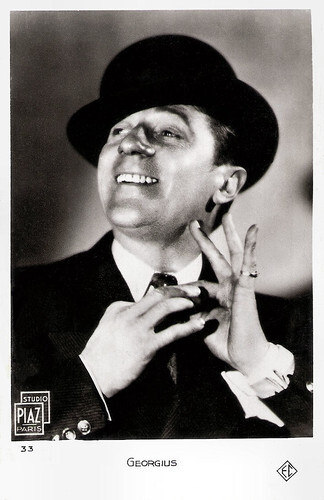
French postcard by EC (Editions Chantal), no. 33. Photo: Studio Piaz, Paris.
A veritable phenomenon of the music hall
Georgius was born Georges Auguste Charles Guibourg in 1891 in Mantes-la-Ville, Yvelines, France. He was the son of Georges Charles Joseph Guibourg, a schoolteacher, editor of the Petit Mantais and then editor-in-chief of the weekly newspaper La France aérienne, and Clémentine Augustine Bouteilly.
He began studying the piano at the age of 11 and at age 16 went to Paris where he performed on stage, singing extracts of traditional operettas and lovesongs. Over the next few years, his various engagements with cabarets progressed. He began to write comic songs.
It was in 1912 that he really began his career as a chansonnier. Called to the Gaîté-Montparnasse theatre to replace a comic singer, his songs were so popular that the theatre signed him a contract for a year; he remained there for three years.
In 1916 he began writing plays, which he then performed with his troupe, Les Joyeux Compagnons, created in 1919. In the 1920s and 1930s, he was a veritable phenomenon of the music hall. His best-known song at the time was 'La Plus Bath des javas', a parody of fashionable javas. He continued to tour and put on revues with his troupe, which was renamed the Théâtre Chantant in 1926.
During this inter-war period, he became one of the most popular singers in Paris, performing at the Moulin Rouge, Bobino, Alhambra Club and the Casino de Paris. 1930 was a great year for him: he released 'La Route de Pen-Zac', which sold more than 160,000 records, a record for the time! The shows followed one another, and everyone rushed to see him.
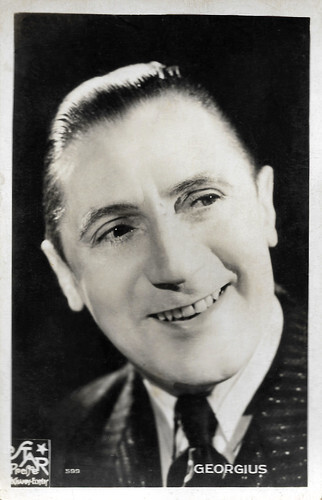
French card by *Star Presse, Paris, no. 595. Photo: *Star.
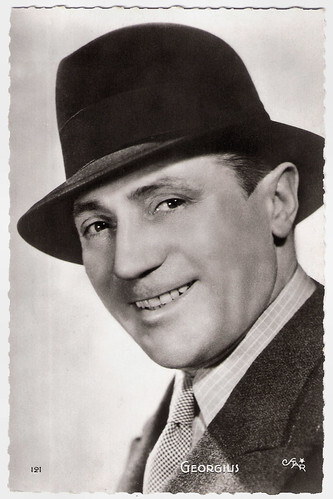
French postcard by Editions P.I., no. 121. Photo: *Star.
More than 1,500 songs, 2,000 sketches, numerous screenplays and a dozen detective novels
Georgius wrote and played the leading role in his film debut, the farce Pas de femmes?/No Women? (Mario Bonnard, 1932) with Aimos and the young Fernandel in a supporting part. He wrote the story for the short Maison hantée/Haunted House (Roger Capellani, 1933) with Monette Dinay and Paulette Dubost .
He co-starred with Dolly Davis in Un train dans la nuit/The Ghost Train (René Hervil, 1934). Throughout the 1930s he appeared in nine escapist comedies. In 1936, he had another success as a singer, with the song 'Au Lycée Papillon', which also broke sales records. It had a verse that is no longer sung today because it was anti-Semitic.
Other hits followed: 'Ca c'est de la bagnole' and 'On ne peut pas plaire à tout le monde'. In 1938 he wrote and performed a comic song against Adolph Hitler:' Il travaille du pinceau' in which he made fun of the house painter (Hitler was a painter in his youth).
He continued his revues during the war. In 1941, he played Sganarelle in Moliere's 'Le Médecin malgré lui' at the Comédie-Française. In 1941 and 1942, he was the artistic director of three theatres: the Théâtre de l'Étoile, the Théâtre Antoine and the Théâtre de l'Ambigu.
After the war, he was banned from the stage for a year by the Comité National d'Épuration du Spectacle. The main reasons were that he had campaigned for the 'Association syndicale des auteurs et compositeurs professionnels' during the Occupation, with the complicity of Alain Laubreaux, and for having staged Laubreaux's play about Stavisky, 'Les Pirates de Paris', in his theatre at the Ambigu. He became a scriptwriter and writer under the pseudonym Jo Barnais. He wrote detective novels as a writer of detective novels for the Série noire.
His final film appearance was in Julien Duvivier's drama Sous le ciel de Paris/Under the Paris Sky (Julien Duvivier, 1951) with Brigitte Auber . He also left the stage in 1951. He was married to Julia Bidault, Marcelle Irvin and Huguette Proye and he had two children. Georgius died in 1970 in Paris, aged 78. He was the author of more than 1,500 songs, 2,000 sketches, numerous screenplays and a dozen detective novels.
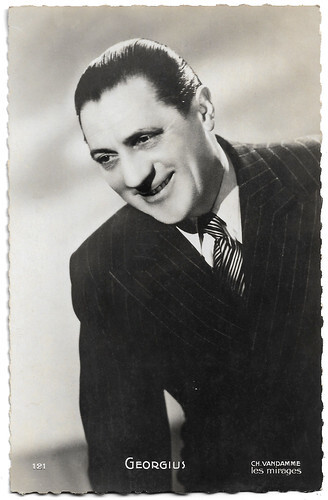
French postcard by Editions P.I., no. 121. Photo: Charles Vandamme, Les Mirages.
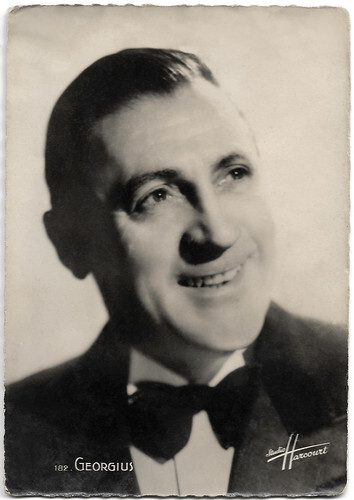
French postcard by Editions S.E.R.P., no. 182. Photo: Studio Harcourt, Paris.
Sources: Jean-Pascal Constantin (Les Gens du Cinéma), Wikipedia (French and English) and .

French postcard by EC (Editions Chantal), no. 33. Photo: Studio Piaz, Paris.
A veritable phenomenon of the music hall
Georgius was born Georges Auguste Charles Guibourg in 1891 in Mantes-la-Ville, Yvelines, France. He was the son of Georges Charles Joseph Guibourg, a schoolteacher, editor of the Petit Mantais and then editor-in-chief of the weekly newspaper La France aérienne, and Clémentine Augustine Bouteilly.
He began studying the piano at the age of 11 and at age 16 went to Paris where he performed on stage, singing extracts of traditional operettas and lovesongs. Over the next few years, his various engagements with cabarets progressed. He began to write comic songs.
It was in 1912 that he really began his career as a chansonnier. Called to the Gaîté-Montparnasse theatre to replace a comic singer, his songs were so popular that the theatre signed him a contract for a year; he remained there for three years.
In 1916 he began writing plays, which he then performed with his troupe, Les Joyeux Compagnons, created in 1919. In the 1920s and 1930s, he was a veritable phenomenon of the music hall. His best-known song at the time was 'La Plus Bath des javas', a parody of fashionable javas. He continued to tour and put on revues with his troupe, which was renamed the Théâtre Chantant in 1926.
During this inter-war period, he became one of the most popular singers in Paris, performing at the Moulin Rouge, Bobino, Alhambra Club and the Casino de Paris. 1930 was a great year for him: he released 'La Route de Pen-Zac', which sold more than 160,000 records, a record for the time! The shows followed one another, and everyone rushed to see him.

French card by *Star Presse, Paris, no. 595. Photo: *Star.

French postcard by Editions P.I., no. 121. Photo: *Star.
More than 1,500 songs, 2,000 sketches, numerous screenplays and a dozen detective novels
Georgius wrote and played the leading role in his film debut, the farce Pas de femmes?/No Women? (Mario Bonnard, 1932) with Aimos and the young Fernandel in a supporting part. He wrote the story for the short Maison hantée/Haunted House (Roger Capellani, 1933) with Monette Dinay and Paulette Dubost .
He co-starred with Dolly Davis in Un train dans la nuit/The Ghost Train (René Hervil, 1934). Throughout the 1930s he appeared in nine escapist comedies. In 1936, he had another success as a singer, with the song 'Au Lycée Papillon', which also broke sales records. It had a verse that is no longer sung today because it was anti-Semitic.
Other hits followed: 'Ca c'est de la bagnole' and 'On ne peut pas plaire à tout le monde'. In 1938 he wrote and performed a comic song against Adolph Hitler:' Il travaille du pinceau' in which he made fun of the house painter (Hitler was a painter in his youth).
He continued his revues during the war. In 1941, he played Sganarelle in Moliere's 'Le Médecin malgré lui' at the Comédie-Française. In 1941 and 1942, he was the artistic director of three theatres: the Théâtre de l'Étoile, the Théâtre Antoine and the Théâtre de l'Ambigu.
After the war, he was banned from the stage for a year by the Comité National d'Épuration du Spectacle. The main reasons were that he had campaigned for the 'Association syndicale des auteurs et compositeurs professionnels' during the Occupation, with the complicity of Alain Laubreaux, and for having staged Laubreaux's play about Stavisky, 'Les Pirates de Paris', in his theatre at the Ambigu. He became a scriptwriter and writer under the pseudonym Jo Barnais. He wrote detective novels as a writer of detective novels for the Série noire.
His final film appearance was in Julien Duvivier's drama Sous le ciel de Paris/Under the Paris Sky (Julien Duvivier, 1951) with Brigitte Auber . He also left the stage in 1951. He was married to Julia Bidault, Marcelle Irvin and Huguette Proye and he had two children. Georgius died in 1970 in Paris, aged 78. He was the author of more than 1,500 songs, 2,000 sketches, numerous screenplays and a dozen detective novels.

French postcard by Editions P.I., no. 121. Photo: Charles Vandamme, Les Mirages.

French postcard by Editions S.E.R.P., no. 182. Photo: Studio Harcourt, Paris.
Sources: Jean-Pascal Constantin (Les Gens du Cinéma), Wikipedia (French and English) and .
Published on April 15, 2023 22:00
April 14, 2023
Robert Stack
American actor Robert Stack (1919-2003) became a star as Deanne Durbin's young lover in Henry Koster's First love (1939). After the war, he had massive success with Douglas Sirk's drama Written on the Wind (1956) for which he was nominated for the Oscar. Internationally, he became famous as Elliot Ness in the TV series The Untouchables (1959-1963).

Vintage card. Photo: Warner Bros.
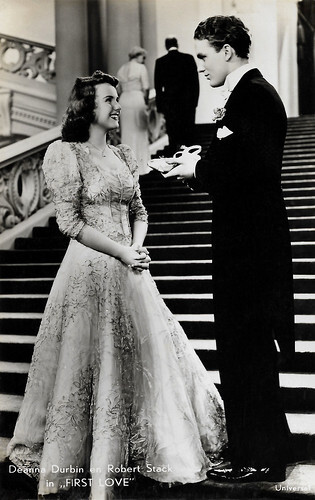
Dutch postcard by M.B. & Z, no. 1040. Photo: Universal. Deanna Durbin and Robert Stack in First Love (Henry Koster, 1939).
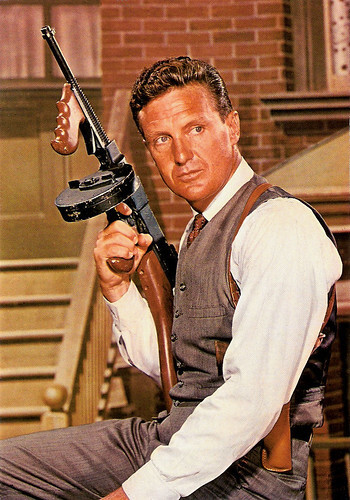
French postcard by E.D.U.G., no. 478. Photo: Robert Stack in The Untouchables (1959-1963).

Vintage postcard.
Giving Deanna Durbin her first on-screen kiss
Robert Stack was born Charles Langford Modini Stack in Los Angeles, in 1919. His first name, selected by his mother, was changed to Robert by his father, a professional soldier. Robert was the grandson of Marina Perrini, an opera singer at the Scala theatre in Milan.
When little Robert was five, his father was transferred to the US embassy in France. Robert went to school in Paris and learnt French rather than his mother tongue. At 11, he returned to America, and at 13, he became a top athlete. His brother and he won the International Outboard Motor Championships, in Venice, Italy, and at age 16, he became a member of the All-American Skeet Team. He played polo, saxophone and clarinet at Southern California University.
A broken wrist ended his career as a sports athlete. He took drama classes and made his stage debut at 20. He joined Universal Studios in 1939. In his first film, he starred as Deanne Durbin 's young lover in First love (Henry Koster, 1939). He gave the teenage film star her first on-screen kiss. Around this "event," Universal producer Joe Pasternak provided a lot of publicity.
Stack established himself as an actor and the following year he appeared as a young Nazi in The Mortal Storm (Frank Borzage, 1940) alongside Margaret Sullavan and James Stewart . Stack was reunited with Durbin in Pasternak's musical Nice Girl? (William A. Seiter, 1941).
In 1942 he appeared as a Polish Air Force pilot in Ernst Lubitsch 's comedy To Be or Not to Be (1942) starring Carole Lombard and Jack Benny. The plot concerns a troupe of actors in Nazi-occupied Warsaw who use their acting abilities to fool the occupying troops. The film has become recognised as a comedy classic. Stack played another pilot in Eagle Squadron (Arthur Lubin, 1942), a huge hit. Then Stack's career was interrupted by military service. He did duty as a gunnery instructor in the United States Navy during World War II.
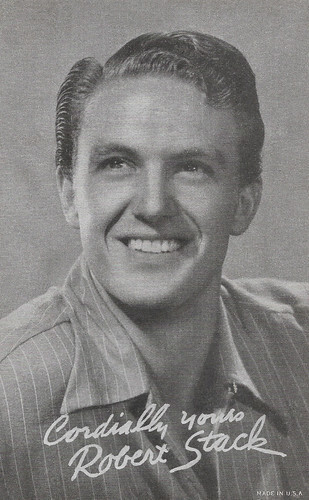
American Arcade card.
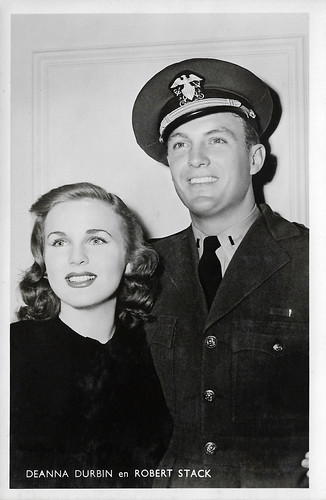
Dutch postcard. Deanna Durbin and Robert Stack in Nice Girl? (William A. Seiter, 1941).

American postcard by Godfrey Herbert, The World Explorer, 1941. Photo: Universal Pictures.
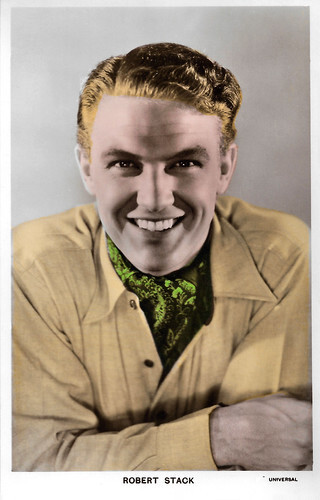
British postcard in the Colourgraph Series, London, no. C 401. Photo: Universal.
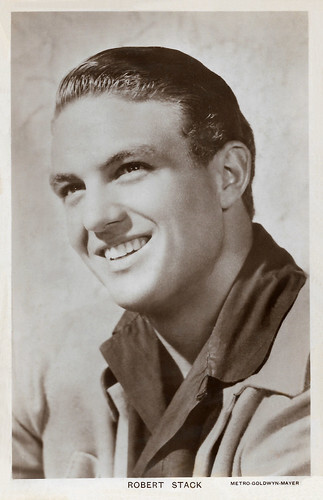
British postcard in the Picturegoer Series, London, no. 1 1435. Photo: Metro-Goldwyn-Mayer (MGM).
Clean-cut Chicago police officer Eliot Ness
After World War II, Robert Stack continued his career. He returned to the screen with roles in films such as Fighter Squadron (Raoul Walsh, 1948) with Edmond O'Brien and A Date with Judy (Richard Thorpe, 1948) with Elizabeth Taylor .
In 1952 Stack starred in Bwana Devil (Arch Oboler, 1952), the first major film production in 3D. He played the second leading role alongside John Wayne in William A. Wellman's aviation drama It's Always Day (1954). Sam Fuller cast him in the lead of House of Bamboo (1955), shot in Japan.
Stack enjoyed one of his greatest successes with Douglas Sirk's drama Written in the Wind (1956). He received an Oscar nomination for Best Supporting Actor for his portrayal of the alcoholic playboy Kyle Hadley. From the late 1950s Stack turned increasingly to television. Internationally, Robert became famous with his role in the television series The Untouchables in which he starred as the clean-cut Chicago police officer Eliot Ness during the Prohibition era. Around 120 episodes were made between 1959 and 1963.
Other leading roles followed for Stack in the television series The Name of the Game (1968-1971), Most Wanted (1976) and Strike Force (1981). The multilingual Stack also took the lead role in the German-language film Die Hölle von Macao/The Hell of Macau (James Hill, 1966) alongside Elke Sommer , and he also appeared in French- or Italian-language productions.
With advancing age, Stack also frequently took on deadpan comedy roles that lampooned his dramatic on-screen persona in films such as 1941 (Steven Spielberg, 1979), Airplane! (Jim Abrahams, David Zucker, Jerry Zucker, 1980) or Caddyshack II (Allan Arkush, 1988). Between 1987 and 2002 he was the host of the television series Unsolved Mysteries, which was dedicated to mysterious murder cases. He worked as an actor until his death. In 1956 he married actress Rosemarie Bowe (1932-2019), to whom he was married until the end of his life. The couple had two children. Robert Stack died of pneumonia in 2003 in Beverly Hills at the age of 84 and was buried in Westwood Village Memorial Park Cemetery.
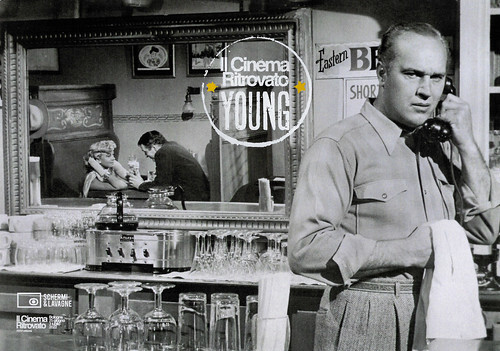
Big programme card by Cineteca Bologna for Il Cinema Ritrovato, XXXVI edizione, Selezione Cinema Ritrovato Young, 25 June 2022. Dorothy Malone and Robert Stack in Written on the Wind (Douglas Sirk, 1956)
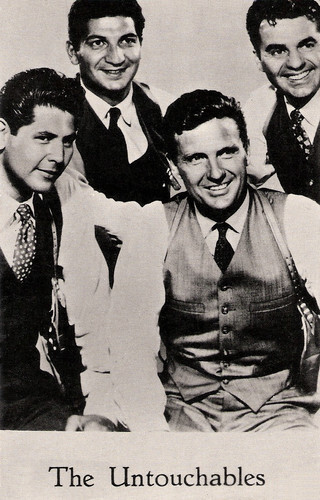
Vintage postcard. Abel Fernandez (left) as William Youngfellow, Nicholas Georgiade as Enrico Rossi, Robert Stack as Elliot Ness and Paul Picerni as Lee Hobson in the TV series The Untouchables (1959-1963).
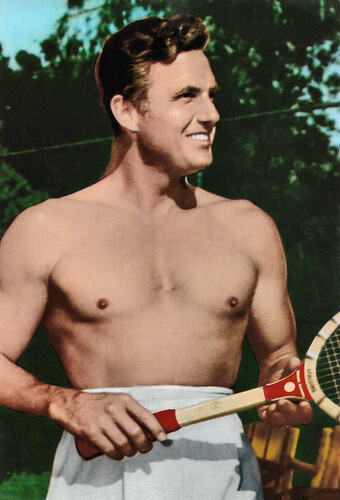
Spanish postcard by Raker, no. 1148, 1965.
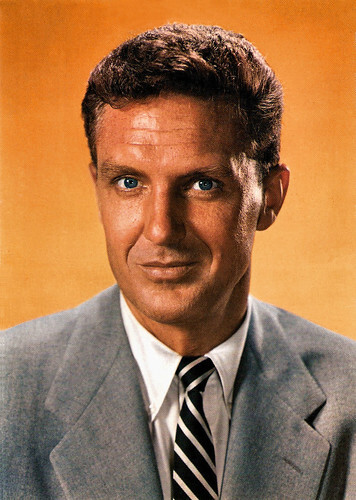
French postcard by E.D.U.G., no. 485. Photo: Atlantic-Press. Publicity still for The Untouchables (1959-1963).
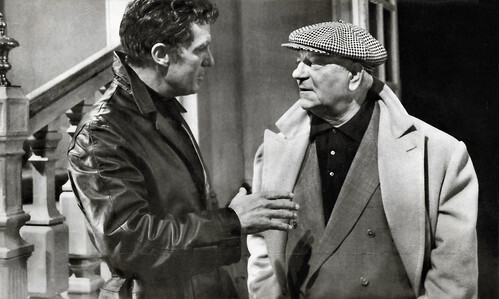
Romanian postcard by Casa Filmului Acin, no. 366. Robert Stack and Jean Gabin in Le Soleil des Voyous/Action Man (Jean Delannoy, 1967).
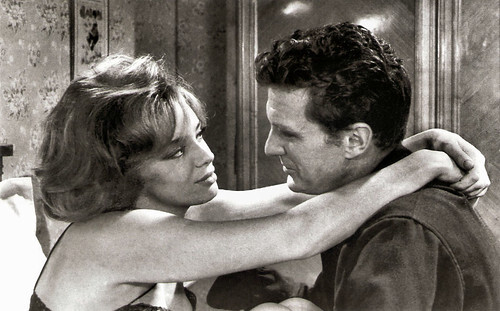
Romanian postcard by Casa Filmului Acin. Margaret Lee and Robert Stack in Le soleil des voyous/Action Man (Jean Delannoy, 1967).
Sources: Wikipedia (Dutch, German and English) and .

Vintage card. Photo: Warner Bros.

Dutch postcard by M.B. & Z, no. 1040. Photo: Universal. Deanna Durbin and Robert Stack in First Love (Henry Koster, 1939).

French postcard by E.D.U.G., no. 478. Photo: Robert Stack in The Untouchables (1959-1963).

Vintage postcard.
Giving Deanna Durbin her first on-screen kiss
Robert Stack was born Charles Langford Modini Stack in Los Angeles, in 1919. His first name, selected by his mother, was changed to Robert by his father, a professional soldier. Robert was the grandson of Marina Perrini, an opera singer at the Scala theatre in Milan.
When little Robert was five, his father was transferred to the US embassy in France. Robert went to school in Paris and learnt French rather than his mother tongue. At 11, he returned to America, and at 13, he became a top athlete. His brother and he won the International Outboard Motor Championships, in Venice, Italy, and at age 16, he became a member of the All-American Skeet Team. He played polo, saxophone and clarinet at Southern California University.
A broken wrist ended his career as a sports athlete. He took drama classes and made his stage debut at 20. He joined Universal Studios in 1939. In his first film, he starred as Deanne Durbin 's young lover in First love (Henry Koster, 1939). He gave the teenage film star her first on-screen kiss. Around this "event," Universal producer Joe Pasternak provided a lot of publicity.
Stack established himself as an actor and the following year he appeared as a young Nazi in The Mortal Storm (Frank Borzage, 1940) alongside Margaret Sullavan and James Stewart . Stack was reunited with Durbin in Pasternak's musical Nice Girl? (William A. Seiter, 1941).
In 1942 he appeared as a Polish Air Force pilot in Ernst Lubitsch 's comedy To Be or Not to Be (1942) starring Carole Lombard and Jack Benny. The plot concerns a troupe of actors in Nazi-occupied Warsaw who use their acting abilities to fool the occupying troops. The film has become recognised as a comedy classic. Stack played another pilot in Eagle Squadron (Arthur Lubin, 1942), a huge hit. Then Stack's career was interrupted by military service. He did duty as a gunnery instructor in the United States Navy during World War II.

American Arcade card.

Dutch postcard. Deanna Durbin and Robert Stack in Nice Girl? (William A. Seiter, 1941).

American postcard by Godfrey Herbert, The World Explorer, 1941. Photo: Universal Pictures.

British postcard in the Colourgraph Series, London, no. C 401. Photo: Universal.

British postcard in the Picturegoer Series, London, no. 1 1435. Photo: Metro-Goldwyn-Mayer (MGM).
Clean-cut Chicago police officer Eliot Ness
After World War II, Robert Stack continued his career. He returned to the screen with roles in films such as Fighter Squadron (Raoul Walsh, 1948) with Edmond O'Brien and A Date with Judy (Richard Thorpe, 1948) with Elizabeth Taylor .
In 1952 Stack starred in Bwana Devil (Arch Oboler, 1952), the first major film production in 3D. He played the second leading role alongside John Wayne in William A. Wellman's aviation drama It's Always Day (1954). Sam Fuller cast him in the lead of House of Bamboo (1955), shot in Japan.
Stack enjoyed one of his greatest successes with Douglas Sirk's drama Written in the Wind (1956). He received an Oscar nomination for Best Supporting Actor for his portrayal of the alcoholic playboy Kyle Hadley. From the late 1950s Stack turned increasingly to television. Internationally, Robert became famous with his role in the television series The Untouchables in which he starred as the clean-cut Chicago police officer Eliot Ness during the Prohibition era. Around 120 episodes were made between 1959 and 1963.
Other leading roles followed for Stack in the television series The Name of the Game (1968-1971), Most Wanted (1976) and Strike Force (1981). The multilingual Stack also took the lead role in the German-language film Die Hölle von Macao/The Hell of Macau (James Hill, 1966) alongside Elke Sommer , and he also appeared in French- or Italian-language productions.
With advancing age, Stack also frequently took on deadpan comedy roles that lampooned his dramatic on-screen persona in films such as 1941 (Steven Spielberg, 1979), Airplane! (Jim Abrahams, David Zucker, Jerry Zucker, 1980) or Caddyshack II (Allan Arkush, 1988). Between 1987 and 2002 he was the host of the television series Unsolved Mysteries, which was dedicated to mysterious murder cases. He worked as an actor until his death. In 1956 he married actress Rosemarie Bowe (1932-2019), to whom he was married until the end of his life. The couple had two children. Robert Stack died of pneumonia in 2003 in Beverly Hills at the age of 84 and was buried in Westwood Village Memorial Park Cemetery.

Big programme card by Cineteca Bologna for Il Cinema Ritrovato, XXXVI edizione, Selezione Cinema Ritrovato Young, 25 June 2022. Dorothy Malone and Robert Stack in Written on the Wind (Douglas Sirk, 1956)

Vintage postcard. Abel Fernandez (left) as William Youngfellow, Nicholas Georgiade as Enrico Rossi, Robert Stack as Elliot Ness and Paul Picerni as Lee Hobson in the TV series The Untouchables (1959-1963).

Spanish postcard by Raker, no. 1148, 1965.

French postcard by E.D.U.G., no. 485. Photo: Atlantic-Press. Publicity still for The Untouchables (1959-1963).

Romanian postcard by Casa Filmului Acin, no. 366. Robert Stack and Jean Gabin in Le Soleil des Voyous/Action Man (Jean Delannoy, 1967).

Romanian postcard by Casa Filmului Acin. Margaret Lee and Robert Stack in Le soleil des voyous/Action Man (Jean Delannoy, 1967).
Sources: Wikipedia (Dutch, German and English) and .
Published on April 14, 2023 22:00
April 13, 2023
Renate Mannhardt
Renate Mannhardt (1920-2013) was a German supporting actress of the 1950s. She was known for such films as Peter Lorre's Der Verlorene (1951), Die große Schuld/The great debt (1953) and Roberto Rossellini's Non credo più all'amore (La paura)/Fear (1954).
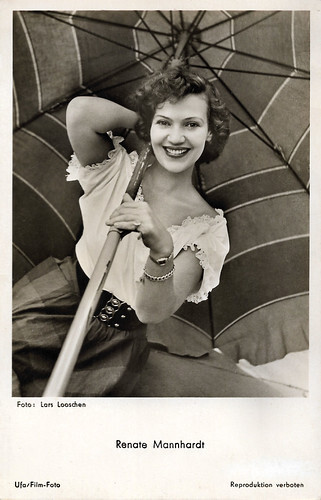
West German postcard by Ufa/Film-Foto, Berlin-Tempelhof, no. FK 909. Photo: Lars Looschen.
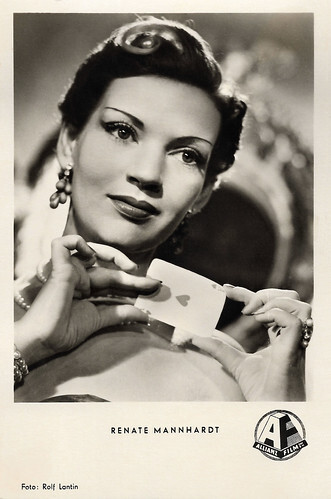
West German postcard by Kunst und Bild, Berlin, no. A 723. Photo: Rolf Lantin / Meteor / Allianz Film. Renate Mannhardt in Käpt'n Bay-Bay/Captain Bay-Bay (Helmut Käutner, 1953).
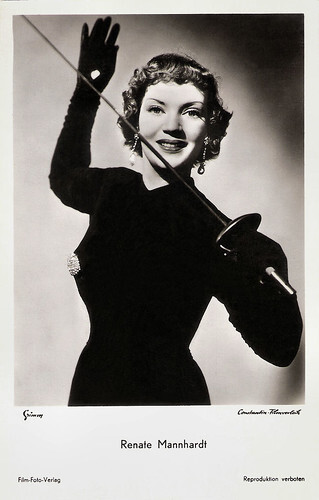
West German postcard by Film-Foto-Verlag, Berlin-Tempelhof, no. Fk 242. Photo: Arthur Grimm / Constantin-Filmverleih / Algefa Film. Renate Mannhardt in Der keusche Josef/The Chaste Joseph (Carl Boese, 1953).
Film debut as an exotic dancer
Renate Mannhardt was born Hanna Renate Kohlschein in 1920 in Barmen, Germany. She was the daughter of a lawyer and publisher.
Renate took private acting lessons. She made her film debut as an exotic dancer in the romance Auf Wiedersehn, Franziska!/Goodbye, Franziska (Helmut Käutner, 1941) starring Marianne Hoppe and Hans Söhnker .
In the summer of 1943, she received her first engagement at the Königshütte theatre.
After the war, she performed with the Münchner Kammerspielen and at the Komödienhaus in Berlin.
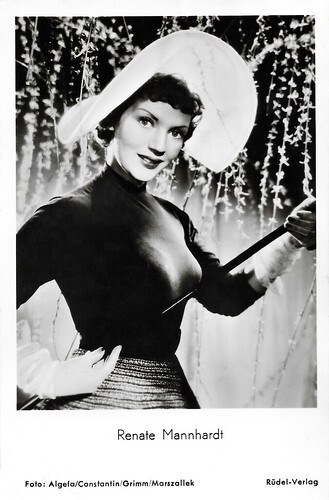
West German postcard by Rüdel-Verlag, Hamburg-Bergedorf, no. 623. Photo: Algefa / Constantin-Filmverleih / Arthur Grimm / Marszalek. Renate Mannhardt in Der keusche Josef/The Chaste Joseph (Carl Boese, 1953).
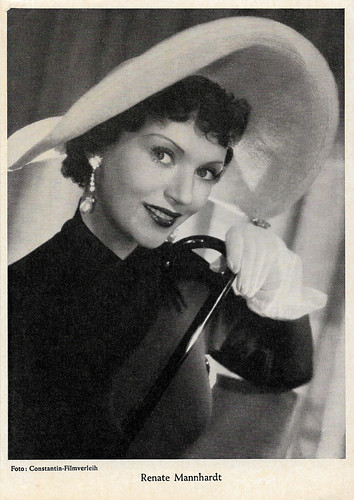
German collectors card by Helmstedter Margarinewerk GMBH, Helmstedt. Photo: Constantin-Filmverleih. Renate Mannhardt in Der keusche Josef/The chaste Josef (Carl Boese, 1953). Gift by Didier Hanson.
The ill-fated fiancée of a German scientist
In the cinema, Renate Mannhardt played several key roles in post-war films, perhaps best known as the ill-fated fiancée of a German scientist ( Peter Lorre ), who is murdered by him during the Second World War when he learns that she has been selling his secret research to the enemy in Der Verlorene/The Lost Man (Peter Lorre, 1951).
She also appeared opposite Ingrid Bergman in the German-Italian film Non credo più all'amore (La paura)/Angst/Fear (Roberto Rossellini, 1954).
In the drama Die Ehe des Dr. med. Danwitz/Marriage of Dr. Danwitz (Arthur Maria Rabenalt, 1956), she played a laboratory assistant.
In 1956, she met an American business consultant, whom she married and went to the United States. Before ending her film career, she appeared in a few more American and German films and TV shows.
Renate Mannhardt died in 2013 in New York City, New York, USA, at 92. She had a son named Christian (1942).
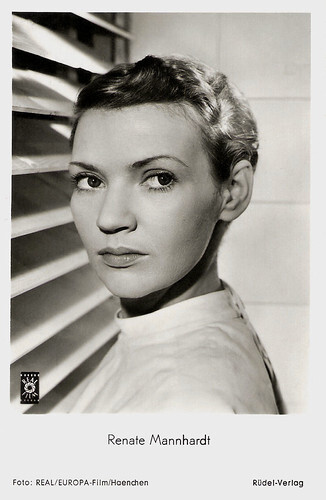
German postcard by Rüdel-Verlag, Hamburg-Bergedorf, no. 1635. Photo: Real / Europa-Film / Haenchen. Renate Mannhardt in Die Ehe des Dr. med. Danwitz/Marriage of Dr. Danwitz (Arthur Maria Rabenalt, 1956).
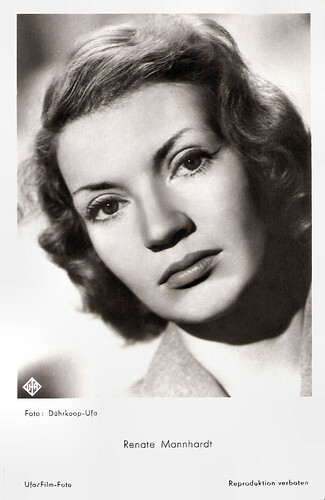
West German postcard by Ufa/Film-Foto, Berlin-Tempelhof, no. FK 3327. Photo: Dührkoop / Ufa.
Sources: Wikipedia (German and English) and .

West German postcard by Ufa/Film-Foto, Berlin-Tempelhof, no. FK 909. Photo: Lars Looschen.

West German postcard by Kunst und Bild, Berlin, no. A 723. Photo: Rolf Lantin / Meteor / Allianz Film. Renate Mannhardt in Käpt'n Bay-Bay/Captain Bay-Bay (Helmut Käutner, 1953).

West German postcard by Film-Foto-Verlag, Berlin-Tempelhof, no. Fk 242. Photo: Arthur Grimm / Constantin-Filmverleih / Algefa Film. Renate Mannhardt in Der keusche Josef/The Chaste Joseph (Carl Boese, 1953).
Film debut as an exotic dancer
Renate Mannhardt was born Hanna Renate Kohlschein in 1920 in Barmen, Germany. She was the daughter of a lawyer and publisher.
Renate took private acting lessons. She made her film debut as an exotic dancer in the romance Auf Wiedersehn, Franziska!/Goodbye, Franziska (Helmut Käutner, 1941) starring Marianne Hoppe and Hans Söhnker .
In the summer of 1943, she received her first engagement at the Königshütte theatre.
After the war, she performed with the Münchner Kammerspielen and at the Komödienhaus in Berlin.

West German postcard by Rüdel-Verlag, Hamburg-Bergedorf, no. 623. Photo: Algefa / Constantin-Filmverleih / Arthur Grimm / Marszalek. Renate Mannhardt in Der keusche Josef/The Chaste Joseph (Carl Boese, 1953).

German collectors card by Helmstedter Margarinewerk GMBH, Helmstedt. Photo: Constantin-Filmverleih. Renate Mannhardt in Der keusche Josef/The chaste Josef (Carl Boese, 1953). Gift by Didier Hanson.
The ill-fated fiancée of a German scientist
In the cinema, Renate Mannhardt played several key roles in post-war films, perhaps best known as the ill-fated fiancée of a German scientist ( Peter Lorre ), who is murdered by him during the Second World War when he learns that she has been selling his secret research to the enemy in Der Verlorene/The Lost Man (Peter Lorre, 1951).
She also appeared opposite Ingrid Bergman in the German-Italian film Non credo più all'amore (La paura)/Angst/Fear (Roberto Rossellini, 1954).
In the drama Die Ehe des Dr. med. Danwitz/Marriage of Dr. Danwitz (Arthur Maria Rabenalt, 1956), she played a laboratory assistant.
In 1956, she met an American business consultant, whom she married and went to the United States. Before ending her film career, she appeared in a few more American and German films and TV shows.
Renate Mannhardt died in 2013 in New York City, New York, USA, at 92. She had a son named Christian (1942).

German postcard by Rüdel-Verlag, Hamburg-Bergedorf, no. 1635. Photo: Real / Europa-Film / Haenchen. Renate Mannhardt in Die Ehe des Dr. med. Danwitz/Marriage of Dr. Danwitz (Arthur Maria Rabenalt, 1956).

West German postcard by Ufa/Film-Foto, Berlin-Tempelhof, no. FK 3327. Photo: Dührkoop / Ufa.
Sources: Wikipedia (German and English) and .
Published on April 13, 2023 22:00
April 12, 2023
Spanish minicards for five early Italian films
Ivo Blom loves to collect vintage minicards from Spain which depict early Italian films. We did already post on minicards of diva films with Francesca Bertini and another with Pina Menichelli. This post is more eclectic and shows minicards of five Italian films from 1914 and 1915 made for various studios and with different actors. Even the publishers of the cards differ.
L’ammazone masscherata (1914)
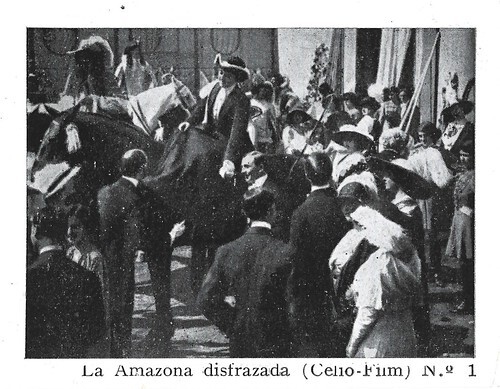
Spanish collectors card by Reclam Film, Mallorca, Card 1 of 6. Photo: Celio Film. Francesca Bertini and Alberto Collo in L'amazzone mascherata/The Woman Who Dared (Baldassarre Negroni, 1914). The Spanish release title was La Amazona disfrazada.
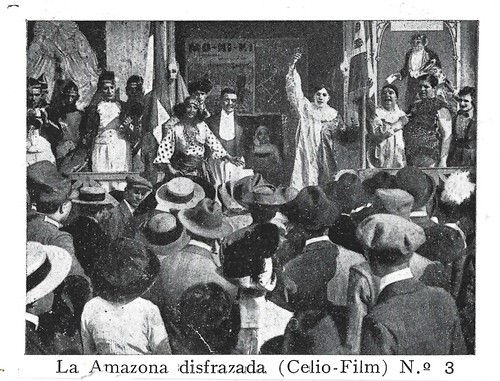
Spanish collectors card by Reclam Film, Mallorca, Card 3 of 6. Photo: Celio Film. Leda Gys (the coloured woman with the black curls in the back) in L'amazzone mascherata/The Woman Who Dared (Baldassarre Negroni, 1914). The moment of this card lacks in the existing film print.
Disguised as The Masked Amazon
Countess Franca de Roberti ( Francesca Bertini ), the toast of high society, plans a charity fete with herself as a splendid rider at the travelling circus Sterosky. The louche circus manager Jean Sterosky ( Emilio Ghione ), however, is a spy, who with his aid, the coloured girl Nadia ( Leda Gys ), spies for the neighbouring country Silistria. Knowing that Franca's husband, Count Albert ( Alberto Collo ), is in possession of precious military documents, they lure him to a restaurant and drug him.
Sterosky steals secret mobilisation documents on the cavalry plans from Albert's safe in his house and delivers these to the prime minister of the hostile power, for a huge award. That night, Franca is a huge success as a rider at the circus, but the next day Albert discovers the plans are gone from his safe. He meets his general to communicate the loss. Albert is arrested and sentenced to two years in prison. Countess Franca is prostrated by her husband's disgrace, but confident of his innocence sets herself to find evidence which will set him free. A button with the initials J.S., found by her servant Alexis (Amedeo Ciaffi), leads her to suspect that Sterosky is the real thief of the plans. She looks for help from her lawyer (Angelo Gallina) but he is powerless, so she takes things into her own hands.
Disguised as The Masked Amazon, Franca joins the circus and soon becomes a sensation, including in Silistria, even if remaining a mystery to anyone but her butler Alexis. He locates Sterosky's divorced wife, Nadia, and from her they learn that the spy is in the city, living the high life thanks to the payment for his theft. Several days, from his box at the hippodrome, Sterosky is struck with the grace of the masked rider and asks for an introduction, which is granted.
The countess, never taking off her mask, leads him on until he invites her to take dinner in his room. She accepts, and as they are dining suddenly removes her mask and covers him with a revolver. She forces him to give her the plans and his correspondence with the Silistrian officials and is delighted to find that the papers prove her husband's innocence. Still covering Sterosky with the pistol, she makes her escape from the house. In her haste, she drops one of the documents, but Alexis, whom she has left on guard at the door, picks it up and jams it into his pocket.
Now that she has the precious proofs, the countess loses no time in leaving the Silistrian capital. Sterosky, however, has not lost his presence of mind and succeeds in getting a warrant for her arrest. He charters a high-powered motor car and starts for the border at top speed. There is an exciting race between his machine and the train which bears the countess. The auto wins, and when the daring woman reaches the frontier, Sterosky and a squad of the military police are waiting for her at the border station. The papers are taken from her and she is hustled across the border into her own country. She returns heartbroken to her home. Several days later, Alexis, who has followed on another train, arrives and gives her the paper which she dropped in fleeing from Sterosky's house. It proves to be a letter from the prime minister of Silistria to the spy and conclusively proves the innocence of the count. This letter turned over to the military authorities, wins a pardon for Albert and brings back happiness to the woman who dared.
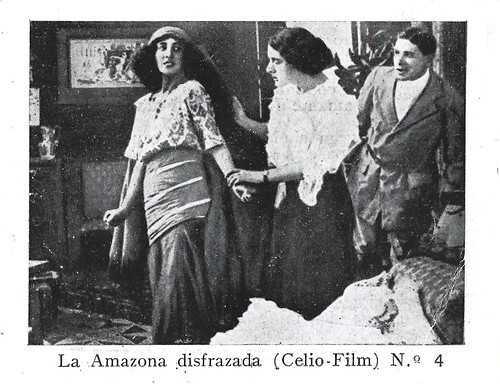
Spanish collectors card by Reclam Film, Mallorca, Card 4 of 6. Photo: Celio Film. Francesca Bertini , Leda Gys and Amedeo Ciaffi in L'amazzone mascherata/The Woman Who Dared (Baldassarre Negroni, 1914). The moment of this card lacks in the existing film print.
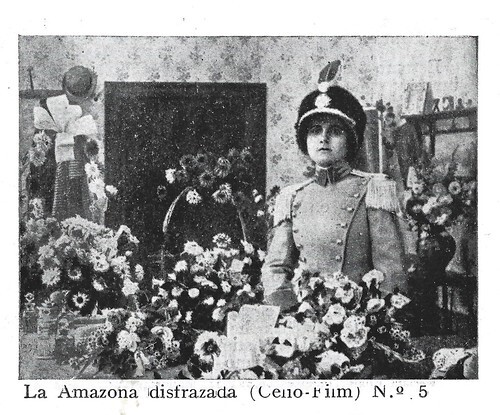
Spanish collectors card by Reclam Film, Mallorca, Card 5 of 6. Photo: Celio Film. Francesca Bertini in L'amazzone mascherata/The Woman Who Dared (Baldassarre Negroni, 1914).
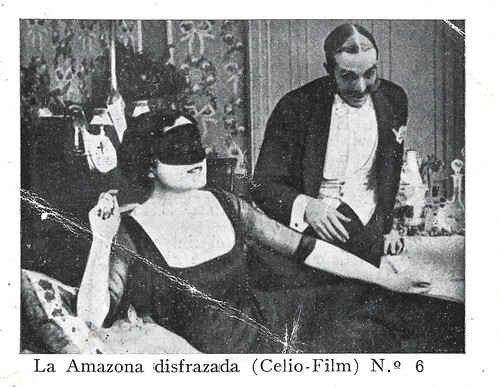
Spanish collectors card by Reclam Film, Mallorca, Card 6 of 6. Photo: Celio Film. Francesca Bertini and Emilio Ghione in L'amazzone mascherata/The Woman Who Dared (Baldassarre Negroni, 1914).
Nelly la gigolette (1915)
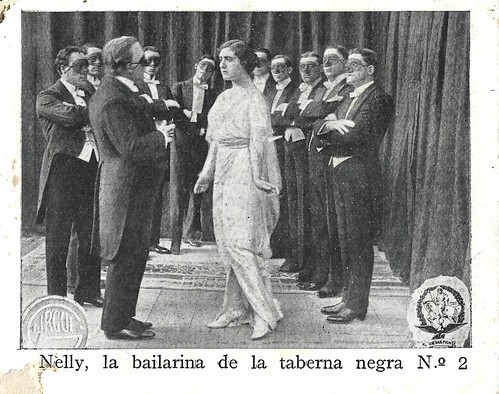
Spanish collectors card by Reclam Film, Mallorca, Card 2 of 6. Photo: Caesar Film / Urgui. Francesca Bertini in Nelly la gigolette (Emilio Ghione, 1915). The Spanish release title was Nelly, la bailarina de la taberna negra.
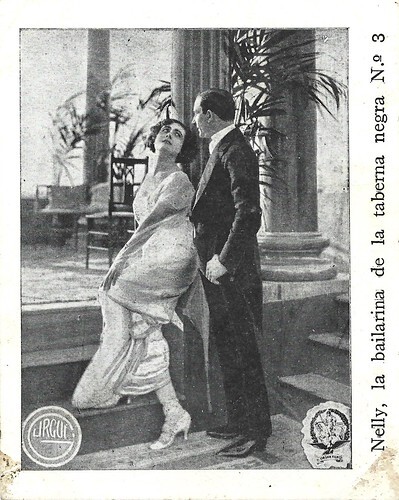
Spanish collectors card by Reclam Film, Mallorca, Card 3 of 6. Photo: Caesar Film / Urgui. Francesca Bertini and Alberto Collo in Nelly la gigolette (Emilio Ghione, 1915).
Revenge with equal, yet feminine cruelty
Francesca Bertini plays Nelly, the dancer of the Black Tavern (the alternative title of the film). She is the girl, the gigolette, of the Apache Zar-la-Mort ( Emilio Ghione ), a notorious man of the Parisian underworld.
Nelly is forced by him to seduce the rich banker Albert (Alberto Collo), so that Zar can rob him of everything. Yet, Nelly falls in love with Albert, confesses the crime and repairs the wronging, fleeing with Albert to America.
But even there they cannot escape the wrath of Zar, who tracks them down, kills Albert and forces Nelly to return with him to Paris. With equal, yet feminine cruelty, Nelly will take revenge...
Allan Kardec wrote in L'Alba cinematografica : "Her every muscle quivers and vibrates in the revelation of her soul: it is enough to watch her movements for even the most layman to understand the feelings that animate the character."
Despite serious cuts by the Italian censor, the film was an enormous success and caused Ghione to make a whole series of films on Za-la-Mort (now with one -r less). The film had its Roman premiere on 5 January 1915. It was Bertini's first film at Caesar Film. Unfortunately, as far as we know, Nelly la gigolette is a lost film.
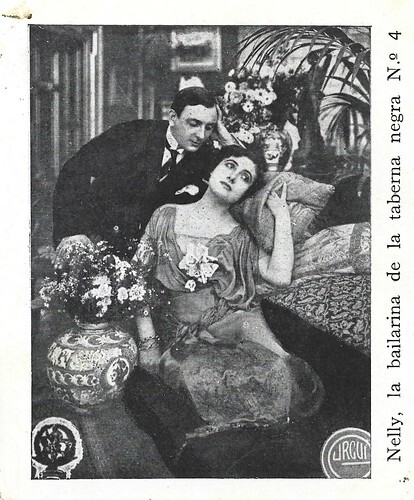
Spanish collectors card by Reclam Film, Mallorca, Card 4 of 6. Photo: Caesar Film / Urgui. Francesca Bertini and Alberto Collo in Nelly la gigolette (Emilio Ghione, 1915).
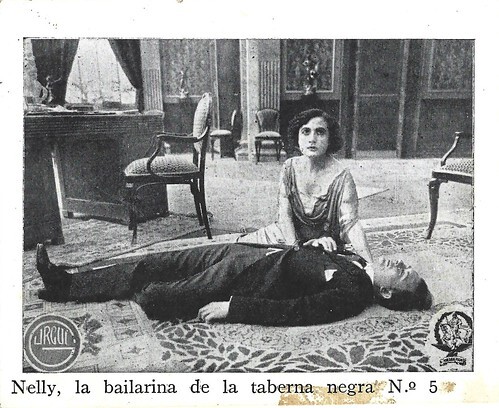
Spanish collectors card by Reclam Film, Mallorca, Card 5 of 6. Photo: Caesar Film / Urgui. Francesca Bertini in Nelly la gigolette (Emilio Ghione, 1915). The man could be Alberto Collo .
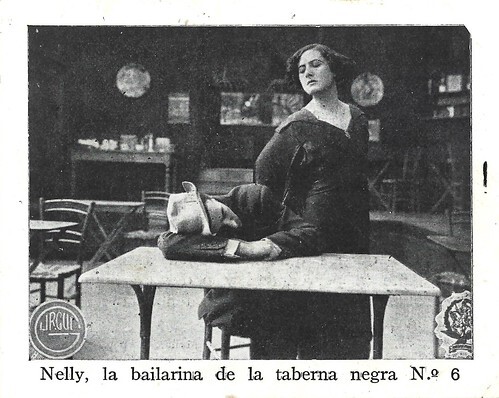
Spanish collectors card by Reclam Film, Mallorca, Card 6 of 6. Photo: Caesar Film / Urgui. Francesca Bertini in Nelly la gigolette (Emilio Ghione, 1915). The man could be Alberto Collo .
Nerone e Agrippina (1914)
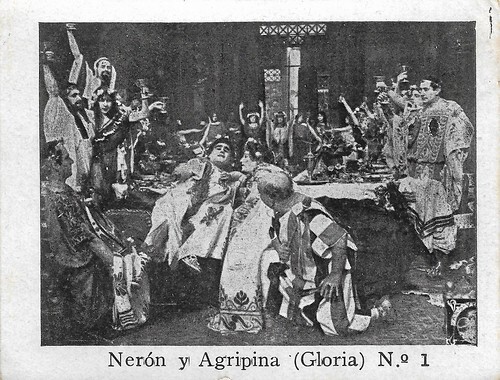
Spanish collectors card by Reclam Films, Mallorca, card 1 of 6. Photo: Gloria Film. Nerone e Agrippina (Mario Caserini, 1914), starring Vittorio Rossi Pianelli as Nerone and Maria Caserini as Agrippina. Nero's banquet.
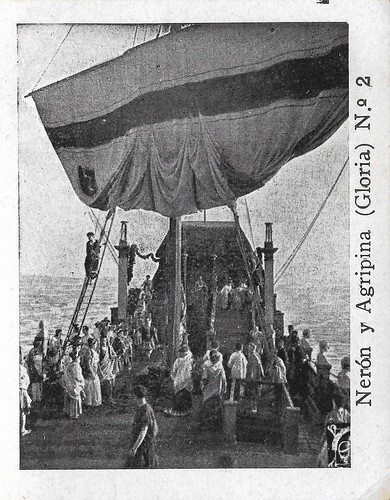
Spanish collectors card by Reclam Films, Mallorca, card 2 of 6. Photo: Gloria Film. Nerone e Agrippina (Mario Caserini, 1914), starring Vittorio Rossi Pianelli as Nerone and Maria Caserini as Agrippina. The first attempt to murder Agrippina at the instigation of Nero happens on a ship, but she survives, to the great anger of her son.
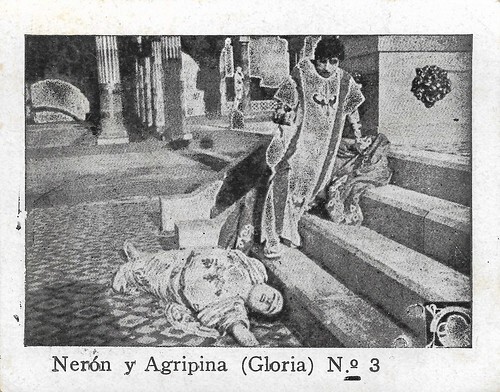
Spanish collectors card by Reclam Films, Mallorca, card 3 of 6. Photo: Gloria Film. Nerone e Agrippina (Mario Caserini, 1914), starring Vittorio Rossi Pianelli as Nerone and Maria Caserini as his dead mother, Agrippina.
When a disastrous fire destroys Rome in 64 A.D.
Claudius (Emilio Petacci), having succeeded Caligula who was assassinated by the Praetorians, recalls Agrippina (Maria Caserini), his niece, from exile and she begins to plot to make her son Nero (Vittorio Rossi Pianelli) emperor. She has Messalina killed, then seduces her uncle into marrying her and appoints Nero as heir instead of his son Britannicus (Gian Paolo Rosmino). Claudius dies of poisoning and Nero becomes emperor, but Agrippina pretends to dictate to him as well and threatens to put Brittanicus on the throne. Nero therefore first poisons Brittanicus and then has Agrippina killed herself by Tigelinus (Dante Cappelli). Nero then begins to show increasing signs of mental derangement.
Because of this, many, including the philosopher Seneca (Telemaco Ruggeri), think to get rid of him, but Nero discovers the conspiracy and forces him to commit suicide. When a disastrous fire destroys Rome in 64 A.D., the people blame Nero, who, instigated by Poppaea (Lydia De Roberti), reacts by pointing to the Christians as the culprits and begins the persecution into which St Paul also falls. During a feast, Nero kills Poppaea, who is pregnant and goes completely mad. The reconstruction of burnt-out Rome resulted in the construction of the Domus Aurea. After another four years, the army, tired of Nero's follies, revolts: Galba marches on Rome and proclaims himself emperor. Nero flees to the places of his youth, where he finds Actae (Fernanda Sinimberghi), whom he loved in his youth and who is now a Christian and is killed by a former slave.
Nerone e Agrippina/Nero and Agrippina (Mario Caserini, 1914) was produced by Gloria Film as a result of a decision by which the Turin-based company renounced a new version of The Last Days of Pompeii (Eleuterio Rodolfi, 1913), which it had announced it would make since April 1913, using 10 lions, 50 horses, 1,000 extras, with scenes from life at the foot of Vesuvius and for a final product of 3,000 metres of film. This decision was caused by the fact that two competing companies - Ambrosio and Pasquali - had both distributed their own film version of Bulwer-Lytton's novel, opening a season of court cases and heated polemics and accusations of the 'indecent and unfair collaboration' that characterised the film industry at that time.
Gloria, which at that very time was reaping the worldwide success decreed to the first diva film Ma l'amor mio non muore (Mario Caserini, 1913) with Lyda Borelli , decided to escape these dynamics. However, several scenes had already been shot in the Arena di Verona, the use of which had been obtained following a generous donation to the Congregazione di Carità del Comune scaligero. Given the importance and commitment of the filming, which began at the end of October 1913 and was entrusted to two cameramen, the Turin-based company had lined up its entire artistic staff, both by flanking two expert directors such as Alberto Degli Abbati and Giuseppe de Liguoro under the direction of Mario Caserini and by employing the entire team of actors and actresses at its disposal. The scenes already filmed in Verona were then reused for a new 'Kolossal' that was, in fact, Nero and Agrippina. Other scenes were realised in the winter of 1913 at the studio that Gloria had taken over in Pegli (at that time still an autonomous municipality with respect to Genoa), in order to make use of the best climatic and lighting conditions existing near the sea. A pier was built on the beach of the seaside resort and two triremes were equipped for the scene of Agrippina's embarkation. The scenes of the burning of Rome were instead realised near Turin with specially erected constructions.
Even with regard to the new film, divided into 10 parts and partly inspired by Boito's Nerone, Gloria announced that it had wanted to do things on a grand scale, employing "more than 100 first-rate artists, a troop of male & female slaves, circus scenes and nautical festivals, imperial villas and palaces and splendid costumes". Nor did the production effort fail at the film's distribution stage, as the film was accompanied by 'colourfully painted posters, 72 medium-format stills, 30 large-format 60 x 80s, a colour illustrated booklet and two musical scores, one for small and the other for large orchestras'. This rush to the productive effort of the Italian film industry - which was to enter a crisis a few months later due to the outbreak of war - was criticised by those who claimed that "until two years ago with 2-300,000 lire one could still open a good film studio, while today half a million is spent on a single film [such as] 'Gloria', whose Nerone has so far cost 400,000 Francs."
Nero and Agrippina was presented on 20 March 1914 at the 'Borsa' cinema in Turin in a private viewing reserved for dignitaries, intellectuals, also from abroad, and with members of the Savoy royal family in attendance, receiving much applause at the end of each part. There were the premises for a new international success for Gloria' which concluded "at a very high price" an agreement with Pathé for the distribution of the film in the USA, Canada, Belgium, the Netherlands, France, Switzerland, Turkey and non-Austrian Balkan countries, while in Germany and Great Britain plus relative colonies distribution was direct. But the film's progress was first overshadowed by the release, only two weeks later, of Cabiria and, a few months later, by the outbreak of war, which effectively blocked international trade. Meanwhile, with Caserini's departure, Gloria Film had also entered a waning phase. In the face of the substantial production investment, therefore, Nero and Agrippina was considered a commercial failure.
The few commentaries available provide enthusiastic descriptions of the film, so much so that one critic of the time wrote of "a film so perfect that it eludes true critical examination. Everything is carefully studied and meticulously executed: [it is] a masterpiece that begins its triumphant 'tour' around the world'. Even the British periodical, The Bioscope, called it 'a masterpiece' on 16 April 1914. Believed to be lost for a long time, Nero and Agrippina was fortunately found again in July 1999 by some Italian scholars who were carrying out research at the "Norsk Film Institute" in Oslo, to whom we also owe the subsequent restoration of the remaining 1,850 metres of the film (around 84 minutes) compared to the original 2,000. NB Many sources list Caserini as director or co-director of the 1913 Ambrosio version of Gli ultimi giorni di Pompei (Eleuterio Rodolfi, 1913), but this is a stubborn error which keeps popping up.
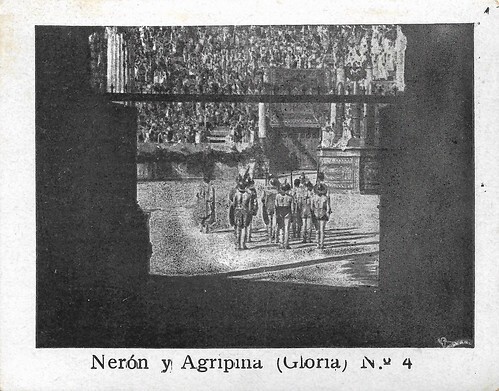
Spanish collectors card by Reclam Films, Mallorca, card 4 of 6. Photo: Gloria Film. Nerone e Agrippina (Mario Caserini, 1914), starring Vittorio Rossi Pianelli as Nerone and Maria Caserini as Agrippina. The gladiators enter the arena, greeting the emperor: "Ave Caesar, morituri te salutant" (Greetings, Caesar, those who are about to die, salute you).
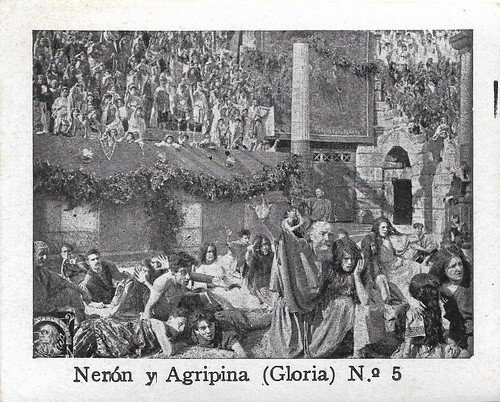
Spanish collectors card by Reclam Films, Mallorca, card 5 of 6. Photo: Gloria Film. Nerone e Agrippina (Mario Caserini, 1914), starring Vittorio Rossi Pianelli as Nerone and Maria Caserini as Agrippina. Persecution of the Christians in the arena.
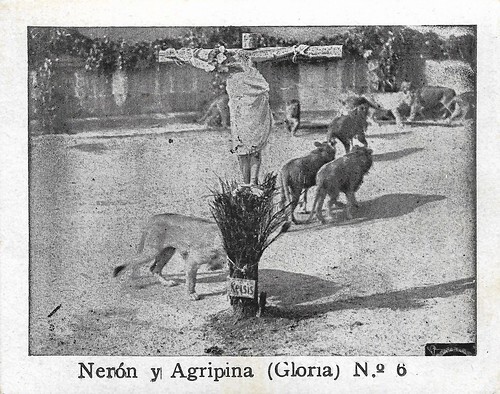
Spanish collectors card by Reclam Films, Mallorca, card 6 of 6. Photo: Gloria Film. Nerone e Agrippina (Mario Caserini, 1914), starring Vittorio Rossi Pianelli as Nerone and Maria Caserini as Agrippina. Persecution of the Christians in the arena.
Il rubino del destino (1914)
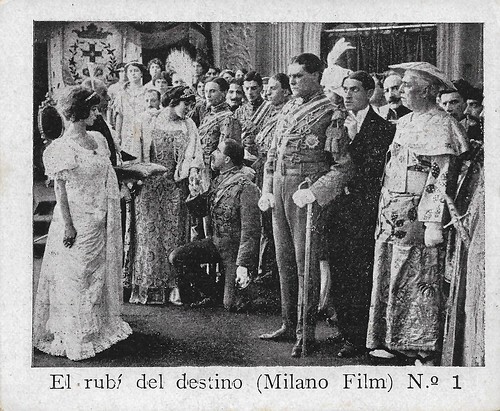
Spanish collectors card (minicard) by Chocolate Amatller, Barcelona, no. 1 of 6. Photo: Milano Films. Mercedes Brignone , Franz Sala and Livio Pavanelli in Il rubino del destino/The Ruby of Destiny (Henri Étiévant, 1914), scripted by Augusto Genina. The film was released in Spain as El rubí del destino in January 1914.
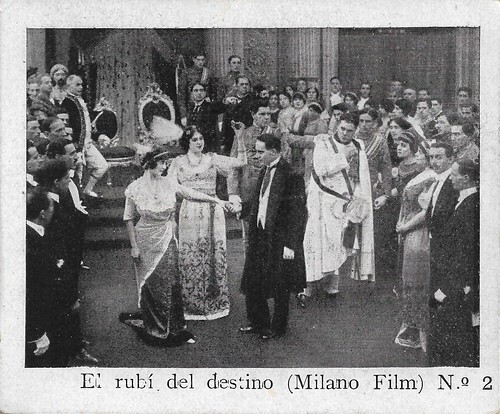
Spanish collectors card (minicard) by Chocolate Amatller, Barcelona, no. 2 of 6. Photo: Milano Films. Mercedes Brignone and Livio Pavanelli in Il rubino del destino/The Ruby of Destiny (Henri Étiévant, 1914), scripted by Augusto Genina.
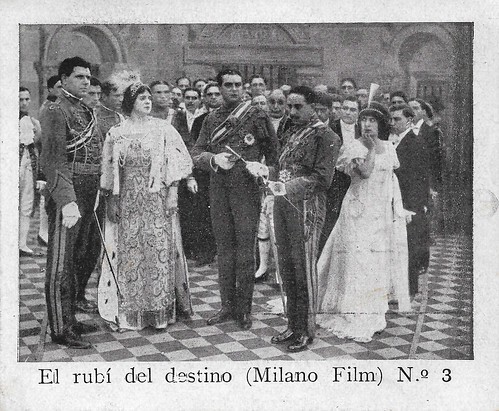
Spanish collectors card (minicard) by Chocolate Amatller, Barcelona, no. 3 of 6. Photo: Milano Films. Mercedes Brignone , Franz Sala and Livio Pavanelli in Il rubino del destino/The Ruby of Destiny (Henri Étiévant, 1914), scripted by Augusto Genina.
A legendary ruby that protects the royal bloodline
When King Constantine dies, his daughter Luise becomes Queen of Styr. She appoints Lieutenant Eric ( Livio Pavanelli ) as her personal guard. Luise is in love with the handsome lieutenant but doesn't know he instead loves her sister Luitza ( Mercedes Brignone ).
Count Tiarko ( Franz Sala ), also in love with Luitza, tries with all means to separate Luitza and Eric. He orders his crony Walton to steal a ruby that according to an old legend protects the royal bloodline, and places the guilt on Eric.
The Queen, unsuspecting, orders Tiarko to find the ruby and promises her sister's hand in return. Eric is condemned to death but Luitza manages to let him escape. Eric moves to Milan, where Tiarko has hidden the jewel, but where it is stolen from him by the adventuress Paola (Thea Sandten). After many more troubles, Tiarko will perish and Eric and Luitza can marry.
Sources disagree about who's who in this film. In his credit list Vittorio Martinelli, in Il cinema muto italiano, Vol. 1914, part 2, conflates the two sisters into one Queen Luitza played by Brignone. Our cards seem to contest that the queen is played by Brignone, but the low resolution of the card doesn't help in identifying Brignone as the sister.
IMDb claims Pavanelli played Styr, the investigator, but the kingdom is named Styr. Yet, the man in civilian clothes demonstrating the found ruby may well be a detective. One of our cards even suggests it is he who gets the hand of the sister in the end, and not the lieutenant, in contrast to the plot given above.
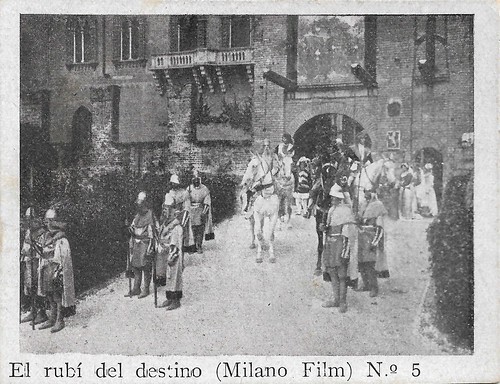
Spanish collectors card (minicard) by Chocolate Amatller, Barcelona, no. 5 of 6. Photo: Milano Films. Scene from Il rubino del destino/The Ruby of Destiny (Henri Étiévant, 1914), scripted by Augusto Genina.
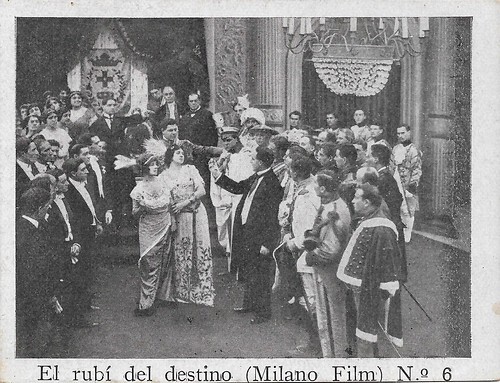
Spanish collectors card (minicard) by Chocolate Amatller, Barcelona, no. 6 of 6. Photo: Milano Films. Mercedes Brignone and Livio Pavanelli in Il rubino del destino/The Ruby of Destiny (Henri Étiévant, 1914), scripted by Augusto Genina.
Amore e cospirazione (1915)
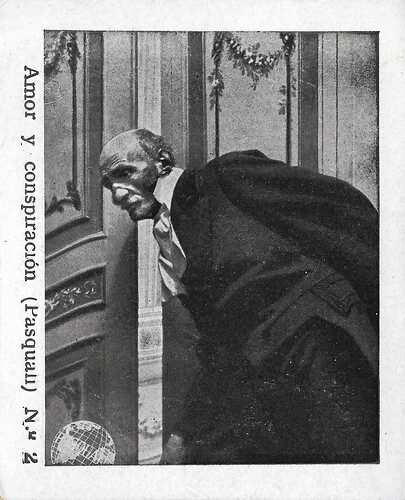
Spanish collectors card (minicard) by Reclam Films, Mallorca, no. 2 of 6. Photo: Pasquali Films. Scene from Amore e cospirazione (Enrico Vidali, 1915). One of the servants overhears a conversation.
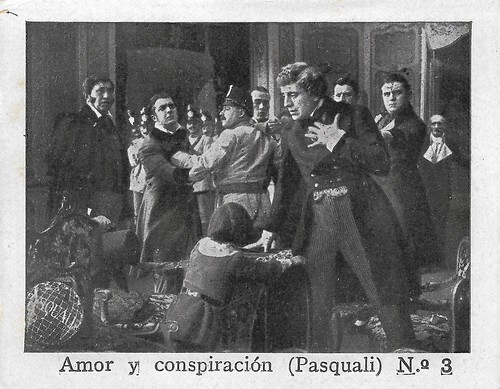
Spanish collectors card (minicard) by Reclam Films, Mallorca, no. 3 of 6. Photo: Pasquali Films. Scene from Amore e cospirazione (Enrico Vidali, 1915). The man right in the foreground is Alberto Capozzi , looking guilty while kneeling on his side is Maria Gandini. The man on the extreme left is director Enrico Vidali himself.
The Italian press thought this film quite outdated
Little is known about the plot of Amore e cospirazione (1915) by Enrico Vidali, but it is clear there is a conflict between the fight against the Austrian oppressor and the love of a man and a woman and this is set during the Italian Risorgimento.
While Vidali and Maria Gandini had been protagonists of the popular Pasquali version of Gli ultimi giorni di Pompei/The Last Days of Pompeii (Eleuterio Rodolfi, 1913), Alberto Capozzi had been an enormous star at Ambrosio in the early 1910s. However, by 1915 the Italian press thought this film quite outdated and claimed the audience thought so too.
Yet, during the First World War, many historical films were made in Italy that boosted the war morale against Austria, e.g. Emilio Ghione 's films for Tiber Film, such as Guglielmo Oberdan, il martire di Trieste/Guglielmo Oberdan, the martyr of Trieste (Emilio Ghione, 1916).
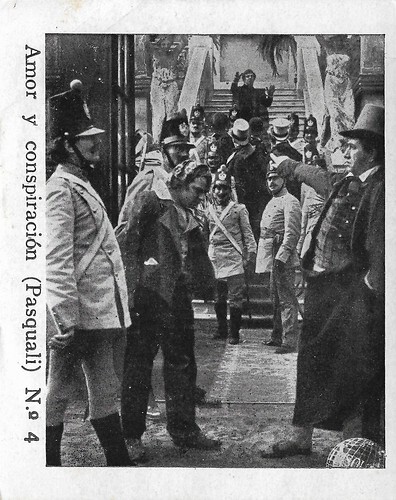
Spanish collectors card (minicard) by Reclam Films, Mallorca, no. 4 of 6. Photo: Pasquali Films. Scene from Amore e cospirazione (Enrico Vidali, 1915). On the right, Enrico Vidali is the evil antagonist, working for the Austrian occupying army, and ordering an arrest.
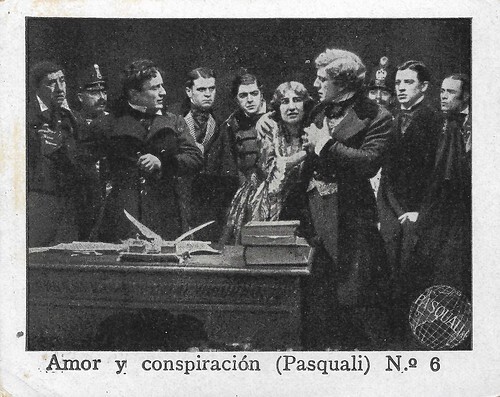
Spanish collectors card (minicard) by Reclam Films, Mallorca, no. 6 of 6. Photo: Pasquali Films. Scene from Amore e cospirazione (Enrico Vidali, 1915). On the right are the two main actors: Alberto Capozzi embracing Maria Gandini. On the extreme left is Enrico Vidali.
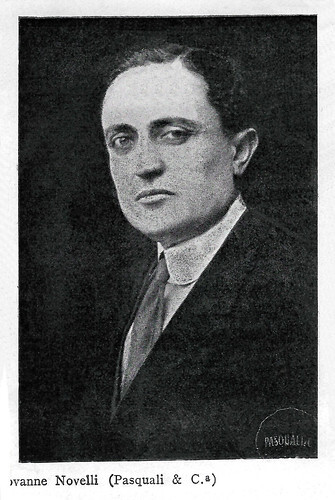
Spanish minicard. Photo: Pasquali & Cie. Giovanni Enrico Vidali, here presented as Giovanni Novelli.
Sources: Vittorio Martinelli (Gianfranco Mingozzi, 'Francesca Bertini'), Vittorio Martinelli (Il cinema muto italiano, Vol. 1914, part 2), and IMDb.
L’ammazone masscherata (1914)

Spanish collectors card by Reclam Film, Mallorca, Card 1 of 6. Photo: Celio Film. Francesca Bertini and Alberto Collo in L'amazzone mascherata/The Woman Who Dared (Baldassarre Negroni, 1914). The Spanish release title was La Amazona disfrazada.

Spanish collectors card by Reclam Film, Mallorca, Card 3 of 6. Photo: Celio Film. Leda Gys (the coloured woman with the black curls in the back) in L'amazzone mascherata/The Woman Who Dared (Baldassarre Negroni, 1914). The moment of this card lacks in the existing film print.
Disguised as The Masked Amazon
Countess Franca de Roberti ( Francesca Bertini ), the toast of high society, plans a charity fete with herself as a splendid rider at the travelling circus Sterosky. The louche circus manager Jean Sterosky ( Emilio Ghione ), however, is a spy, who with his aid, the coloured girl Nadia ( Leda Gys ), spies for the neighbouring country Silistria. Knowing that Franca's husband, Count Albert ( Alberto Collo ), is in possession of precious military documents, they lure him to a restaurant and drug him.
Sterosky steals secret mobilisation documents on the cavalry plans from Albert's safe in his house and delivers these to the prime minister of the hostile power, for a huge award. That night, Franca is a huge success as a rider at the circus, but the next day Albert discovers the plans are gone from his safe. He meets his general to communicate the loss. Albert is arrested and sentenced to two years in prison. Countess Franca is prostrated by her husband's disgrace, but confident of his innocence sets herself to find evidence which will set him free. A button with the initials J.S., found by her servant Alexis (Amedeo Ciaffi), leads her to suspect that Sterosky is the real thief of the plans. She looks for help from her lawyer (Angelo Gallina) but he is powerless, so she takes things into her own hands.
Disguised as The Masked Amazon, Franca joins the circus and soon becomes a sensation, including in Silistria, even if remaining a mystery to anyone but her butler Alexis. He locates Sterosky's divorced wife, Nadia, and from her they learn that the spy is in the city, living the high life thanks to the payment for his theft. Several days, from his box at the hippodrome, Sterosky is struck with the grace of the masked rider and asks for an introduction, which is granted.
The countess, never taking off her mask, leads him on until he invites her to take dinner in his room. She accepts, and as they are dining suddenly removes her mask and covers him with a revolver. She forces him to give her the plans and his correspondence with the Silistrian officials and is delighted to find that the papers prove her husband's innocence. Still covering Sterosky with the pistol, she makes her escape from the house. In her haste, she drops one of the documents, but Alexis, whom she has left on guard at the door, picks it up and jams it into his pocket.
Now that she has the precious proofs, the countess loses no time in leaving the Silistrian capital. Sterosky, however, has not lost his presence of mind and succeeds in getting a warrant for her arrest. He charters a high-powered motor car and starts for the border at top speed. There is an exciting race between his machine and the train which bears the countess. The auto wins, and when the daring woman reaches the frontier, Sterosky and a squad of the military police are waiting for her at the border station. The papers are taken from her and she is hustled across the border into her own country. She returns heartbroken to her home. Several days later, Alexis, who has followed on another train, arrives and gives her the paper which she dropped in fleeing from Sterosky's house. It proves to be a letter from the prime minister of Silistria to the spy and conclusively proves the innocence of the count. This letter turned over to the military authorities, wins a pardon for Albert and brings back happiness to the woman who dared.

Spanish collectors card by Reclam Film, Mallorca, Card 4 of 6. Photo: Celio Film. Francesca Bertini , Leda Gys and Amedeo Ciaffi in L'amazzone mascherata/The Woman Who Dared (Baldassarre Negroni, 1914). The moment of this card lacks in the existing film print.

Spanish collectors card by Reclam Film, Mallorca, Card 5 of 6. Photo: Celio Film. Francesca Bertini in L'amazzone mascherata/The Woman Who Dared (Baldassarre Negroni, 1914).

Spanish collectors card by Reclam Film, Mallorca, Card 6 of 6. Photo: Celio Film. Francesca Bertini and Emilio Ghione in L'amazzone mascherata/The Woman Who Dared (Baldassarre Negroni, 1914).
Nelly la gigolette (1915)

Spanish collectors card by Reclam Film, Mallorca, Card 2 of 6. Photo: Caesar Film / Urgui. Francesca Bertini in Nelly la gigolette (Emilio Ghione, 1915). The Spanish release title was Nelly, la bailarina de la taberna negra.

Spanish collectors card by Reclam Film, Mallorca, Card 3 of 6. Photo: Caesar Film / Urgui. Francesca Bertini and Alberto Collo in Nelly la gigolette (Emilio Ghione, 1915).
Revenge with equal, yet feminine cruelty
Francesca Bertini plays Nelly, the dancer of the Black Tavern (the alternative title of the film). She is the girl, the gigolette, of the Apache Zar-la-Mort ( Emilio Ghione ), a notorious man of the Parisian underworld.
Nelly is forced by him to seduce the rich banker Albert (Alberto Collo), so that Zar can rob him of everything. Yet, Nelly falls in love with Albert, confesses the crime and repairs the wronging, fleeing with Albert to America.
But even there they cannot escape the wrath of Zar, who tracks them down, kills Albert and forces Nelly to return with him to Paris. With equal, yet feminine cruelty, Nelly will take revenge...
Allan Kardec wrote in L'Alba cinematografica : "Her every muscle quivers and vibrates in the revelation of her soul: it is enough to watch her movements for even the most layman to understand the feelings that animate the character."
Despite serious cuts by the Italian censor, the film was an enormous success and caused Ghione to make a whole series of films on Za-la-Mort (now with one -r less). The film had its Roman premiere on 5 January 1915. It was Bertini's first film at Caesar Film. Unfortunately, as far as we know, Nelly la gigolette is a lost film.

Spanish collectors card by Reclam Film, Mallorca, Card 4 of 6. Photo: Caesar Film / Urgui. Francesca Bertini and Alberto Collo in Nelly la gigolette (Emilio Ghione, 1915).

Spanish collectors card by Reclam Film, Mallorca, Card 5 of 6. Photo: Caesar Film / Urgui. Francesca Bertini in Nelly la gigolette (Emilio Ghione, 1915). The man could be Alberto Collo .

Spanish collectors card by Reclam Film, Mallorca, Card 6 of 6. Photo: Caesar Film / Urgui. Francesca Bertini in Nelly la gigolette (Emilio Ghione, 1915). The man could be Alberto Collo .
Nerone e Agrippina (1914)

Spanish collectors card by Reclam Films, Mallorca, card 1 of 6. Photo: Gloria Film. Nerone e Agrippina (Mario Caserini, 1914), starring Vittorio Rossi Pianelli as Nerone and Maria Caserini as Agrippina. Nero's banquet.

Spanish collectors card by Reclam Films, Mallorca, card 2 of 6. Photo: Gloria Film. Nerone e Agrippina (Mario Caserini, 1914), starring Vittorio Rossi Pianelli as Nerone and Maria Caserini as Agrippina. The first attempt to murder Agrippina at the instigation of Nero happens on a ship, but she survives, to the great anger of her son.

Spanish collectors card by Reclam Films, Mallorca, card 3 of 6. Photo: Gloria Film. Nerone e Agrippina (Mario Caserini, 1914), starring Vittorio Rossi Pianelli as Nerone and Maria Caserini as his dead mother, Agrippina.
When a disastrous fire destroys Rome in 64 A.D.
Claudius (Emilio Petacci), having succeeded Caligula who was assassinated by the Praetorians, recalls Agrippina (Maria Caserini), his niece, from exile and she begins to plot to make her son Nero (Vittorio Rossi Pianelli) emperor. She has Messalina killed, then seduces her uncle into marrying her and appoints Nero as heir instead of his son Britannicus (Gian Paolo Rosmino). Claudius dies of poisoning and Nero becomes emperor, but Agrippina pretends to dictate to him as well and threatens to put Brittanicus on the throne. Nero therefore first poisons Brittanicus and then has Agrippina killed herself by Tigelinus (Dante Cappelli). Nero then begins to show increasing signs of mental derangement.
Because of this, many, including the philosopher Seneca (Telemaco Ruggeri), think to get rid of him, but Nero discovers the conspiracy and forces him to commit suicide. When a disastrous fire destroys Rome in 64 A.D., the people blame Nero, who, instigated by Poppaea (Lydia De Roberti), reacts by pointing to the Christians as the culprits and begins the persecution into which St Paul also falls. During a feast, Nero kills Poppaea, who is pregnant and goes completely mad. The reconstruction of burnt-out Rome resulted in the construction of the Domus Aurea. After another four years, the army, tired of Nero's follies, revolts: Galba marches on Rome and proclaims himself emperor. Nero flees to the places of his youth, where he finds Actae (Fernanda Sinimberghi), whom he loved in his youth and who is now a Christian and is killed by a former slave.
Nerone e Agrippina/Nero and Agrippina (Mario Caserini, 1914) was produced by Gloria Film as a result of a decision by which the Turin-based company renounced a new version of The Last Days of Pompeii (Eleuterio Rodolfi, 1913), which it had announced it would make since April 1913, using 10 lions, 50 horses, 1,000 extras, with scenes from life at the foot of Vesuvius and for a final product of 3,000 metres of film. This decision was caused by the fact that two competing companies - Ambrosio and Pasquali - had both distributed their own film version of Bulwer-Lytton's novel, opening a season of court cases and heated polemics and accusations of the 'indecent and unfair collaboration' that characterised the film industry at that time.
Gloria, which at that very time was reaping the worldwide success decreed to the first diva film Ma l'amor mio non muore (Mario Caserini, 1913) with Lyda Borelli , decided to escape these dynamics. However, several scenes had already been shot in the Arena di Verona, the use of which had been obtained following a generous donation to the Congregazione di Carità del Comune scaligero. Given the importance and commitment of the filming, which began at the end of October 1913 and was entrusted to two cameramen, the Turin-based company had lined up its entire artistic staff, both by flanking two expert directors such as Alberto Degli Abbati and Giuseppe de Liguoro under the direction of Mario Caserini and by employing the entire team of actors and actresses at its disposal. The scenes already filmed in Verona were then reused for a new 'Kolossal' that was, in fact, Nero and Agrippina. Other scenes were realised in the winter of 1913 at the studio that Gloria had taken over in Pegli (at that time still an autonomous municipality with respect to Genoa), in order to make use of the best climatic and lighting conditions existing near the sea. A pier was built on the beach of the seaside resort and two triremes were equipped for the scene of Agrippina's embarkation. The scenes of the burning of Rome were instead realised near Turin with specially erected constructions.
Even with regard to the new film, divided into 10 parts and partly inspired by Boito's Nerone, Gloria announced that it had wanted to do things on a grand scale, employing "more than 100 first-rate artists, a troop of male & female slaves, circus scenes and nautical festivals, imperial villas and palaces and splendid costumes". Nor did the production effort fail at the film's distribution stage, as the film was accompanied by 'colourfully painted posters, 72 medium-format stills, 30 large-format 60 x 80s, a colour illustrated booklet and two musical scores, one for small and the other for large orchestras'. This rush to the productive effort of the Italian film industry - which was to enter a crisis a few months later due to the outbreak of war - was criticised by those who claimed that "until two years ago with 2-300,000 lire one could still open a good film studio, while today half a million is spent on a single film [such as] 'Gloria', whose Nerone has so far cost 400,000 Francs."
Nero and Agrippina was presented on 20 March 1914 at the 'Borsa' cinema in Turin in a private viewing reserved for dignitaries, intellectuals, also from abroad, and with members of the Savoy royal family in attendance, receiving much applause at the end of each part. There were the premises for a new international success for Gloria' which concluded "at a very high price" an agreement with Pathé for the distribution of the film in the USA, Canada, Belgium, the Netherlands, France, Switzerland, Turkey and non-Austrian Balkan countries, while in Germany and Great Britain plus relative colonies distribution was direct. But the film's progress was first overshadowed by the release, only two weeks later, of Cabiria and, a few months later, by the outbreak of war, which effectively blocked international trade. Meanwhile, with Caserini's departure, Gloria Film had also entered a waning phase. In the face of the substantial production investment, therefore, Nero and Agrippina was considered a commercial failure.
The few commentaries available provide enthusiastic descriptions of the film, so much so that one critic of the time wrote of "a film so perfect that it eludes true critical examination. Everything is carefully studied and meticulously executed: [it is] a masterpiece that begins its triumphant 'tour' around the world'. Even the British periodical, The Bioscope, called it 'a masterpiece' on 16 April 1914. Believed to be lost for a long time, Nero and Agrippina was fortunately found again in July 1999 by some Italian scholars who were carrying out research at the "Norsk Film Institute" in Oslo, to whom we also owe the subsequent restoration of the remaining 1,850 metres of the film (around 84 minutes) compared to the original 2,000. NB Many sources list Caserini as director or co-director of the 1913 Ambrosio version of Gli ultimi giorni di Pompei (Eleuterio Rodolfi, 1913), but this is a stubborn error which keeps popping up.

Spanish collectors card by Reclam Films, Mallorca, card 4 of 6. Photo: Gloria Film. Nerone e Agrippina (Mario Caserini, 1914), starring Vittorio Rossi Pianelli as Nerone and Maria Caserini as Agrippina. The gladiators enter the arena, greeting the emperor: "Ave Caesar, morituri te salutant" (Greetings, Caesar, those who are about to die, salute you).

Spanish collectors card by Reclam Films, Mallorca, card 5 of 6. Photo: Gloria Film. Nerone e Agrippina (Mario Caserini, 1914), starring Vittorio Rossi Pianelli as Nerone and Maria Caserini as Agrippina. Persecution of the Christians in the arena.

Spanish collectors card by Reclam Films, Mallorca, card 6 of 6. Photo: Gloria Film. Nerone e Agrippina (Mario Caserini, 1914), starring Vittorio Rossi Pianelli as Nerone and Maria Caserini as Agrippina. Persecution of the Christians in the arena.
Il rubino del destino (1914)

Spanish collectors card (minicard) by Chocolate Amatller, Barcelona, no. 1 of 6. Photo: Milano Films. Mercedes Brignone , Franz Sala and Livio Pavanelli in Il rubino del destino/The Ruby of Destiny (Henri Étiévant, 1914), scripted by Augusto Genina. The film was released in Spain as El rubí del destino in January 1914.

Spanish collectors card (minicard) by Chocolate Amatller, Barcelona, no. 2 of 6. Photo: Milano Films. Mercedes Brignone and Livio Pavanelli in Il rubino del destino/The Ruby of Destiny (Henri Étiévant, 1914), scripted by Augusto Genina.

Spanish collectors card (minicard) by Chocolate Amatller, Barcelona, no. 3 of 6. Photo: Milano Films. Mercedes Brignone , Franz Sala and Livio Pavanelli in Il rubino del destino/The Ruby of Destiny (Henri Étiévant, 1914), scripted by Augusto Genina.
A legendary ruby that protects the royal bloodline
When King Constantine dies, his daughter Luise becomes Queen of Styr. She appoints Lieutenant Eric ( Livio Pavanelli ) as her personal guard. Luise is in love with the handsome lieutenant but doesn't know he instead loves her sister Luitza ( Mercedes Brignone ).
Count Tiarko ( Franz Sala ), also in love with Luitza, tries with all means to separate Luitza and Eric. He orders his crony Walton to steal a ruby that according to an old legend protects the royal bloodline, and places the guilt on Eric.
The Queen, unsuspecting, orders Tiarko to find the ruby and promises her sister's hand in return. Eric is condemned to death but Luitza manages to let him escape. Eric moves to Milan, where Tiarko has hidden the jewel, but where it is stolen from him by the adventuress Paola (Thea Sandten). After many more troubles, Tiarko will perish and Eric and Luitza can marry.
Sources disagree about who's who in this film. In his credit list Vittorio Martinelli, in Il cinema muto italiano, Vol. 1914, part 2, conflates the two sisters into one Queen Luitza played by Brignone. Our cards seem to contest that the queen is played by Brignone, but the low resolution of the card doesn't help in identifying Brignone as the sister.
IMDb claims Pavanelli played Styr, the investigator, but the kingdom is named Styr. Yet, the man in civilian clothes demonstrating the found ruby may well be a detective. One of our cards even suggests it is he who gets the hand of the sister in the end, and not the lieutenant, in contrast to the plot given above.

Spanish collectors card (minicard) by Chocolate Amatller, Barcelona, no. 5 of 6. Photo: Milano Films. Scene from Il rubino del destino/The Ruby of Destiny (Henri Étiévant, 1914), scripted by Augusto Genina.

Spanish collectors card (minicard) by Chocolate Amatller, Barcelona, no. 6 of 6. Photo: Milano Films. Mercedes Brignone and Livio Pavanelli in Il rubino del destino/The Ruby of Destiny (Henri Étiévant, 1914), scripted by Augusto Genina.
Amore e cospirazione (1915)

Spanish collectors card (minicard) by Reclam Films, Mallorca, no. 2 of 6. Photo: Pasquali Films. Scene from Amore e cospirazione (Enrico Vidali, 1915). One of the servants overhears a conversation.

Spanish collectors card (minicard) by Reclam Films, Mallorca, no. 3 of 6. Photo: Pasquali Films. Scene from Amore e cospirazione (Enrico Vidali, 1915). The man right in the foreground is Alberto Capozzi , looking guilty while kneeling on his side is Maria Gandini. The man on the extreme left is director Enrico Vidali himself.
The Italian press thought this film quite outdated
Little is known about the plot of Amore e cospirazione (1915) by Enrico Vidali, but it is clear there is a conflict between the fight against the Austrian oppressor and the love of a man and a woman and this is set during the Italian Risorgimento.
While Vidali and Maria Gandini had been protagonists of the popular Pasquali version of Gli ultimi giorni di Pompei/The Last Days of Pompeii (Eleuterio Rodolfi, 1913), Alberto Capozzi had been an enormous star at Ambrosio in the early 1910s. However, by 1915 the Italian press thought this film quite outdated and claimed the audience thought so too.
Yet, during the First World War, many historical films were made in Italy that boosted the war morale against Austria, e.g. Emilio Ghione 's films for Tiber Film, such as Guglielmo Oberdan, il martire di Trieste/Guglielmo Oberdan, the martyr of Trieste (Emilio Ghione, 1916).

Spanish collectors card (minicard) by Reclam Films, Mallorca, no. 4 of 6. Photo: Pasquali Films. Scene from Amore e cospirazione (Enrico Vidali, 1915). On the right, Enrico Vidali is the evil antagonist, working for the Austrian occupying army, and ordering an arrest.

Spanish collectors card (minicard) by Reclam Films, Mallorca, no. 6 of 6. Photo: Pasquali Films. Scene from Amore e cospirazione (Enrico Vidali, 1915). On the right are the two main actors: Alberto Capozzi embracing Maria Gandini. On the extreme left is Enrico Vidali.

Spanish minicard. Photo: Pasquali & Cie. Giovanni Enrico Vidali, here presented as Giovanni Novelli.
Sources: Vittorio Martinelli (Gianfranco Mingozzi, 'Francesca Bertini'), Vittorio Martinelli (Il cinema muto italiano, Vol. 1914, part 2), and IMDb.
Published on April 12, 2023 22:00
April 11, 2023
La Collectionneuse: Actresses as Native Americans
For decades, Native American female characters in films were very often played by non-Indian performers. In the silent days, Mona Darkfeather even became a star through her ability to play such roles. However, in its pioneering days, the movie world opened its doors to two Native American actresses: Red Wing played leading roles and Minnie Provost a.k.a. Minnie Devereaux specialised in character parts. But they were exceptions and, afterwards, it seems that Hollywood didn’t bother to promote Native Americans and usually preferred to use performers who had no link to that community. In The Big Sky (1952), the role of a Blackfoot princess named Teal Eye was nevertheless given to beautiful model Elizabeth Threatt, who was half-Cherokee, but it didn’t reverse the trend and 'whitewashing' stayed the norm for many more years.
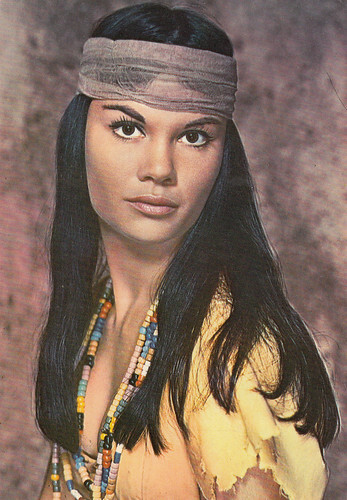
Spanish postcard by Oscarcolor, no. 377. Wende Wagner as Native American character Sally in Rio Conchos (Gordon Douglas, 1964).
Playing Native Americans onscreen
These actresses played Native Americans in movies. Some of them even did it several times.
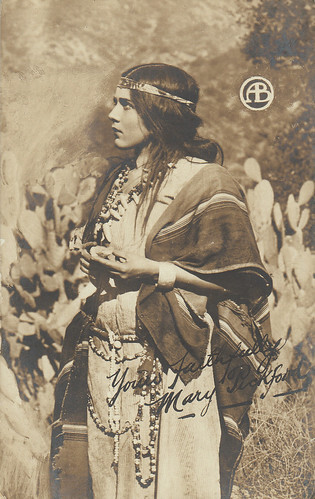
British postcard, no. 71. Photo: American Biograph. Mary Pickford in Iola's Promise (D.W. Griffith, 1912).
At the beginning of her career, Mary Pickford played several times Native Americans under D.W. Griffith ’s direction. It seems that the great director liked to cast her in this kind of role because her hazel eyes were filmed dark. This postcard probably refers to Iola’s Promise (D.W. Griffith, 1912).
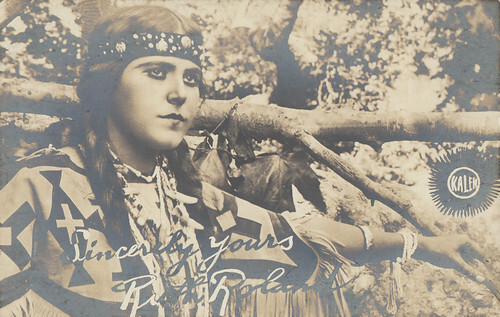
British postcard, no. 70. Photo: Kalem.
During her stay at Kalem, Ruth Roland was given several times Native American roles. This postcard possibly refers to The Indian Maid’s Warning (Pat Hartigan, 1913).
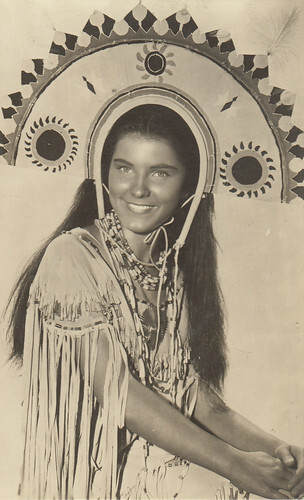
Spanish postcard no. 1212. Debra Paget as Native American character Sonseeahray in Broken Arrow (Delmer Daves, 1950).
Debra Paget also played Native Americans in White Feather (Robert D. Webb, 1955) and The Last Hunt (Richard Brooks, 1956).
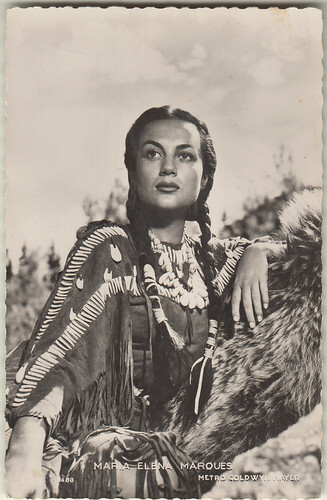
French postcard by Editions P.I., Paris, no. 488. Photo: Metro-Goldwyn-Mayer. Maria Elena Marques as Native American character Kamiah in Across the Wide Missouri (William A. Wellman, 1951).
Maria Elena Marques also played a Native American in Ambush at Tomahawk Gap (Fred F. Sears, 1953).
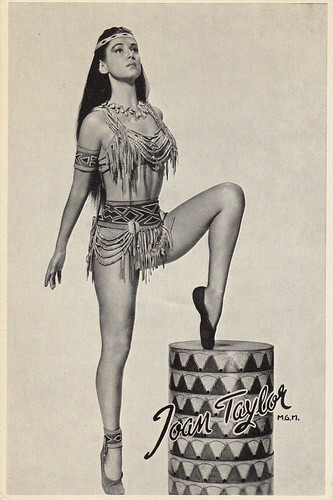
Belgian postcard. Photo: M.G.M. Joan Taylor as Native American character Wanda in Rose Marie (Mervyn LeRoy, 1954).
Joan Taylor played more Native Americans in The Savage (George Marshall. 1952), War Paint (Lesley Selander, 1952) and Apache Woman (Roger Corman, 1955).
Mona Darkfeather: How Josephine Workman from Los Angeles became an Indian Princess
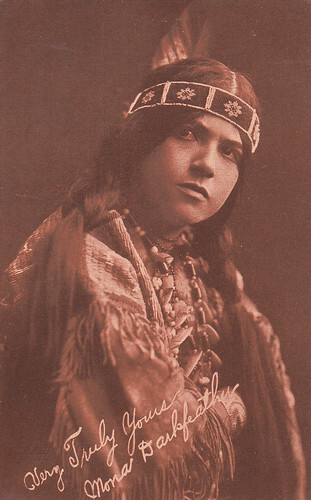
American postcard by Maurer, Schultz & Co., Los Angeles.
Mona Darkfeather was born Josephine Workman in Los Angeles on the 13th of January 1882. It seems that she began to perform on stage at the end of the 19th Century, as a Los Angeles Times 1897 stage review mentions a "Miss Josephine Workman rendering two whistling solos". This is indeed confirmed by the 1900 census, which lists her occupation as 'whistler'. In 1910, Josephine had her first leading role in the silent film A Cheyenne’s Love for a Sioux and soon became known as Princess Mona Darkkfeather. She had turned to the film industry after having seen an ad from the Bison Company asking for Spanish-type girls who would believably play Indians.
For several years, she specialised in Native American roles and starred for example in Owanee’s Great Love (1911), A Squaw’s Retribution (1911), An Indian Love Story (1911), The Massacre of Santa Fe Trail (1912), Star Eye’s Stratagem (1912), A Red Man’s Love (1912), An Apache Father’s Vengeance (1913), Apache Love (1913), An Indian Maid’s Strategy (1913), A Dream of the Wild (1914), Indian Blood (1914), The War Bonnet (1914), The Vanishing Tribe (1914), The Squaw’s Revenge (1914), The Fate of a Squaw (1914), The Vengeance of Winona (1914), A Message for Help (1915), The Circle of Death (1916), The Crimson Arrow (1917), The Hidden Danger (1917), …
Mona Darkfeather had an unusual role in the comedy The Indian Suffragettes (1914), in which she played Dishwater, who comes back to her tribe after having been acquainted with the suffragette movement during her stay at a Government school. She leads the other women to demand equal rights and the men are forced to do the housework and take care of the children. However, when the women go hunting and are attacked by a rival tribe, they have to call their husbands for help. After this debacle, the female community members come back to their usual duties.
She occasionally was given non-Indian parts such as in A Spanish Wooing (1911), The Hand of Fate (1912), Juanita (1913), Against Desperate Odds (1913), The Bottled Spider (1914), The Gypsy Gambler (1914) or None So Blind (1916). She also played Ada Payne, a reporter’s sweetheart, in a series of shorts based upon the character of explorer Henry Morton Stanley which were produced by the Centaur Film Company in 1915. In publicity, she was often touted as a real Native American. Nevertheless, in several interviews, she admitted that she was not and declared that she was of Hispanic descent. However, to give a certain legitimacy to her portrayals, she stated that she had received the title of Princess from an Indian chief and that she had a deep knowledge of Native American customs and languages. It’s questionable if this claim was an invention or if there was some truth in it. We’ll let you judge.
Her family tree was more complex than she alleged. Her paternal grandfather was born in England, her paternal grandmother was from Taos, New Mexico, and is believed to be of Native American Pueblo descent, her maternal grandfather was from Maryland and her maternal grandmother came from Chile. By the mid-1910s, the popularity of the type of Westerns she was associated with was in decline and her screen career ended in 1917, although she probably appeared later in an uncredited bit part in Rocking Moon (1926). At the end of her life, she had lost ties to her family and died destitute in 1977 as a ward of the State of California. For many years, her grave remained anonymous until her great-nephew had a marker installed in 2014.
Red Wing: The first Native American film star
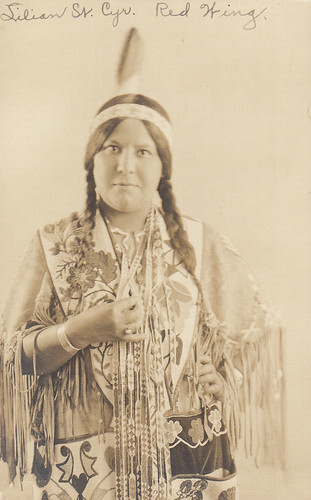
American Artura postcard.
Red Wing was born Lilian St. Cyr on the 13th of February 1884 in Thurston County, on the Native American Winnebago Reservation. She had French Canadians among her ancestors, hence her family name. Orphaned at an early age, she spent several years in boarding schools and graduated from the Carlisle Indian Industrial School in 1902. In 1905, she married James Young Johnson. As Wild West Shows were all the craze at the time, the couple decided to go into show business. They joined the cast of 'Pioneer Days: A Spectacle Drama of Western Life', a Wild West extravaganza which opened in November 1906 at the Hippodrome Theater in New York. After it closed in mid-1907, they soon teamed with Luther Standing Bear a.k.a. Chief Charging Hawk and took their show on the road. Lilian St. Cyr and James Young Johnson thus became Red Wing and Young Deer, names that were better suited to their stage performances. The trio broke up at the end of the summer of 1908.
To fit his new persona, James claimed that he was a full-blooded Native American, although he was of decidedly multi-racial ancestry. His maternal grandmother, who was termed mulatto, was born a slave and was emancipated in 1844. His maternal grandfather was most probably a white planter. Young Deer’s father, George Durham Johnson, who came from a relatively elite mulatto family, was a member of the Colored Soldiers and Sailors League and strongly supported civil rights for coloured people. George and his wife were buried in the Washington Harmony Cemetary, established in 1829 for blacks. Red Wing’s husband nevertheless had a link, through his paternal great-uncle, to the small mixed-race community of Nanticoke Indians of Delaware who, throughout their history, have mingled with White and Afro-Americans. In 1881, they were recognised as an Incorporated Body and were chartered as an official Native American tribe by the state of Delaware in 1922. With such a complex family history, no wonder Young Deer choose to reinvent himself as a Native American, as he knew that revealing his Afro-American roots would have a negative impact on his career.
As the 20th Century’s first decade was coming to an end, Red Wing and Young Deer turned to films. Westerns were then in vogue and people who could play Native Americans were in demand. They got leading roles in The Falling Arrow (1909) at Lubin and they were hired afterwards by the Bison company. For them, Red Wing was featured in, for example, A True Indian’s Heart (1909), Half-Breed’s Treachery (1909), The Red Girl’s Romance (1910), Perils of the Plains (1910), … Her growing popularity led Bison to churn out a special series of 'Red Wing movies', such as Red Wing’s Gratitude (1909), Red Wing’s Loyalty (1910), Red Wing’s Constancy (1910), For the Love of Red Wing (1910), Red Wing and the White Girl (1910) and The Flight of Red Wing (1910).
After their stay at Bison, the couple signed with Pathé and Young Deer soon became the manager of their West Coast studios in Ellendale. For Pathé, Red Wing starred in movies such as The Red Girl and the Child (1910), The Yaqui Girl (1910), Silver Leaf’s Heart (1911), The Cheyenne’s Bride (1911), Romance of the Desert (1911), Swiftwind’s Heroism (1912), For the Papoose (1912), A Redskin’s Appeal (1912), The Squawman’s Sweetheart (1912), The Wooing of White Fawn (1912), The Winning of White Dove (1912), General Scott’s Protégé (1913), A Redskin’s Mercy (1913), The Faithless Friend (1913), … Although she had to comply with some Native American stereotypes, she always sought to bring the most authenticity she could to her portrayals. After Pathé had decided to stop producing in the U.S.A. and to turn to distributing, Red Wing got her most famous role in Cecil B. DeMille ’s The Squaw Man (1914) at the Lasky Company. Her performance as the self-sacrificing Nat-U-Rich got her very good reviews. She then was featured in the Selig movie In the Days of the Thundering Herd (1914), opposite Tom Mix.
In the mid-1910s, the vogue of Indian-themed Westerns was waning. Furthermore, Red Wing had put on weight and was beginning to look matronly. Her film career quickly declined. After her role as the heroine’s mother in Ramona (1916), she disappeared from the screen. From 1920 to 1923, she toured with her own vaudeville act: she gave demonstrations of tribal songs and dances, lectured on her film days and talked about Indian life and customs. In 1925, she made her last movie appearance in an uncredited bit part as a South Sea Island woman in Soul Fire (1925). From the mid-1920s, she supported herself by making Indian costumes and regalia. Her skills in bead, leather and feather work were greatly appreciated and her clients included, for example, members of Indian tribes, theatrical producers and performers or diverse associations, such as the fraternal Red Men’s Order which, despite its name, only comprised white men. Still promoting Indian culture, she again made occasional live appearances over the years at schools, at powwows, at department stores or at events hosted by various organisations. She also steadily participated in political activism to give recognition to American Indians. Her eightieth birthday was celebrated with a party in Manhattan, sponsored by the Indian League of America. The first Native American film star, who always stayed proud of her heritage, passed away on the 13th of March 1974.
Minnie Provost a.k.a. Minnie Devereaux: A heavyweight character actress
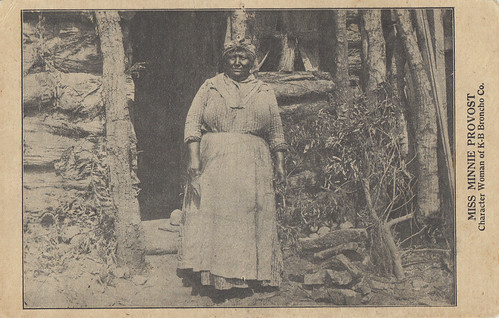
American promotional postcard for the Los Angeles Garrick Movie Theatre in Los Angeles. Photo: K.B. Broncho Co.
Minnie Provost a.k.a. Minnie Devereaux was born Minerva Burgess in 1869 in Oklahoma and was a member of the Native American Cheyenne and Arapaho tribes. In the 1910s and at the beginning of the 1920s, she was a popular character actress in movies and, with her large frame, didn’t go unnoticed.
One of her best-known films is probably Fatty and Minnie He-Haw (1914), a Mack Sennett comedy in which she plays an Indian who finds a dying Fatty in the desert, rescues him and takes him back to her village, where she decides to take him as her husband. Complications of course ensue and the two heavyweight comedians are involved in several funny plot twists.
In another Mack Sennett production, the successful Mabel Normand vehicle Mickey (1918), she is especially good as Minnie, the pipe-smoking Indian housekeeper of the orphaned heroine’s legal guardian, who has acted as a kind of surrogate mother to her. She was later seen in another Mabel Normand feature film, Suzanna (1922).
Minnie Provost also played Natoosh, Madlaine Traverse’s Indian servant, in Rose of the West (1919) and a funny photo of Charlie Chaplin sharing a laugh with Minnie was taken when he visited the set.
On several occasions, she played Afro-American characters, such as in Old Mammy’s Secret Code (1913), in which she portrayed a Confederate family’s old servant, who is shot as a spy by the Union army. In The Coward (1915), she was again given the role of the devoted mammy of a Confederate Southern family. In addition to her credited parts, that gifted performer is believed to have been an extra in more films. She passed away on the 5th of June 1923.
Elizabeth Threatt: The Indian princess of only one movie
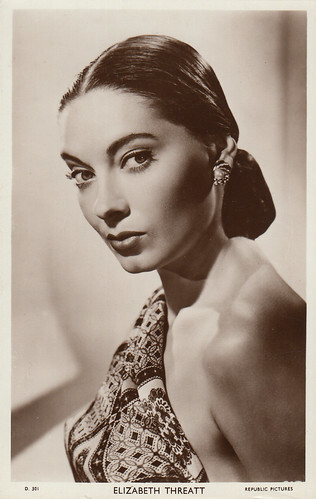
British postcard in the Picturegoer series, London, no. D 301. Elizabeth Threatt in The Big Sky (Howard Hawks, 1952). Comment Marlene: "I’m a bit puzzled by the reference to Republic Pictures on the postcard. Elizabeth Threatt’s only movie was distributed by R.K.O. and I haven’t found any mention of her being under contract to Republic. Maybe it’s a mistake." We do agree that this must be a mistake.
Elizabeth Threatt was born on the 14th of April 1926 in Kershaw, South Carolina, and was half-Cherokee. In the second half of the 1940s, she became a sought-after model and her beauty graced the pages of magazines such as Vogue or Harper’s Bazaar. At the beginning of the 1950s, she met director Howard Hawks, with whom she allegedly had a short-lived affair. He gave her the leading female role of Native American princess Teal Eye in The Big Sky (1952). It was her only movie and she went back to modelling. She retired after her third marriage in 1956. After her divorce in 1963, she settled in Concord, North Carolina, and led a very discreet life. That’s where she passed away in a nursing home on the 22nd of November 1992.
More actresses playing Native Americans onscreen
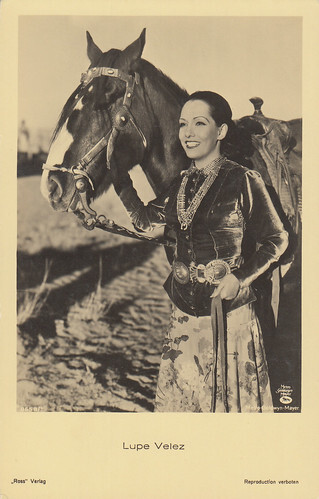
German postcard by Ross Verlag, no. 8658/1, 1933-1934. Photo: Metro-Goldwyn-Mayer. Lupe Velez , as Native American character Naturich, in The Squaw Man (Cecil B. DeMille, 1931).
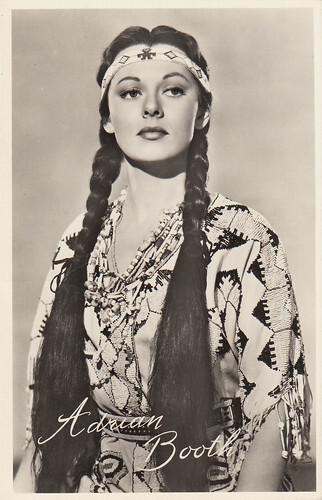
Dutch postcard by Takken, Utrecht, no. AX 1722. Adrian Booth as Native American character Aleeta in Rock Island Trail (Joseph Kane, 1950).
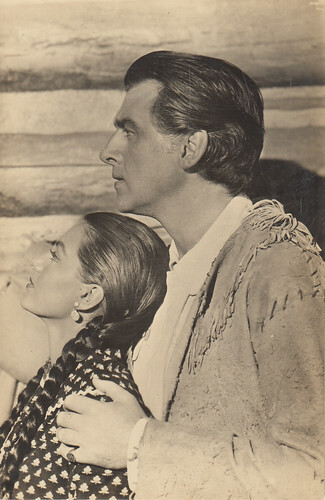
Spanish postcard no. 2737. Cyd Charisse as Native American character Adjidaumo and Stewart Granger in The Wild North (Andrew Marton, 1952).
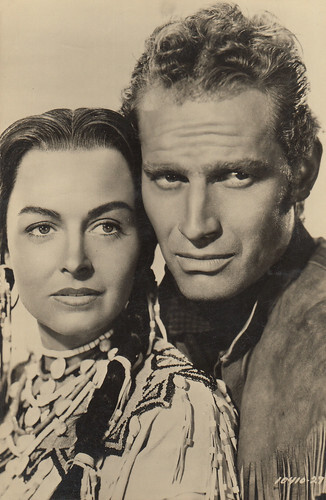
Spanish postcard by Archivo Bermejo, no. 7174. Donna Reed as Native American character Sacajawea and Charlton Heston in The Far Horizons (Rudolph Maté, 1955).
Text and postcards: Marlene Pilaete.

Spanish postcard by Oscarcolor, no. 377. Wende Wagner as Native American character Sally in Rio Conchos (Gordon Douglas, 1964).
Playing Native Americans onscreen
These actresses played Native Americans in movies. Some of them even did it several times.

British postcard, no. 71. Photo: American Biograph. Mary Pickford in Iola's Promise (D.W. Griffith, 1912).
At the beginning of her career, Mary Pickford played several times Native Americans under D.W. Griffith ’s direction. It seems that the great director liked to cast her in this kind of role because her hazel eyes were filmed dark. This postcard probably refers to Iola’s Promise (D.W. Griffith, 1912).

British postcard, no. 70. Photo: Kalem.
During her stay at Kalem, Ruth Roland was given several times Native American roles. This postcard possibly refers to The Indian Maid’s Warning (Pat Hartigan, 1913).

Spanish postcard no. 1212. Debra Paget as Native American character Sonseeahray in Broken Arrow (Delmer Daves, 1950).
Debra Paget also played Native Americans in White Feather (Robert D. Webb, 1955) and The Last Hunt (Richard Brooks, 1956).

French postcard by Editions P.I., Paris, no. 488. Photo: Metro-Goldwyn-Mayer. Maria Elena Marques as Native American character Kamiah in Across the Wide Missouri (William A. Wellman, 1951).
Maria Elena Marques also played a Native American in Ambush at Tomahawk Gap (Fred F. Sears, 1953).

Belgian postcard. Photo: M.G.M. Joan Taylor as Native American character Wanda in Rose Marie (Mervyn LeRoy, 1954).
Joan Taylor played more Native Americans in The Savage (George Marshall. 1952), War Paint (Lesley Selander, 1952) and Apache Woman (Roger Corman, 1955).
Mona Darkfeather: How Josephine Workman from Los Angeles became an Indian Princess

American postcard by Maurer, Schultz & Co., Los Angeles.
Mona Darkfeather was born Josephine Workman in Los Angeles on the 13th of January 1882. It seems that she began to perform on stage at the end of the 19th Century, as a Los Angeles Times 1897 stage review mentions a "Miss Josephine Workman rendering two whistling solos". This is indeed confirmed by the 1900 census, which lists her occupation as 'whistler'. In 1910, Josephine had her first leading role in the silent film A Cheyenne’s Love for a Sioux and soon became known as Princess Mona Darkkfeather. She had turned to the film industry after having seen an ad from the Bison Company asking for Spanish-type girls who would believably play Indians.
For several years, she specialised in Native American roles and starred for example in Owanee’s Great Love (1911), A Squaw’s Retribution (1911), An Indian Love Story (1911), The Massacre of Santa Fe Trail (1912), Star Eye’s Stratagem (1912), A Red Man’s Love (1912), An Apache Father’s Vengeance (1913), Apache Love (1913), An Indian Maid’s Strategy (1913), A Dream of the Wild (1914), Indian Blood (1914), The War Bonnet (1914), The Vanishing Tribe (1914), The Squaw’s Revenge (1914), The Fate of a Squaw (1914), The Vengeance of Winona (1914), A Message for Help (1915), The Circle of Death (1916), The Crimson Arrow (1917), The Hidden Danger (1917), …
Mona Darkfeather had an unusual role in the comedy The Indian Suffragettes (1914), in which she played Dishwater, who comes back to her tribe after having been acquainted with the suffragette movement during her stay at a Government school. She leads the other women to demand equal rights and the men are forced to do the housework and take care of the children. However, when the women go hunting and are attacked by a rival tribe, they have to call their husbands for help. After this debacle, the female community members come back to their usual duties.
She occasionally was given non-Indian parts such as in A Spanish Wooing (1911), The Hand of Fate (1912), Juanita (1913), Against Desperate Odds (1913), The Bottled Spider (1914), The Gypsy Gambler (1914) or None So Blind (1916). She also played Ada Payne, a reporter’s sweetheart, in a series of shorts based upon the character of explorer Henry Morton Stanley which were produced by the Centaur Film Company in 1915. In publicity, she was often touted as a real Native American. Nevertheless, in several interviews, she admitted that she was not and declared that she was of Hispanic descent. However, to give a certain legitimacy to her portrayals, she stated that she had received the title of Princess from an Indian chief and that she had a deep knowledge of Native American customs and languages. It’s questionable if this claim was an invention or if there was some truth in it. We’ll let you judge.
Her family tree was more complex than she alleged. Her paternal grandfather was born in England, her paternal grandmother was from Taos, New Mexico, and is believed to be of Native American Pueblo descent, her maternal grandfather was from Maryland and her maternal grandmother came from Chile. By the mid-1910s, the popularity of the type of Westerns she was associated with was in decline and her screen career ended in 1917, although she probably appeared later in an uncredited bit part in Rocking Moon (1926). At the end of her life, she had lost ties to her family and died destitute in 1977 as a ward of the State of California. For many years, her grave remained anonymous until her great-nephew had a marker installed in 2014.
Red Wing: The first Native American film star

American Artura postcard.
Red Wing was born Lilian St. Cyr on the 13th of February 1884 in Thurston County, on the Native American Winnebago Reservation. She had French Canadians among her ancestors, hence her family name. Orphaned at an early age, she spent several years in boarding schools and graduated from the Carlisle Indian Industrial School in 1902. In 1905, she married James Young Johnson. As Wild West Shows were all the craze at the time, the couple decided to go into show business. They joined the cast of 'Pioneer Days: A Spectacle Drama of Western Life', a Wild West extravaganza which opened in November 1906 at the Hippodrome Theater in New York. After it closed in mid-1907, they soon teamed with Luther Standing Bear a.k.a. Chief Charging Hawk and took their show on the road. Lilian St. Cyr and James Young Johnson thus became Red Wing and Young Deer, names that were better suited to their stage performances. The trio broke up at the end of the summer of 1908.
To fit his new persona, James claimed that he was a full-blooded Native American, although he was of decidedly multi-racial ancestry. His maternal grandmother, who was termed mulatto, was born a slave and was emancipated in 1844. His maternal grandfather was most probably a white planter. Young Deer’s father, George Durham Johnson, who came from a relatively elite mulatto family, was a member of the Colored Soldiers and Sailors League and strongly supported civil rights for coloured people. George and his wife were buried in the Washington Harmony Cemetary, established in 1829 for blacks. Red Wing’s husband nevertheless had a link, through his paternal great-uncle, to the small mixed-race community of Nanticoke Indians of Delaware who, throughout their history, have mingled with White and Afro-Americans. In 1881, they were recognised as an Incorporated Body and were chartered as an official Native American tribe by the state of Delaware in 1922. With such a complex family history, no wonder Young Deer choose to reinvent himself as a Native American, as he knew that revealing his Afro-American roots would have a negative impact on his career.
As the 20th Century’s first decade was coming to an end, Red Wing and Young Deer turned to films. Westerns were then in vogue and people who could play Native Americans were in demand. They got leading roles in The Falling Arrow (1909) at Lubin and they were hired afterwards by the Bison company. For them, Red Wing was featured in, for example, A True Indian’s Heart (1909), Half-Breed’s Treachery (1909), The Red Girl’s Romance (1910), Perils of the Plains (1910), … Her growing popularity led Bison to churn out a special series of 'Red Wing movies', such as Red Wing’s Gratitude (1909), Red Wing’s Loyalty (1910), Red Wing’s Constancy (1910), For the Love of Red Wing (1910), Red Wing and the White Girl (1910) and The Flight of Red Wing (1910).
After their stay at Bison, the couple signed with Pathé and Young Deer soon became the manager of their West Coast studios in Ellendale. For Pathé, Red Wing starred in movies such as The Red Girl and the Child (1910), The Yaqui Girl (1910), Silver Leaf’s Heart (1911), The Cheyenne’s Bride (1911), Romance of the Desert (1911), Swiftwind’s Heroism (1912), For the Papoose (1912), A Redskin’s Appeal (1912), The Squawman’s Sweetheart (1912), The Wooing of White Fawn (1912), The Winning of White Dove (1912), General Scott’s Protégé (1913), A Redskin’s Mercy (1913), The Faithless Friend (1913), … Although she had to comply with some Native American stereotypes, she always sought to bring the most authenticity she could to her portrayals. After Pathé had decided to stop producing in the U.S.A. and to turn to distributing, Red Wing got her most famous role in Cecil B. DeMille ’s The Squaw Man (1914) at the Lasky Company. Her performance as the self-sacrificing Nat-U-Rich got her very good reviews. She then was featured in the Selig movie In the Days of the Thundering Herd (1914), opposite Tom Mix.
In the mid-1910s, the vogue of Indian-themed Westerns was waning. Furthermore, Red Wing had put on weight and was beginning to look matronly. Her film career quickly declined. After her role as the heroine’s mother in Ramona (1916), she disappeared from the screen. From 1920 to 1923, she toured with her own vaudeville act: she gave demonstrations of tribal songs and dances, lectured on her film days and talked about Indian life and customs. In 1925, she made her last movie appearance in an uncredited bit part as a South Sea Island woman in Soul Fire (1925). From the mid-1920s, she supported herself by making Indian costumes and regalia. Her skills in bead, leather and feather work were greatly appreciated and her clients included, for example, members of Indian tribes, theatrical producers and performers or diverse associations, such as the fraternal Red Men’s Order which, despite its name, only comprised white men. Still promoting Indian culture, she again made occasional live appearances over the years at schools, at powwows, at department stores or at events hosted by various organisations. She also steadily participated in political activism to give recognition to American Indians. Her eightieth birthday was celebrated with a party in Manhattan, sponsored by the Indian League of America. The first Native American film star, who always stayed proud of her heritage, passed away on the 13th of March 1974.
Minnie Provost a.k.a. Minnie Devereaux: A heavyweight character actress

American promotional postcard for the Los Angeles Garrick Movie Theatre in Los Angeles. Photo: K.B. Broncho Co.
Minnie Provost a.k.a. Minnie Devereaux was born Minerva Burgess in 1869 in Oklahoma and was a member of the Native American Cheyenne and Arapaho tribes. In the 1910s and at the beginning of the 1920s, she was a popular character actress in movies and, with her large frame, didn’t go unnoticed.
One of her best-known films is probably Fatty and Minnie He-Haw (1914), a Mack Sennett comedy in which she plays an Indian who finds a dying Fatty in the desert, rescues him and takes him back to her village, where she decides to take him as her husband. Complications of course ensue and the two heavyweight comedians are involved in several funny plot twists.
In another Mack Sennett production, the successful Mabel Normand vehicle Mickey (1918), she is especially good as Minnie, the pipe-smoking Indian housekeeper of the orphaned heroine’s legal guardian, who has acted as a kind of surrogate mother to her. She was later seen in another Mabel Normand feature film, Suzanna (1922).
Minnie Provost also played Natoosh, Madlaine Traverse’s Indian servant, in Rose of the West (1919) and a funny photo of Charlie Chaplin sharing a laugh with Minnie was taken when he visited the set.
On several occasions, she played Afro-American characters, such as in Old Mammy’s Secret Code (1913), in which she portrayed a Confederate family’s old servant, who is shot as a spy by the Union army. In The Coward (1915), she was again given the role of the devoted mammy of a Confederate Southern family. In addition to her credited parts, that gifted performer is believed to have been an extra in more films. She passed away on the 5th of June 1923.
Elizabeth Threatt: The Indian princess of only one movie

British postcard in the Picturegoer series, London, no. D 301. Elizabeth Threatt in The Big Sky (Howard Hawks, 1952). Comment Marlene: "I’m a bit puzzled by the reference to Republic Pictures on the postcard. Elizabeth Threatt’s only movie was distributed by R.K.O. and I haven’t found any mention of her being under contract to Republic. Maybe it’s a mistake." We do agree that this must be a mistake.
Elizabeth Threatt was born on the 14th of April 1926 in Kershaw, South Carolina, and was half-Cherokee. In the second half of the 1940s, she became a sought-after model and her beauty graced the pages of magazines such as Vogue or Harper’s Bazaar. At the beginning of the 1950s, she met director Howard Hawks, with whom she allegedly had a short-lived affair. He gave her the leading female role of Native American princess Teal Eye in The Big Sky (1952). It was her only movie and she went back to modelling. She retired after her third marriage in 1956. After her divorce in 1963, she settled in Concord, North Carolina, and led a very discreet life. That’s where she passed away in a nursing home on the 22nd of November 1992.
More actresses playing Native Americans onscreen

German postcard by Ross Verlag, no. 8658/1, 1933-1934. Photo: Metro-Goldwyn-Mayer. Lupe Velez , as Native American character Naturich, in The Squaw Man (Cecil B. DeMille, 1931).

Dutch postcard by Takken, Utrecht, no. AX 1722. Adrian Booth as Native American character Aleeta in Rock Island Trail (Joseph Kane, 1950).

Spanish postcard no. 2737. Cyd Charisse as Native American character Adjidaumo and Stewart Granger in The Wild North (Andrew Marton, 1952).

Spanish postcard by Archivo Bermejo, no. 7174. Donna Reed as Native American character Sacajawea and Charlton Heston in The Far Horizons (Rudolph Maté, 1955).
Text and postcards: Marlene Pilaete.
Published on April 11, 2023 22:00
April 10, 2023
Camilla Horn
Ethereally blonde Camilla Horn (1903-1996) was a German dancer and film star. Her breakthrough role was Gretchen in the silent film classic Faust (1926, Friedrich Wilhelm Murnau). She also starred in some Hollywood films of the late 1920s and from 1930 until her retirement in 1953, she remained a screen favourite in German, British, and Italian films.
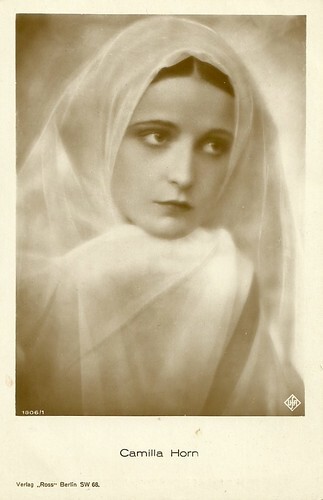
German postcard by Ross Verlag no. 1806/1, 1927-1928. Photo: Ufa.
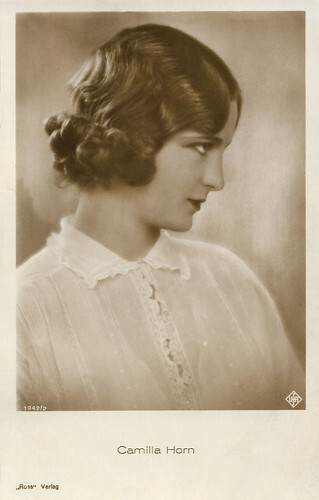
German postcard by Ross Verlag, no. 1942/2, 1927-1928. Photo: Ufa.
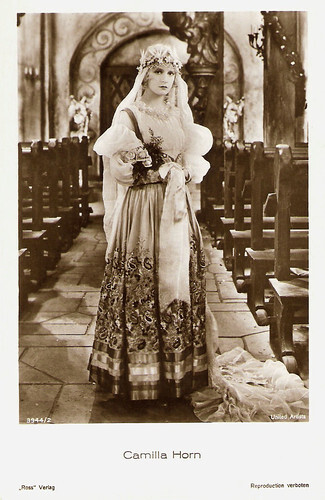
German postcard by Ross Verlag, no. 3944/2, 1928-1929. Photo: United Artists.
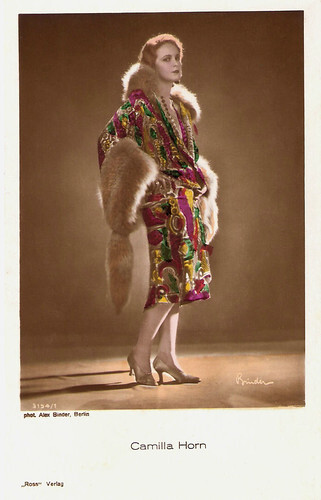
German postcard by Ross Verlag, no. 3154/1, 1928-1929. Photo: Atelier Binder, Berlin.
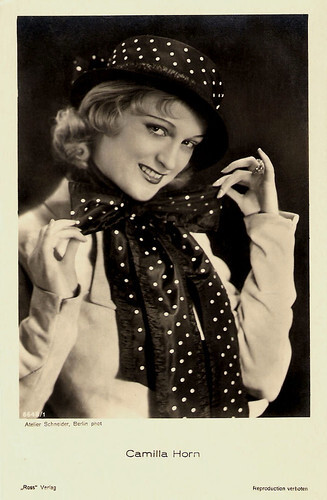
German postcard by Ross Verlag, no. 6648/1, 1931-1932. Photo: Atelier Schneider, Berlin.
Dancer in a Cabaret
Camilla Martha Horn was born in Frankfurt am Main, Germany, in 1903. She was the daughter of the railway official Wilhelm Horn and his wife Martha.
After passing an examination as a seamstress, Horn initially worked in various professions in order to finance her acting training. She finally completed her training in Berlin with Lucie Höflich and also took dance lessons with Rudolf von Laban.
Horn made her stage debut as a dancer in a cabaret.Her film debut was in the Alexandre Dumas père adaptation Kean (Rudolph Biebrach, 1921). In the following years, she had a few appearances as an extra.
In 1925, she worked as an extra in Madame wünscht keine Kinder/Madame Doesn't Want Any Children (Alexander Korda, 1925) with Marlene Dietrich.
In Murnau's Molière adaptation Tartüff/Tartuffe (Friedrich Wilhelm Murnau, 1925), she was a double for the female star, Lil Dagover.
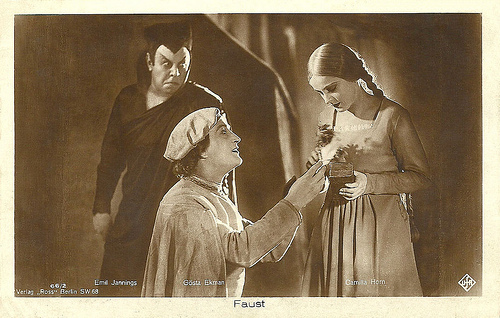
German postcard by Ross Verlag, no. 66/2. Photo: Ufa. Gösta Ekman , Emil Jannings and Camilla Horn in Faust (1926). Collection: Didier Hanson.
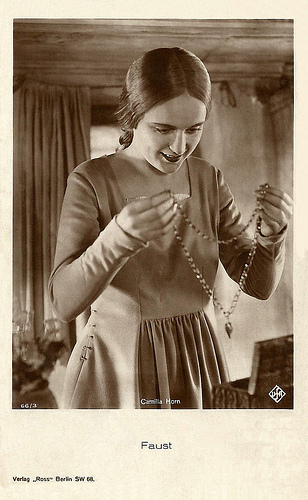
German postcard by Ross Verlag, no. 66/3. Photo: Ufa. Publicity still for Faust (Friedrich Wilhelm Murnau, 1926).
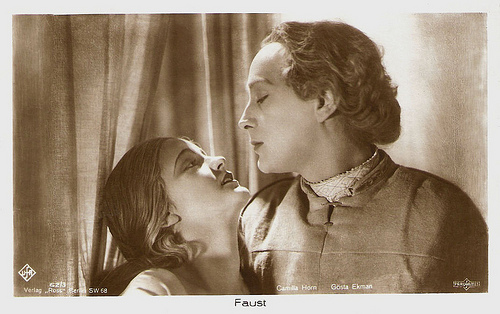
German postcard by Ross Verlag, no. 62/3. Photo: Parufamet. Publicity still for Faust (Friedrich Wilhelm Murnau, 1926).
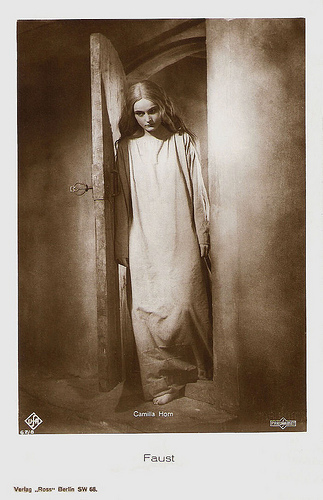
German postcard by Ross Verlag, no. 62/8. Photo: Parufamet. Publicity still for Faust (Friedrich Wilhelm Murnau, 1926).
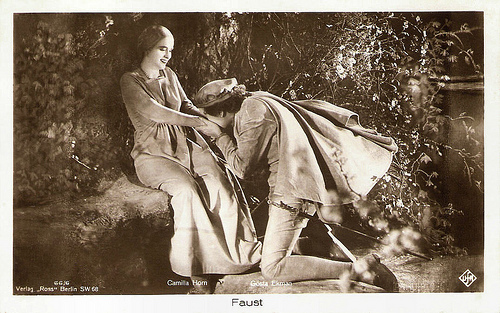
German postcard by Ross Verlag, no. 66/6. Photo: Ufa. Publicity still for Faust (Friedrich Wilhelm Murnau, 1926).
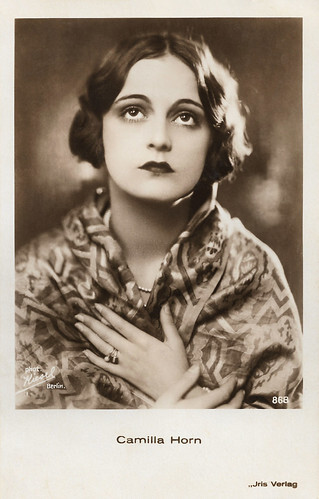
Austrian postcard by Iris Verlag, no. 868. Photo: Kiesel, Berlin.
Ideal Casting
Camilla Horn's great chance came when director Friedrich Wilhelm Murnau prepared a film version of Goethe's Faust.
Murnau had asked Hollywood star Lillian Gish to play Gretchen in the lavish Ufa production, but she insisted that the film should be shot by her favourite cinematographer, Charles Rosher.
Therefore, Murnau decided to cast the newcomer he had met on the set of Tartüff would play Gretchen opposite Gösta Ekman as Faust and Emil Jannings as Mefisto.
The completely unknown Horn proved to be the ideal casting for the role of the ill-fated Gretchen and Faust (Friedrich Wilhelm Murnau, 1926) made her a star.
She signed a four-year contract with the Ufa and acted in Jugendrausch/Youth Frenzy (Georg Asagaroff, Wladyslaw Starewicz, 1927) and Der fröhliche Weinberg/The Merry Weinberg (Jacob Fleck, Luise Fleck, 1927).
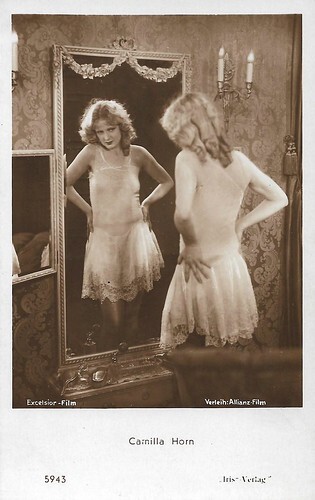
Austrian postcard by Iris Verlag, no. 5943. Photo: Distr. Allianz-Film / Excelsior-Film.
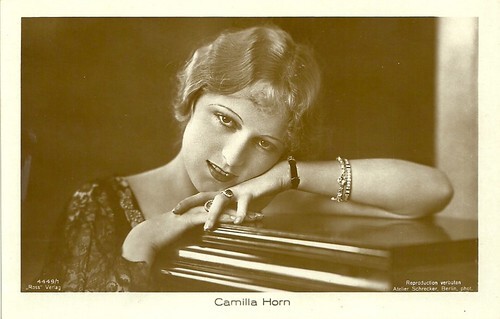
German postcard by Ross Verlag, no. 4449/1, 1929-1930. Photo: Atelier Schrecker, Berlin.
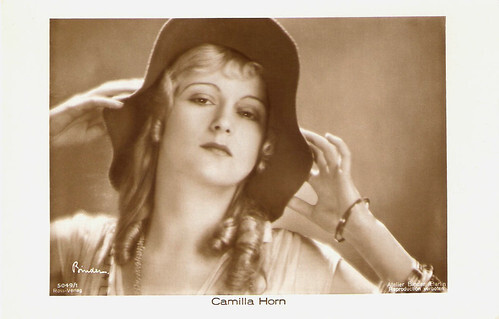
German postcard by Ross Verlag, no. 5049/1, 1930-1931. Photo: Atelier Binder, Berlin.
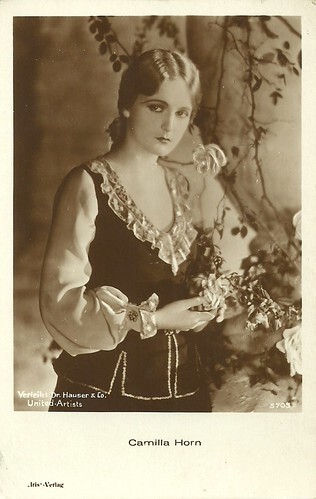
Austrian postcard by Iris Verlag, no. 3705. Photo: Verleih Dr. Hauser & Co. / United Artists.
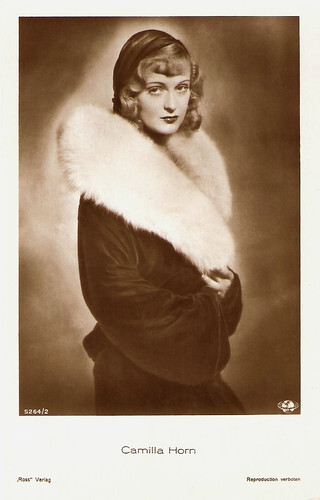
German postcard by Ross Verlag, no. 5264/2, 1930-1931. Photo: Deutsche Universal.
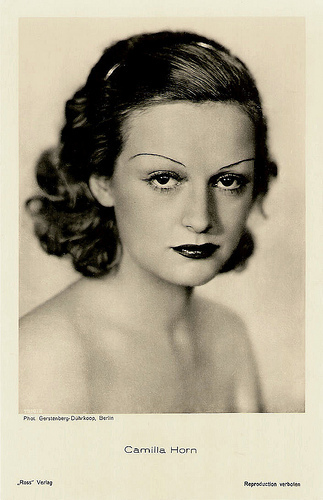
German postcard by Ross Verlag, no. 7916/2, 1932-1933. Photo: Gerstenberg-Dührkoop, Berlin.
Monetary Offense
In 1928 Camilla Horn sailed for Hollywood where she became the mistress of producer Joseph Schenck and played in two United Artists productions.
She starred in Tempest (Sam Taylor, 1928) and in Eternal Love (Ernst Lubitsch, 1929) both opposite John Barrymore . Eternal Love was the last silent film of Barrymore and director Lubitsch.Filmed on location in the Canadian Rockies, Eternal Love was a most uncharacteristic venture into doom and gloom for Lubitsch
She returned to Europe and made popular films like Die grosse Sehnsucht/The Great Desire (Steve Sekely, 1930) and Hans in allen Gassen (Carl Froelich, 1930) with Hans Albers . In Great Britain, she appeared in the comedy of errors, The Love Nest (Thomas Bentley, 1933), set during a dark and stormy night and the murder mystery Matinee Idol (1933), directed by George King.
In Germany, she appeared in Moral und Liebe/Morals and Love (Georg Jacoby, 1933), Die grosse Chance/The Big Chance (Victor Janson, 1934), and Ein Walzer für dich/A Waltz for You (Georg Zoch, 1934).
In the next years, she starred in Der rote Reiter/The Red Rider (Rolf Randolf, 1935), Gauner im Frack/crook in Tails (Johannes Riemann, 1938) and Fahrendes Volk/Driving People (Jacques Feyder, 1938) again at the side to Hans Albers .
She refused to follow the official line of the Nazis and was prosecuted for a monetary offence. During the war, she got only minor parts or she acted in Italian productions like Paura d'amare/Fear of Loving(Gaetano Amata, 1942).
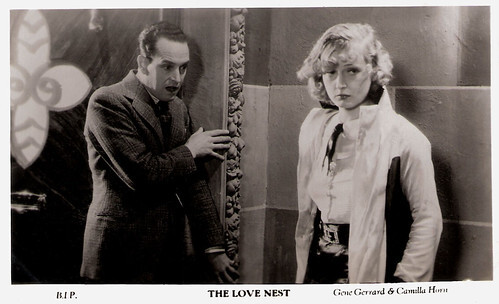
British postcard in the Filmshots series Film Weekly. Photo: B.I.P. Publicity still for The Love Nest (Thomas Bentley, 1933).
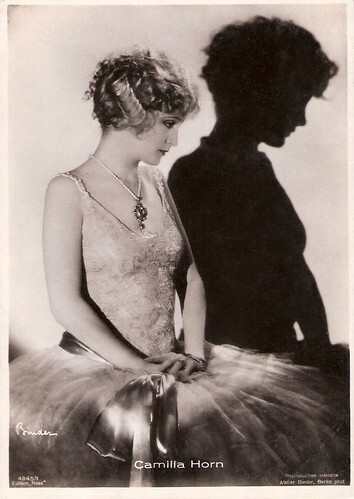
German postcard by Ross Verlag, no. 4845/1, 1929-1930. Photo: Alex Binder, Berlin.
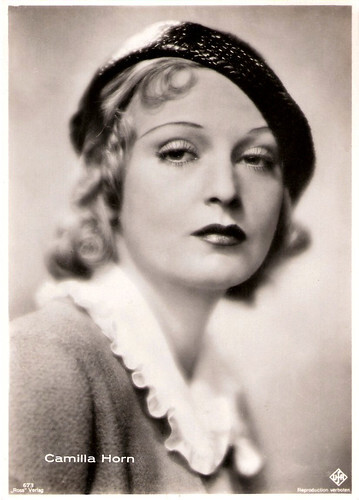
German postcard in the Ross Luxus series by Ross Verlag, Berlin, no. 673. Photo: Ufa.
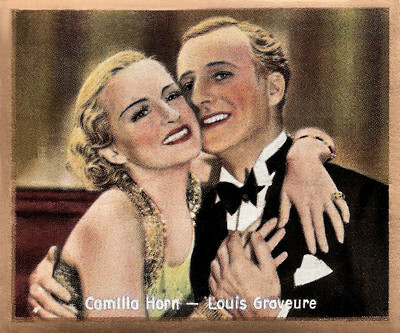
German collectors card by Ross Verlag for Cigarettenfabrik Josetti, Berlin, in the series 'Unsere Bunte Filmbilder', no. 115. Photo: Badal-Film. Camilla Horn and Louis Graveure in Ein Walzer für dich/A Waltz for You (Georg Zoch, 1934).
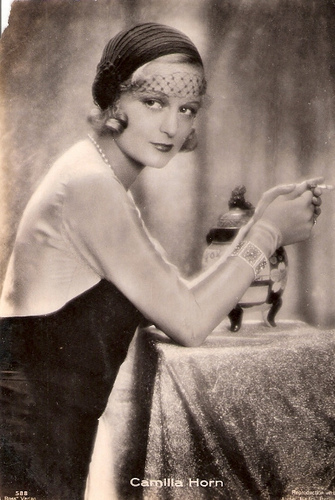
German postcard by Ross Verlag, no. 588. Photo Atelier Balazs, Berlin.
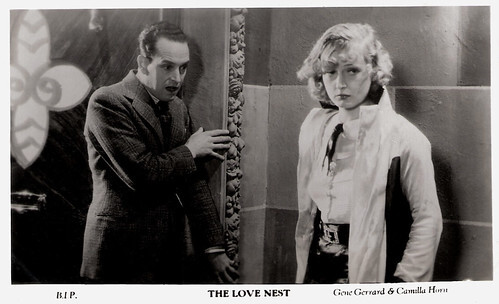
British postcard in the Filmshots series by Film Weekly. Photo: British International Pictures (BIP). Camilla Horn and Gene Gerrard in The Love Nest (Thomas Bentley, 1933).
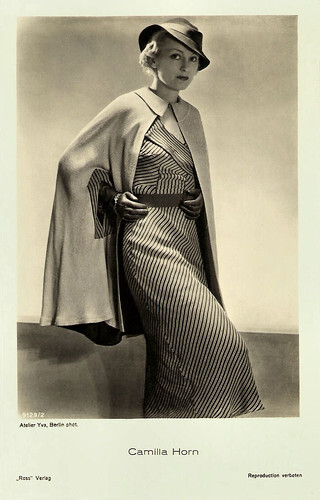
German postcard by Ross Verlag, no. 9129/2, 1935-1936. Photo: Atelier Yva, Berlin.
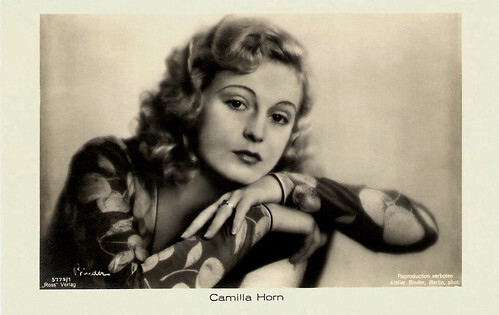
German postcard by Ross Verlag, Berlin, no. 5779/1, 1930-1931. Photo: Atelier Binder.
Late comeback
After the war, the British tribunal at Delmenhorst convicted Camilla Horn for minor offences (among them travelling without permission) and she was imprisoned for three months at the women's prison in Vechta. Her knowledge of English led her to work first as an interpreter and then again as an actress on stage. The German cinema of the post-war years offered her only rare roles in films like Königin der Arena/Queen of the Arena (Rolf Meyer, 1952) and Vati macht Dummheiten/Daddy Does Dumb (Johannes Häussler, 1953).
Camilla Horn appeared only a few times on German television. An example was Mrs. Elizabeth Almond in Die Erbin (1958) based on the play 'The Heiress' by Ruth and Augustus Goetz, based on the novel 'Washington Square' by Henry James. Willy Birgel played doctor Dr. Austin Sloper and Elfriede Kuzmany was his daughter Catherine. In later years she appeared for example as Mrs. Rens, mother of Dr. Rens (Holger Petzold) in the episode 'Die Wunderquelle' (1985) from the cult series 'Die Schwarzwaldklinik'. In 1985 she wrote her memoir, 'Verliebt in die Liebe'.
In the cinema, she made a comeback in Schloss Königswald/Castle Königswald(Peter Schamoni, 1988), an hommage to former film stars like Camilla Horn, Marianne Hoppe , Carola Höhn , Marika Rökk and Rose Renée Roth. They played elderly female aristocrats who gather at an ancient castle to live in grand style and escape the chaos of World War II. The all-star cast was awarded the Bavarian Film Award for Best Actress of 1988.
Her last appearance was in the TV drama Die Spinnen/The Spiders (Pál Erdöss, 1989) with Mark Bellinghaus. She was unable to fulfil her last commitment, to play the role of Miss Sophie in the 1992 feature film Dinner for One with Bodo Maria, due to illness. A video was made dedicated to her. She spent her old age at Herrsching, and during the last year of her life, she lived in Gilching near Starnberg, where she had lived.
Camilla Horn died in Gilching, Germany, in 1996. Her grave is in the cemetery in Herrsching am Ammersee. She was married four times: to the businessman Klaus Geerts (1927 to 1930), to the architect Kurt Kurfis (from 1938), to the Swiss Robert Schnyder and to Rudolf Mühlfenzl, the editor-in-chief of Bayerischer Rundfunk (1953 to 1963). She owned a weekend house in the 1930s in Lübben (Spreewald) on the Weinberg, which still stands today.
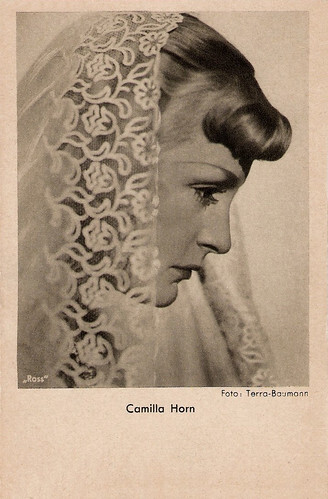
German postcard by Ross. Photo: Terra-Baumann.
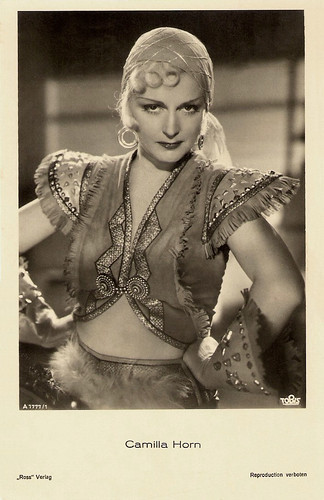
German postcard by Ross Verlag, no. A 1777/1, 1937-1938. Photo: Tobis.
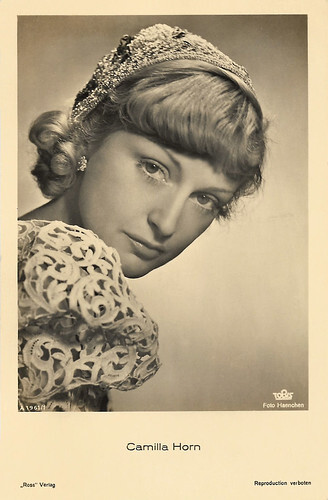
German postcard by Ross Verlag, no. A 1961/1, 1937-1938. Photo: Haenchen / Tobis.
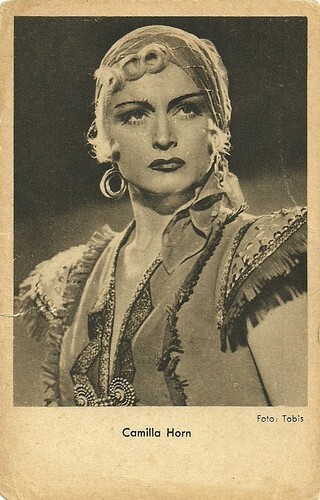
German postcard by Das Filmprogramm von Heute. Zeitschrift für Film und Theater. Photo: Tobis.
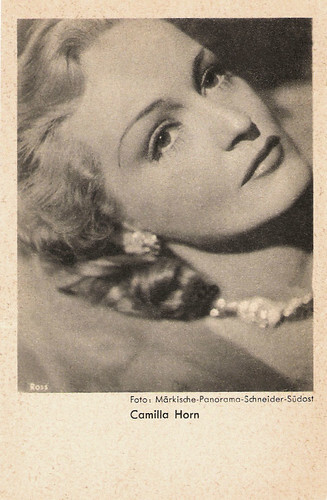
German postcard by Ross / Das Programm von Heute, Berlin. Photo: Märkische - Panorama - Schneider - Südost.
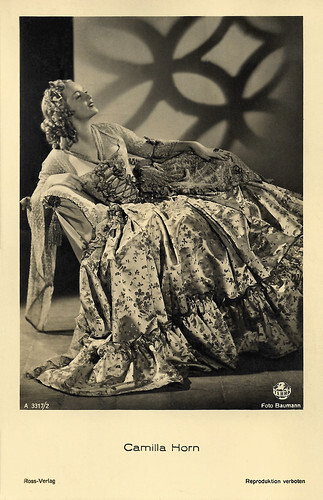
German postcard by Ross Verlag, no. A 3317/2, 1941-1944. Photo: Baumann / Terra. Camilla Horn in Friedemann Bach (Traugott Müller, Gustaf Gründgens, 1941).
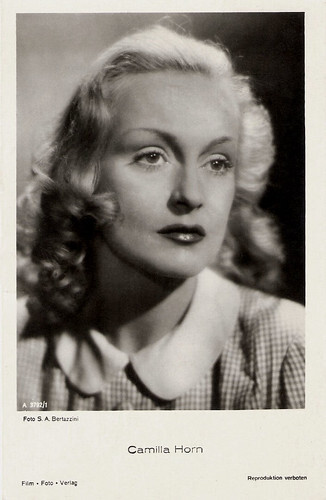
German postcard by Film-Foto-Verlag, no. A 3792/1, 1941-1944. Photo: S.A. Bertazzini.
Sources: Thomas Staedeli (Cyranos), Hal Erickson (AllMovie), Stephanie d'Heil (Steffi-Line - German), Wikipedia (English, and German ), .

German postcard by Ross Verlag no. 1806/1, 1927-1928. Photo: Ufa.

German postcard by Ross Verlag, no. 1942/2, 1927-1928. Photo: Ufa.

German postcard by Ross Verlag, no. 3944/2, 1928-1929. Photo: United Artists.

German postcard by Ross Verlag, no. 3154/1, 1928-1929. Photo: Atelier Binder, Berlin.

German postcard by Ross Verlag, no. 6648/1, 1931-1932. Photo: Atelier Schneider, Berlin.
Dancer in a Cabaret
Camilla Martha Horn was born in Frankfurt am Main, Germany, in 1903. She was the daughter of the railway official Wilhelm Horn and his wife Martha.
After passing an examination as a seamstress, Horn initially worked in various professions in order to finance her acting training. She finally completed her training in Berlin with Lucie Höflich and also took dance lessons with Rudolf von Laban.
Horn made her stage debut as a dancer in a cabaret.Her film debut was in the Alexandre Dumas père adaptation Kean (Rudolph Biebrach, 1921). In the following years, she had a few appearances as an extra.
In 1925, she worked as an extra in Madame wünscht keine Kinder/Madame Doesn't Want Any Children (Alexander Korda, 1925) with Marlene Dietrich.
In Murnau's Molière adaptation Tartüff/Tartuffe (Friedrich Wilhelm Murnau, 1925), she was a double for the female star, Lil Dagover.

German postcard by Ross Verlag, no. 66/2. Photo: Ufa. Gösta Ekman , Emil Jannings and Camilla Horn in Faust (1926). Collection: Didier Hanson.

German postcard by Ross Verlag, no. 66/3. Photo: Ufa. Publicity still for Faust (Friedrich Wilhelm Murnau, 1926).

German postcard by Ross Verlag, no. 62/3. Photo: Parufamet. Publicity still for Faust (Friedrich Wilhelm Murnau, 1926).

German postcard by Ross Verlag, no. 62/8. Photo: Parufamet. Publicity still for Faust (Friedrich Wilhelm Murnau, 1926).

German postcard by Ross Verlag, no. 66/6. Photo: Ufa. Publicity still for Faust (Friedrich Wilhelm Murnau, 1926).

Austrian postcard by Iris Verlag, no. 868. Photo: Kiesel, Berlin.
Ideal Casting
Camilla Horn's great chance came when director Friedrich Wilhelm Murnau prepared a film version of Goethe's Faust.
Murnau had asked Hollywood star Lillian Gish to play Gretchen in the lavish Ufa production, but she insisted that the film should be shot by her favourite cinematographer, Charles Rosher.
Therefore, Murnau decided to cast the newcomer he had met on the set of Tartüff would play Gretchen opposite Gösta Ekman as Faust and Emil Jannings as Mefisto.
The completely unknown Horn proved to be the ideal casting for the role of the ill-fated Gretchen and Faust (Friedrich Wilhelm Murnau, 1926) made her a star.
She signed a four-year contract with the Ufa and acted in Jugendrausch/Youth Frenzy (Georg Asagaroff, Wladyslaw Starewicz, 1927) and Der fröhliche Weinberg/The Merry Weinberg (Jacob Fleck, Luise Fleck, 1927).

Austrian postcard by Iris Verlag, no. 5943. Photo: Distr. Allianz-Film / Excelsior-Film.

German postcard by Ross Verlag, no. 4449/1, 1929-1930. Photo: Atelier Schrecker, Berlin.

German postcard by Ross Verlag, no. 5049/1, 1930-1931. Photo: Atelier Binder, Berlin.

Austrian postcard by Iris Verlag, no. 3705. Photo: Verleih Dr. Hauser & Co. / United Artists.

German postcard by Ross Verlag, no. 5264/2, 1930-1931. Photo: Deutsche Universal.

German postcard by Ross Verlag, no. 7916/2, 1932-1933. Photo: Gerstenberg-Dührkoop, Berlin.
Monetary Offense
In 1928 Camilla Horn sailed for Hollywood where she became the mistress of producer Joseph Schenck and played in two United Artists productions.
She starred in Tempest (Sam Taylor, 1928) and in Eternal Love (Ernst Lubitsch, 1929) both opposite John Barrymore . Eternal Love was the last silent film of Barrymore and director Lubitsch.Filmed on location in the Canadian Rockies, Eternal Love was a most uncharacteristic venture into doom and gloom for Lubitsch
She returned to Europe and made popular films like Die grosse Sehnsucht/The Great Desire (Steve Sekely, 1930) and Hans in allen Gassen (Carl Froelich, 1930) with Hans Albers . In Great Britain, she appeared in the comedy of errors, The Love Nest (Thomas Bentley, 1933), set during a dark and stormy night and the murder mystery Matinee Idol (1933), directed by George King.
In Germany, she appeared in Moral und Liebe/Morals and Love (Georg Jacoby, 1933), Die grosse Chance/The Big Chance (Victor Janson, 1934), and Ein Walzer für dich/A Waltz for You (Georg Zoch, 1934).
In the next years, she starred in Der rote Reiter/The Red Rider (Rolf Randolf, 1935), Gauner im Frack/crook in Tails (Johannes Riemann, 1938) and Fahrendes Volk/Driving People (Jacques Feyder, 1938) again at the side to Hans Albers .
She refused to follow the official line of the Nazis and was prosecuted for a monetary offence. During the war, she got only minor parts or she acted in Italian productions like Paura d'amare/Fear of Loving(Gaetano Amata, 1942).

British postcard in the Filmshots series Film Weekly. Photo: B.I.P. Publicity still for The Love Nest (Thomas Bentley, 1933).

German postcard by Ross Verlag, no. 4845/1, 1929-1930. Photo: Alex Binder, Berlin.

German postcard in the Ross Luxus series by Ross Verlag, Berlin, no. 673. Photo: Ufa.

German collectors card by Ross Verlag for Cigarettenfabrik Josetti, Berlin, in the series 'Unsere Bunte Filmbilder', no. 115. Photo: Badal-Film. Camilla Horn and Louis Graveure in Ein Walzer für dich/A Waltz for You (Georg Zoch, 1934).

German postcard by Ross Verlag, no. 588. Photo Atelier Balazs, Berlin.

British postcard in the Filmshots series by Film Weekly. Photo: British International Pictures (BIP). Camilla Horn and Gene Gerrard in The Love Nest (Thomas Bentley, 1933).

German postcard by Ross Verlag, no. 9129/2, 1935-1936. Photo: Atelier Yva, Berlin.

German postcard by Ross Verlag, Berlin, no. 5779/1, 1930-1931. Photo: Atelier Binder.
Late comeback
After the war, the British tribunal at Delmenhorst convicted Camilla Horn for minor offences (among them travelling without permission) and she was imprisoned for three months at the women's prison in Vechta. Her knowledge of English led her to work first as an interpreter and then again as an actress on stage. The German cinema of the post-war years offered her only rare roles in films like Königin der Arena/Queen of the Arena (Rolf Meyer, 1952) and Vati macht Dummheiten/Daddy Does Dumb (Johannes Häussler, 1953).
Camilla Horn appeared only a few times on German television. An example was Mrs. Elizabeth Almond in Die Erbin (1958) based on the play 'The Heiress' by Ruth and Augustus Goetz, based on the novel 'Washington Square' by Henry James. Willy Birgel played doctor Dr. Austin Sloper and Elfriede Kuzmany was his daughter Catherine. In later years she appeared for example as Mrs. Rens, mother of Dr. Rens (Holger Petzold) in the episode 'Die Wunderquelle' (1985) from the cult series 'Die Schwarzwaldklinik'. In 1985 she wrote her memoir, 'Verliebt in die Liebe'.
In the cinema, she made a comeback in Schloss Königswald/Castle Königswald(Peter Schamoni, 1988), an hommage to former film stars like Camilla Horn, Marianne Hoppe , Carola Höhn , Marika Rökk and Rose Renée Roth. They played elderly female aristocrats who gather at an ancient castle to live in grand style and escape the chaos of World War II. The all-star cast was awarded the Bavarian Film Award for Best Actress of 1988.
Her last appearance was in the TV drama Die Spinnen/The Spiders (Pál Erdöss, 1989) with Mark Bellinghaus. She was unable to fulfil her last commitment, to play the role of Miss Sophie in the 1992 feature film Dinner for One with Bodo Maria, due to illness. A video was made dedicated to her. She spent her old age at Herrsching, and during the last year of her life, she lived in Gilching near Starnberg, where she had lived.
Camilla Horn died in Gilching, Germany, in 1996. Her grave is in the cemetery in Herrsching am Ammersee. She was married four times: to the businessman Klaus Geerts (1927 to 1930), to the architect Kurt Kurfis (from 1938), to the Swiss Robert Schnyder and to Rudolf Mühlfenzl, the editor-in-chief of Bayerischer Rundfunk (1953 to 1963). She owned a weekend house in the 1930s in Lübben (Spreewald) on the Weinberg, which still stands today.

German postcard by Ross. Photo: Terra-Baumann.

German postcard by Ross Verlag, no. A 1777/1, 1937-1938. Photo: Tobis.

German postcard by Ross Verlag, no. A 1961/1, 1937-1938. Photo: Haenchen / Tobis.

German postcard by Das Filmprogramm von Heute. Zeitschrift für Film und Theater. Photo: Tobis.

German postcard by Ross / Das Programm von Heute, Berlin. Photo: Märkische - Panorama - Schneider - Südost.

German postcard by Ross Verlag, no. A 3317/2, 1941-1944. Photo: Baumann / Terra. Camilla Horn in Friedemann Bach (Traugott Müller, Gustaf Gründgens, 1941).

German postcard by Film-Foto-Verlag, no. A 3792/1, 1941-1944. Photo: S.A. Bertazzini.
Sources: Thomas Staedeli (Cyranos), Hal Erickson (AllMovie), Stephanie d'Heil (Steffi-Line - German), Wikipedia (English, and German ), .
Published on April 10, 2023 22:00
April 9, 2023
Directed by Michael Curtiz
Hungarian-American film director Michael Curtiz (1886-1962) was born Manó Kaminer but was called Mihály Kertész in 1905. After completing his studies, Kertész became a film director and directed more than 40 silent films in Budapest. He left Hungary in 1919 after the film industry there was nationalised and moved to Vienna. There he directed 19 films including the colossal epics Sodom und Gomorrha/Sodom and Gomorrah (1922) with Victor Varconi and Lucy Doraine and Die Sklavenkönigin/The Moon of Israel (1924) with Maria Corda and Adelqui Migliar. In 1926, Curtiz moved to America and adopted the stage name 'Michael Curtiz'. By the 1940s, Curtiz was one of Warner Brothers' best-known directors of such box-office hits as Captain Blood (1935), The Private Lives of Elizabeth and Essex (1939) and Casablanca (1942). He continued working until his death in 1962.
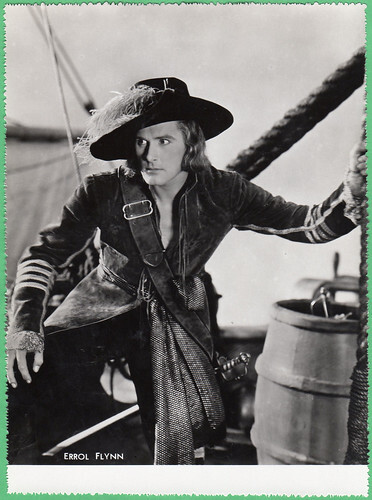
Belgian collectors card by Chocolaterie Clovis, Pepinster. Photo: Errol Flynn in Captain Blood (Michael Curtiz, 1935). Collection: Amit Benyovits.
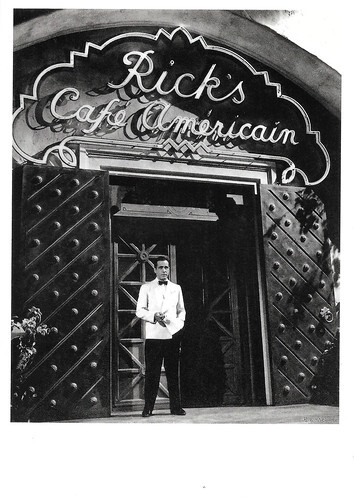
French postcard in the Collection Magie Noire by Éditions Hazan, Paris, 1990, no. 6224. Humphrey Bogart in Casablanca (Michael Curtiz, 1942).
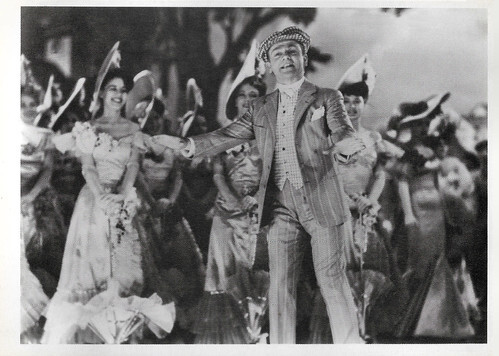
Canadian postcard by Canadian Postcard, no. A-68. Photo: James Cagney in Yankee Doodle Dandy (Michael Curtiz, 1942).
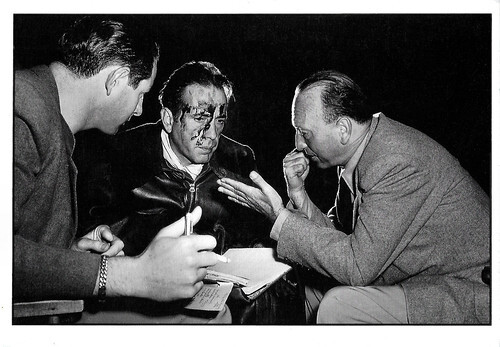
French postcard in the Entr'acte series by Éditions Asphodèle. Mâcon, no. 00/8. Director Michael Curtiz, Humphrey Bogart and scriptwriter Herschel Daugherty on the set of Passage to Marseille (Michael Curtiz, 1944).
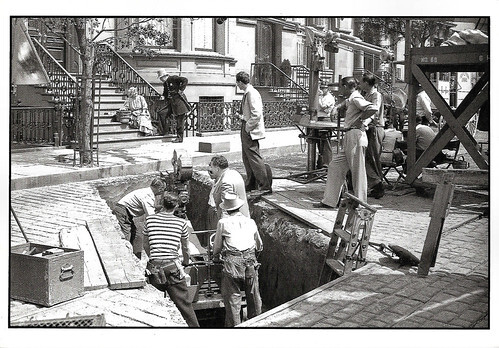
French postcard in the Entr'acte series by Éditions Asphodèle, Mâcon, no. 001/02. Photo: set photo of Life With Father (Michael Curtiz, 1947). Caption: For the purposes of the film, a real pit in a dummy street at Warner Bros. Studios in Burbank.
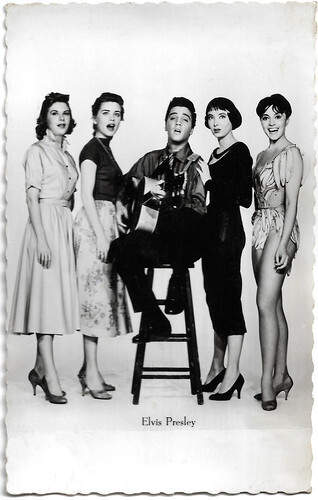
Dutch postcard by Drukkerij Uitg. Int. Filmpers, Amsterdam, no. 5019. Elvis Presley , Dolores Hart, Carolyn Jones, Liliane Montevecchi and Jan Shepard in King Creole (Michael Curtiz, 1958).
Director of Hungary's first feature film
Michael Curtiz (1886-1962) was born Manó Kaminer in Budapest, Hungary, in 1886. His father was a carpenter and his mother was an opera singer. In 1905, he Magyarised his name to Mihály Kertész. Curtiz became attracted to the theatre when he was a child. He built a little theatre in the cellar of his family home when he was 8 years old, where he and five of his friends re-enacted plays. They set up the stage, with scenery and props, and Curtiz directed them. After graduating from high school, he studied at Markoszy University, followed by the Royal Academy of Theater and Art, in Budapest.
After he graduated from college at age 19, he took a job as an actor with a travelling theatre company, where he began working as one of their travelling players. From that job, he became a pantomimist with a circus for a while, but then returned to join another group of travelling players for a few more years. They played Henrik Ibsen and William Shakespeare in various languages, depending on what country they were in. They performed throughout Europe, including France, Hungary, Italy, and Germany, and he eventually learned five languages.
In 1912, Mihály Kertész worked at the National Hungarian Theater. He was also a member of the Hungarian fencing team at the Olympic Games in Stockholm. Kertész directed Hungary's first feature film, Ma és holnap/Today and Tomorrow (Mihály Kertész, 1912), in which he also had a leading role. He followed that with another film, Az utolsó bohém/The Last Bohemian (Mihály Kertész, also 1912).
He went to study at Nordisk studio in Denmark, which led to work as an actor and assistant director to August Blom on Denmark's first multireel feature film, Atlantis (August Blom, 1913), a literary adaptation of Gerhard Hauptmann's 'Atlantis'. Then, he returned to Sweden, where he assisted directors such as Victor Sjöström and Mauritz Stiller , as Scandinavian films dominated European cinemas at the time. After World War I began in 1914, he returned to Hungary, where he served in the army for a year, before he was wounded fighting on the Russian front.
Kertész soon became chief director of the leading Hungarian film production company, Phoenix, where he remained until he left Hungary. In Budapest, he directed more than 40 silent films for the Phoenix until 1919. However, none of the films he directed in Hungary survives intact, and most are completely lost. In 1919, the communist Béla Kun established a short-lived dictatorship in Hungary. With the seizure of power by Kun and his nationalisation of the film industry, Mihály Kertész fled with other Hungarian filmmakers to West Europe to make films there.
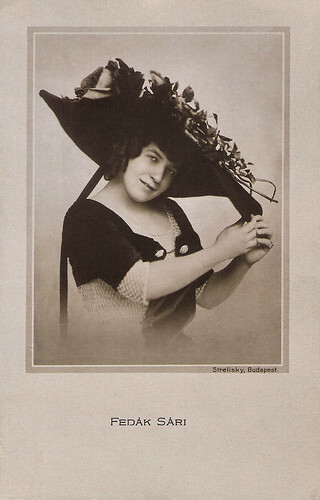
Hungarian postcard by Kiadja Reinitz Jòzsef, Budapest. Photo: Strelisky, Budapest. Hungarian actress and singer Sári Fedák (1879-1955) was one of the most famous prima donnas of her time. She co-starred with Alfréd Deésy in the Hungarian film Rablélek (1913), directed by Mihály Kertész.
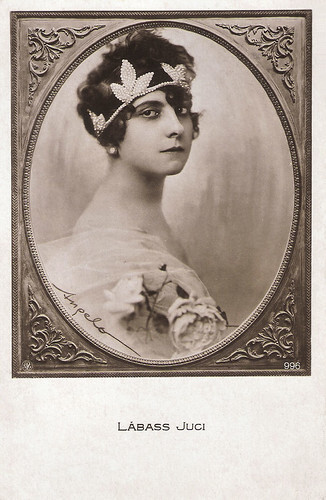
German postcard by NPG, no. 996. Photo: Angelo. Juci Lábass (1892-1932), aka Lucie Labass and Juczi Lábass, was a Hungarian stage and screen actress. In 1915 she made her screen debut at the Hungarian film company Projectograph in Mihály Kertész's film A paradicsom/A Paradise, in which she played a newcomer on the stage, opposite Jenõ Sziklay as a married lawyer. She remained with Kertész for the comedy Doktor úr/Mr. Doctor (Mihály Kertész, 1916), based on a play by Ferenc Molnár. The male leads were Márton Rátkai, Labass' future husband, and György Kürthy.
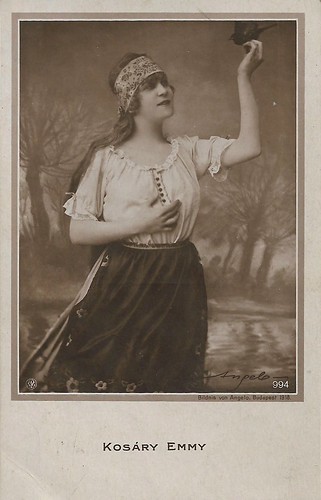
German postcard by NPG, no. 994. Photo: Angelo, Budapest 1918. Emmi Kosáry (1889-1964) was a Hungarian opera diva and operetta prima donna with a beautiful soprano voice. Kosáry made her film debut in the silent film Tatárjárás/Tartar Invasion (1917) with Camilla von Hollay. The film was directed by Mihály Kertész.
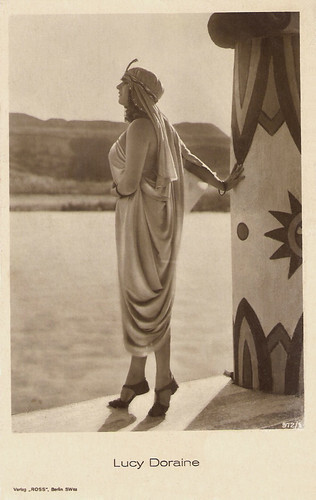
German postcard by Ross Verlag, Berlin, no. 572/1, 1919-1924. Lucy Doraine in Sodom und Gomorrha/Queen of Sin and the Spectacle of Sodom and Gomorrah (Mihály Kertész, 1922).
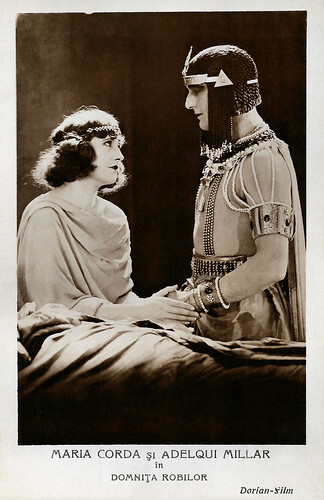
Romanian postcard. Photo: Dorian-Film. Maria Corda and Adelqui Migliar in Die Sklavenkönigin/The Moon of Israel (Mihaly Kertesz, 1924).
The biggest and most expensive film productions ever made in Austria
Mihaly Kertesz briefly worked at the UFA the famous German film company, where he learned to direct large groups of costumed extras, along with using complicated plots, rapid pacing, and romantic themes. His career truly started when he moved to Austria and continued his work at Count Alexander 'Sascha' Kolowrat's film studio, Sascha-Film. Kertesz made at least 21 films for the count's film studio.
At Sascha-Film, Kertesz tended to specialise in directing two kinds of films, either sophisticated light comedies or historical spectaculars. With such monumental films as Sodom und Gomorrha/Queen of Sin and the Spectacle of Sodom and Gomorrah (Mihály Kertész, 1922) and Die Sklavenkönigin/The Moon of Israel (Mihaly Kertesz, 1924), he realised some of the biggest and most expensive film productions ever made in Austria.
Die Sklavenkönigin/The Moon of Israel (Mihaly Kertesz, 1924) was a spectacle of the enslavement of the children of Israel and their miraculous deliverance by way of the Red Sea. Shot in Vienna with a cast of 5,000, it had for its theme the love story of an Israelite maiden and an Egyptian prince. Paramount Pictures bought the rights to the film in the U.S. to compete with Cecil B. DeMille 's The Ten Commandments.
Mihaly Kertesz was in direct competition with his compatriot Alexander Korda, who was also directing monumental films for the rival company Vita-Film at the same time. He also made Red Heels (1925) and Die goldene Schmetterling/The golden butterfly (Michael Curtiz, 1926) starring Lili Damita . He launched the careers of Lucy Doraine and Lili Damita , who both went on to become international stars. Kertesz was a member of the board of the Austrian Film Association, a lobby group for Austrian filmmakers. He worked in Berlin and Paris in the 1920s.
Die Sklavenkönigin/The Moon of Israel (Mihaly Kertesz, 1924) also caught the attention of Jack and Harry Warner. In 1926, Harry went to Europe just to meet Curtiz and watch him work as a director. Harry Warner asked him to come to Hollywood and offered him a well-paid contract at his new film studio, Warner Bros. There he would direct a similar epic that had been planned, Noah's Ark (1928). By the time Kertesz accepted Warner's offer, he was already a prolific director, having made 64 films in countries including Hungary, Austria, and Denmark. With his emigration, he also changed his surname. From now on, he was called Michael Curtiz.
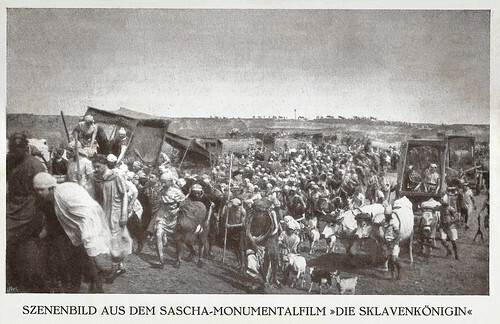
Austrian postcard by Sascha. Scene from Die Sklavenkönigin/The Moon of Israel (Mihaly Kertesz, 1924).
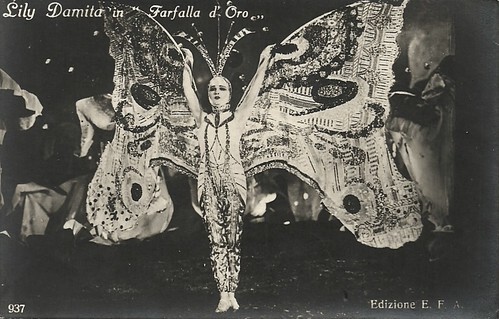
Italian postcard by Edizione E.F.A., no. 937. Photo: Lili Damita in the Austrian silent film Die goldene Schmetterling/The golden butterfly (Michael Curtiz, 1926).
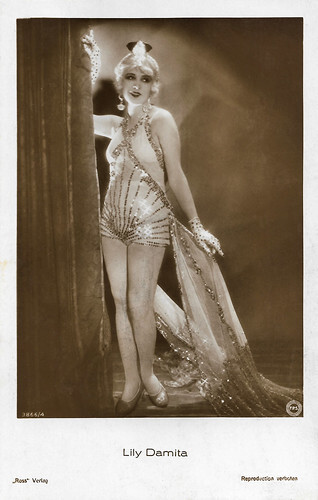
German postcard by Ross Verlag, no. 3866/4, 1928-1929. Photo: F.P.S. Lili Damita in Die goldene Schmetterling/The Golden Butterfly (Michael Curtiz (as Michael Kertesz), 1926).
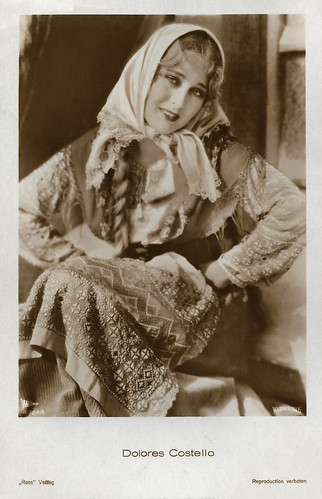
German postcard by Ross Verlag, no. 4424/1, 1929-1930. Photo: Warner Bros / Nationalfilm. Dolores Costello in Hearts in Exile (Michael Curtiz, 1929).
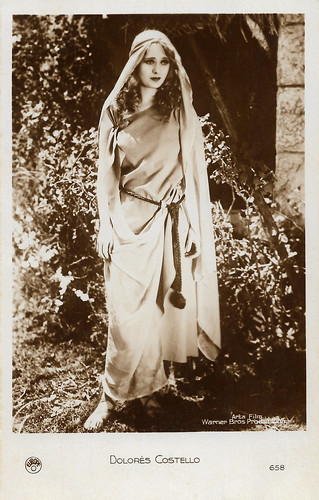
French postcard by Europe, no. 658. Photo: Warner Bros / Arta Film. Dolores Costello in Noah's Ark (Michael Curtiz, 1929).
The fastest-growing studio in Hollywood
Michael Curtiz arrived in the United States in the summer of 1926 and began directing at Warner Bros. During what became a 28-year period at Warner Bros., he directed 86 films. At 38, he was an experienced filmmaker, but Warners assigned him to direct a number of average-quality films to break him in. The first was The Third Degree (Michael Curtiz, 1926) with Dolores Costello . Wikipedia : "Curtiz's unique camerawork technique was used throughout, visible in dramatic camera angles, in a style which one critic assumed other directors would likely envy."
Warner Bros. began experimenting with sound films. They assigned two part-silent and part-talking pictures for Curtiz to direct: Tenderloin (Michael Curtiz, 1928) and Noah's Ark (Michael Curtiz, 1928), both of which also starred Dolores Costello . Noah's Ark included two parallel stories, one recounting the biblical flood, and the other a World War I-era romance. It was the first epic film attempted by Warner Bros., and in handing production over to Curtiz, they were hoping to assure its success. The climactic flood sequence was spectacular and the story was an adaptation written by Bess Meredyth, who married Curtiz a few years later.
The critical success of the films by Curtiz contributed to Warner Bros' becoming the fastest-growing studio in Hollywood. Curtiz was friends with co-founder Harry Warner, with whom he shared a love of polo and horse breeding. He remained with Warners for the next 26 years and became the studio's most distinguished director. Some of his films were routine productions, but in most of his films, Curtiz was able to demonstrate his technical mastery of constructing interesting scenes even from hackneyed scripts.
In 1930, Curtiz directed Mammy (Michael Curtiz, 1930), Al Jolson 's fourth film after being in Hollywood's first true talking picture, The Jazz Singer (Alan Crosland, 1927). Although unusual projects for Warner Bros., Curtiz directed two Horror films for the studio, Doctor X (Michael Curtiz, 1932) and Mystery of the Wax Museum (Michael Curtiz, 1933), both in early Technicolor, with numerous atmospheric scenes filmed on the studio's back lot. During the 1930s, Curtiz directed at least four films each year. Especially in the 1930s and 1940s, Curtiz rose to become a major director at Warner Bros and was a style-setter in many respects.
His films with Errol Flynn , beginning with the Swashbuckler Captain Blood (Michael Curtiz, 1935) based on the novel by Rafael Sabatini, made Flynn from an unknown extra into the studio's biggest male star. The film was a major success with positive critical reviews and a nomination for the Academy Award for Best Picture. Other hits with Flynn and his co-star Olivia De Havilland were The Charge of the Light Brigade (Michael Curtiz, 1936), which depicts a heroic episode from the Crimean War, the Swashbuckler The Adventures of Robin Hood (Michael Curtiz, William Keighley, 1938), which perfectly combined Technicolor and crowd scenes to effective effect, and The Sea Hawk (Michael Curtiz, 1940) with Brenda Marshall instead of De Havilland, became classics of the genre. Later, the successful collaboration broke down due to disputes between the rather undisciplined Flynn and the authoritarian Curtiz.
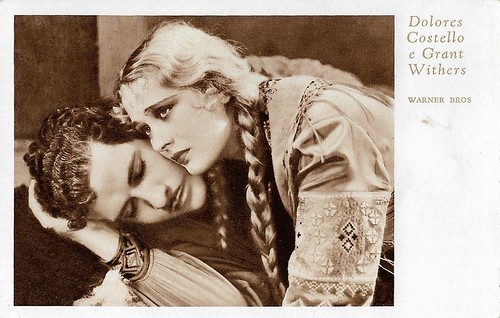
Italian postcard in the Cinema-Illustrazione, series II, no. 8. Photo: Warner Bros. Dolores Costello and Grant Withers in Hearts in Exile (Michael Curtiz, 1929).
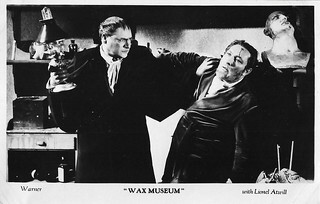
British postcard by Film Weekly. Photo: Warner Bros. Lionel Atwill and Edwin Maxwell in the horror film Mystery of the Wax Museum (Michael Curtiz, 1933). It was one of the last fiction films using the two-color Technicolor process. The film would be remade as House of Wax (1953).
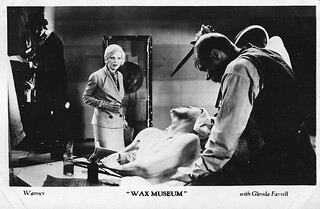
British postcard by Film Weekly. Photo: Warner Bros. Glenda Farrell in the horror film Mystery of the Wax Museum (Michael Curtiz, 1933).
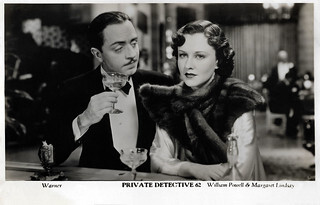
British postcard in the Filmshots series by Film Weekly. Photo: Warner. Margaret Lindsay and William Powell in Private Detective 62 (Michael Curtiz, 1933).
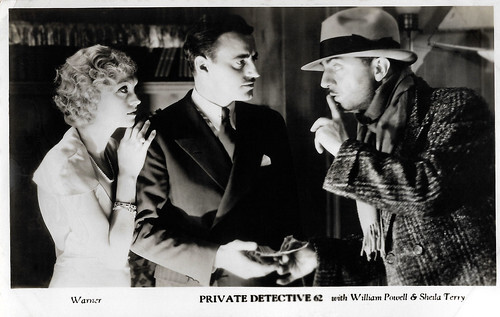
British postcard in the Filmshots series by Film Weekly. Photo: Warner. Sheila Terry and William Powell in Private Detective 62 (Michael Curtiz, 1933).
Warner Bros.'s biggest box-office success in the company's history
The 1940s continued to have releases of other critically acclaimed Michael Curtiz films, including The Sea Wolf (Michael Curtiz, 1941) with his new discovery John Garfield , the World War II-era romantic drama Casablanca (Michael Curtiz, 1942) - one of the most popular films ever made, Mildred Pierce (Michael Curtiz, 1945), and Life with Father (Michael Curtiz, 1947).
Curtiz helped several actors to excellent roles. James Cagney won the Academy Award for Best Actor in a Leading Role at the 1943 Academy Awards for Yankee Doodle Dandy (Michael Curtiz, 1942), the film biography of composer and entertainer George M. Cohan. The film became Warner Bros.'s biggest box-office success in the company's history up to that time, nominated for nine Academy Awards and winning four. The success of the film also became a high point in Curtiz's career, with his nomination as Best Director.
Joan Crawford won the Academy Award for Best Actress in a Leading Role at the 1946 Academy Awards for her performance in Mildred Pierce (Michael Curtiz, 1945). Crawford gave one of the strongest performances in her career, playing a mother and successful businesswoman who sacrifices everything for her spoiled daughter, played by Ann Blyth . Mildred Pierce was nominated for six Academy Awards, including Best Picture. Crawford and Curtiz worked together again in 1949 on The Road to Success.
Curtiz directed William Powell and Irene Dunne in the family comedy Life with Father (Michael Curtiz, 1947). It was a big hit in the United States and was nominated for four Academy Awards, including Best Actor for Powell. During Powell's career, he acted in 97 films. His third and last nomination was for Life with Father (Michael Curtiz, 1947).
Michael Curtiz was responsible for the rise of Doris Day . He first auditioned her and gave her a starring role in her debut film, Romance on the High Seas (1948). Day co-starred with Kirk Douglas and Lauren Bacall in Young Man with a Horn (Michael Curtiz, 1950), with Douglas portraying the rise and fall of a driven jazz musician, based on real-life cornet player Bix Beiderbecke. Curtiz followed with I'll See You in My Dreams (Michael Curtiz, 1952), with Doris Day and Danny Thomas. The film is a musical biography of lyricist Gus Kahn.
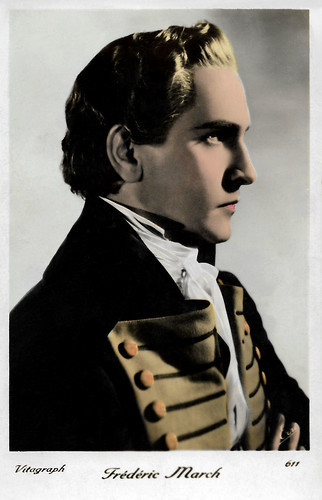
French postcard by Erpé, no. 611. Photo: Vitagraph. Fredric March in Anthony Adverse (Mervyn LeRoy, Michael Curtiz, 1936).
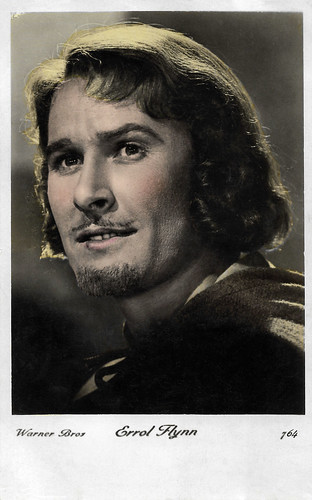
French postcard, no. 764. Photo: Warner Bros. Errol Flynn in The Adventures of Robin Hood (Michael Curtiz, William Keighley, 1938).
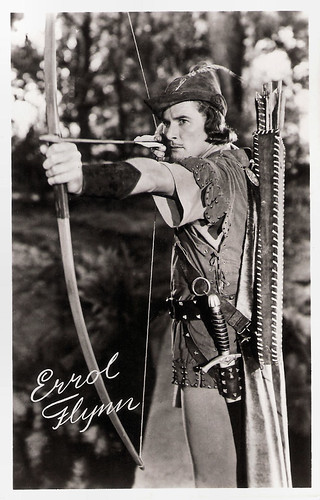
Dutch card. Photo: Warner Bros. Errol Flynn in The Adventures of Robin Hood (Michael Curtiz, William Keighley, 1938).
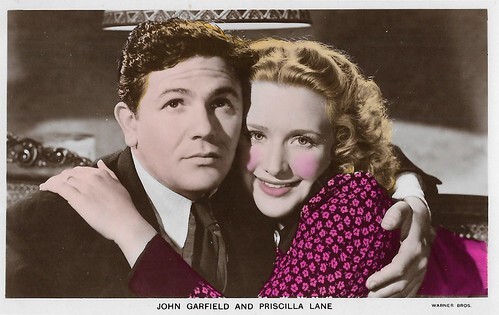
British postcard in the Film Partner series, no. PC 303. Photo: Warner Bros. John Garfield and Priscilla Lane in Four Daughters (Michael Curtiz, 1938).
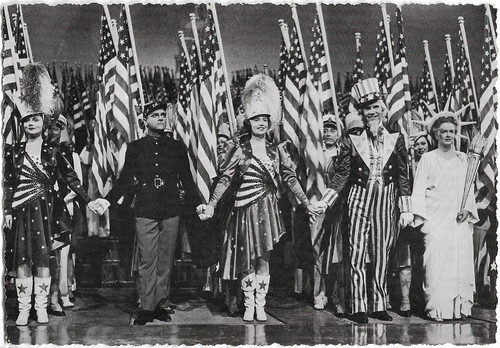
British postcard by Dover Publications Inc., 1986. Photo: Jeanne Cagney, James Cagney , Joan Leslie, Walter Huston and Rosemary De Camp in Yankee Doodle Dandy (Michael Curtiz, 1942).
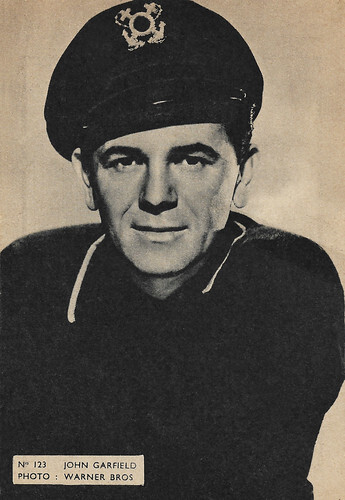
Belgian collectors card by Publesca for Le Cinéma Ritz, no. 123. Photo: Warner Bros. John Garfield in The Breaking Point (Michael Curtiz, 1950).
A bitter court battle with Warner Bros.
The long partnership between Michael Curtiz and Warner Bros. eventually descended into a bitter court battle. Curtiz left Warner Brothers in 1953. Curtiz continued to direct on a freelance basis from 1954 onwards. For Fox, he made The Egyptian (Michael Curtiz, 1954), based on Mika Waltari's novel about Sinuhe, and starring Jean Simmons , Victor Mature , and Gene Tierney .
Curtiz directed many films for Paramount. White Christmas (Michael Curtiz, 1954), his second adaptation of an Irving Berlin musical, was a major box-office success, even the highest-grossing film of 1954. It starred Bing Crosby, Danny Kaye , Rosemary Clooney , and Vera-Ellen . Another popular film was the crime comedy We Are Not Angels (Michael Curtiz, 1955), starring Humphrey Bogart and Peter Ustinov as gangsters who escaped from prison.
Another success was the musical, King Creole (Michael Curtiz, 1958), with Carolyn Jones and Elvis Presley in one of his few dramatic roles. The final film that Curtiz directed was The Comancheros (Michael Curtiz, 1962). Curtiz was ill during the shoot, but star John Wayne took over directing on the days Curtiz was too ill to work. Wayne did not want to take a co-director credit. The Comancheros was released six months before his death from cancer on 10 April 1962
Around 1918, Michael Curtiz married actress Lucy Doraine , and they divorced in 1923. They had a daughter, Kitty Curtiz-Eberson (1915-2006). He had a lengthy affair with Lili Damita starting in 1925. In 1929, Curtiz married his last wife, actress and screenwriter Bess Meredyth. During their marriage, Curtiz had numerous affairs and Meredyth once left him for a short time but they remained married until his death. She was Curtiz's helper whenever he needed to deal with scripts or other elements which went beyond his grasp of English and he often phoned her for advice when presented with a problem while filming. He had one son, John Meredyth Lucas, whom he adopted in 1929 when the boy was ten years old.
In 1933, Curtiz became a naturalised U.S. citizen. Curtiz had left Europe before the rise of Nazism: other members of his family were less fortunate. He asked Jack Warner, who was going to Budapest in 1938, to contact his family and help them get exit visas. Warner got Curtiz's mother to the U.S., where she spent the rest of her life living with her son. He could not rescue Curtiz's only sister, her husband, or their three children, who were sent to Auschwitz, where her husband and two of the children were murdered. After his death at 75, Michael Curtiz was interred in the Forest Lawn Memorial Park Cemetery in Glendale, California.
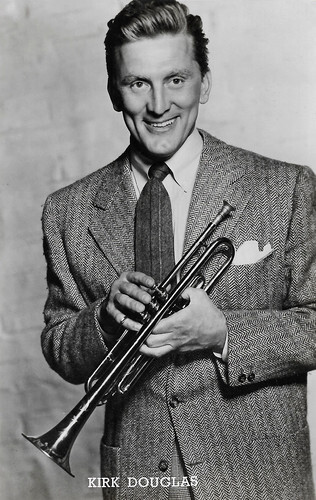
Belgian postcard. Photo: Warner Bros. Kirk Douglas in Young Man with a Horn (Michael Curtiz, 1950).

Dutch postcard by Takken, Utrecht, no. 810. Photo: Warner Bros. Doris Day with Danny Thomas in I'll See You in My Dreams (Michael Curtiz, 1951).
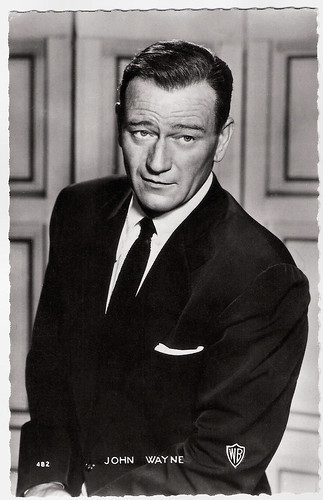
French postcard by P.I., Paris, presented by Les Carbones Korès, no. 482. Photo: Warner Bros, 1953. John Wayne in Trouble Along the Way (Michael Curtiz, 1953).
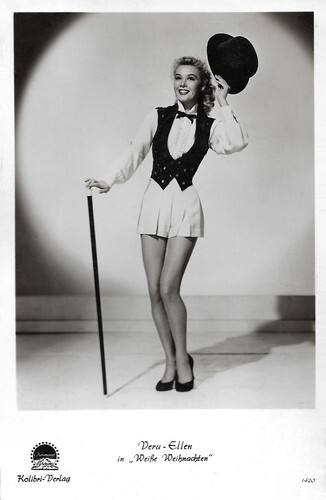
German card by Kolibri-Verlag, no. 1420. Photo: Paramount. Vera-Ellen in White Christmas (Michael Curtiz, 1954).
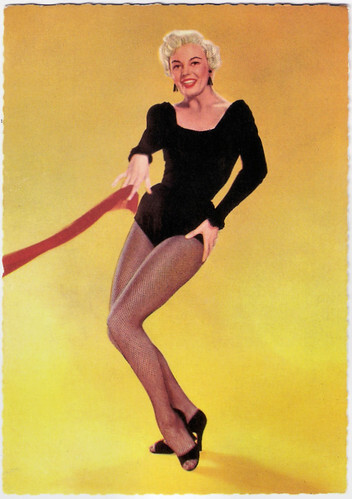
German postcard by ISV, no. A 27. Photo: 20th Century Fox. Sheree North in The Best Things in Life Are Free (Michael Curtiz, 1956).
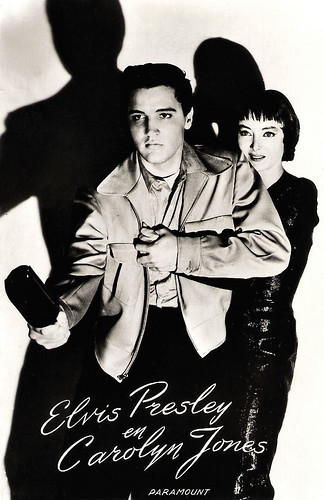
Dutch postcard by Uitg. Takken, Utrecht, no. AX 3978. Photo: Paramount. Elvis Presley and Carolyn Jones in King Creole (Michael Curtiz, 1958).
Sources: Wikipedia (German and English) and .

Belgian collectors card by Chocolaterie Clovis, Pepinster. Photo: Errol Flynn in Captain Blood (Michael Curtiz, 1935). Collection: Amit Benyovits.

French postcard in the Collection Magie Noire by Éditions Hazan, Paris, 1990, no. 6224. Humphrey Bogart in Casablanca (Michael Curtiz, 1942).

Canadian postcard by Canadian Postcard, no. A-68. Photo: James Cagney in Yankee Doodle Dandy (Michael Curtiz, 1942).

French postcard in the Entr'acte series by Éditions Asphodèle. Mâcon, no. 00/8. Director Michael Curtiz, Humphrey Bogart and scriptwriter Herschel Daugherty on the set of Passage to Marseille (Michael Curtiz, 1944).

French postcard in the Entr'acte series by Éditions Asphodèle, Mâcon, no. 001/02. Photo: set photo of Life With Father (Michael Curtiz, 1947). Caption: For the purposes of the film, a real pit in a dummy street at Warner Bros. Studios in Burbank.

Dutch postcard by Drukkerij Uitg. Int. Filmpers, Amsterdam, no. 5019. Elvis Presley , Dolores Hart, Carolyn Jones, Liliane Montevecchi and Jan Shepard in King Creole (Michael Curtiz, 1958).
Director of Hungary's first feature film
Michael Curtiz (1886-1962) was born Manó Kaminer in Budapest, Hungary, in 1886. His father was a carpenter and his mother was an opera singer. In 1905, he Magyarised his name to Mihály Kertész. Curtiz became attracted to the theatre when he was a child. He built a little theatre in the cellar of his family home when he was 8 years old, where he and five of his friends re-enacted plays. They set up the stage, with scenery and props, and Curtiz directed them. After graduating from high school, he studied at Markoszy University, followed by the Royal Academy of Theater and Art, in Budapest.
After he graduated from college at age 19, he took a job as an actor with a travelling theatre company, where he began working as one of their travelling players. From that job, he became a pantomimist with a circus for a while, but then returned to join another group of travelling players for a few more years. They played Henrik Ibsen and William Shakespeare in various languages, depending on what country they were in. They performed throughout Europe, including France, Hungary, Italy, and Germany, and he eventually learned five languages.
In 1912, Mihály Kertész worked at the National Hungarian Theater. He was also a member of the Hungarian fencing team at the Olympic Games in Stockholm. Kertész directed Hungary's first feature film, Ma és holnap/Today and Tomorrow (Mihály Kertész, 1912), in which he also had a leading role. He followed that with another film, Az utolsó bohém/The Last Bohemian (Mihály Kertész, also 1912).
He went to study at Nordisk studio in Denmark, which led to work as an actor and assistant director to August Blom on Denmark's first multireel feature film, Atlantis (August Blom, 1913), a literary adaptation of Gerhard Hauptmann's 'Atlantis'. Then, he returned to Sweden, where he assisted directors such as Victor Sjöström and Mauritz Stiller , as Scandinavian films dominated European cinemas at the time. After World War I began in 1914, he returned to Hungary, where he served in the army for a year, before he was wounded fighting on the Russian front.
Kertész soon became chief director of the leading Hungarian film production company, Phoenix, where he remained until he left Hungary. In Budapest, he directed more than 40 silent films for the Phoenix until 1919. However, none of the films he directed in Hungary survives intact, and most are completely lost. In 1919, the communist Béla Kun established a short-lived dictatorship in Hungary. With the seizure of power by Kun and his nationalisation of the film industry, Mihály Kertész fled with other Hungarian filmmakers to West Europe to make films there.

Hungarian postcard by Kiadja Reinitz Jòzsef, Budapest. Photo: Strelisky, Budapest. Hungarian actress and singer Sári Fedák (1879-1955) was one of the most famous prima donnas of her time. She co-starred with Alfréd Deésy in the Hungarian film Rablélek (1913), directed by Mihály Kertész.

German postcard by NPG, no. 996. Photo: Angelo. Juci Lábass (1892-1932), aka Lucie Labass and Juczi Lábass, was a Hungarian stage and screen actress. In 1915 she made her screen debut at the Hungarian film company Projectograph in Mihály Kertész's film A paradicsom/A Paradise, in which she played a newcomer on the stage, opposite Jenõ Sziklay as a married lawyer. She remained with Kertész for the comedy Doktor úr/Mr. Doctor (Mihály Kertész, 1916), based on a play by Ferenc Molnár. The male leads were Márton Rátkai, Labass' future husband, and György Kürthy.

German postcard by NPG, no. 994. Photo: Angelo, Budapest 1918. Emmi Kosáry (1889-1964) was a Hungarian opera diva and operetta prima donna with a beautiful soprano voice. Kosáry made her film debut in the silent film Tatárjárás/Tartar Invasion (1917) with Camilla von Hollay. The film was directed by Mihály Kertész.

German postcard by Ross Verlag, Berlin, no. 572/1, 1919-1924. Lucy Doraine in Sodom und Gomorrha/Queen of Sin and the Spectacle of Sodom and Gomorrah (Mihály Kertész, 1922).

Romanian postcard. Photo: Dorian-Film. Maria Corda and Adelqui Migliar in Die Sklavenkönigin/The Moon of Israel (Mihaly Kertesz, 1924).
The biggest and most expensive film productions ever made in Austria
Mihaly Kertesz briefly worked at the UFA the famous German film company, where he learned to direct large groups of costumed extras, along with using complicated plots, rapid pacing, and romantic themes. His career truly started when he moved to Austria and continued his work at Count Alexander 'Sascha' Kolowrat's film studio, Sascha-Film. Kertesz made at least 21 films for the count's film studio.
At Sascha-Film, Kertesz tended to specialise in directing two kinds of films, either sophisticated light comedies or historical spectaculars. With such monumental films as Sodom und Gomorrha/Queen of Sin and the Spectacle of Sodom and Gomorrah (Mihály Kertész, 1922) and Die Sklavenkönigin/The Moon of Israel (Mihaly Kertesz, 1924), he realised some of the biggest and most expensive film productions ever made in Austria.
Die Sklavenkönigin/The Moon of Israel (Mihaly Kertesz, 1924) was a spectacle of the enslavement of the children of Israel and their miraculous deliverance by way of the Red Sea. Shot in Vienna with a cast of 5,000, it had for its theme the love story of an Israelite maiden and an Egyptian prince. Paramount Pictures bought the rights to the film in the U.S. to compete with Cecil B. DeMille 's The Ten Commandments.
Mihaly Kertesz was in direct competition with his compatriot Alexander Korda, who was also directing monumental films for the rival company Vita-Film at the same time. He also made Red Heels (1925) and Die goldene Schmetterling/The golden butterfly (Michael Curtiz, 1926) starring Lili Damita . He launched the careers of Lucy Doraine and Lili Damita , who both went on to become international stars. Kertesz was a member of the board of the Austrian Film Association, a lobby group for Austrian filmmakers. He worked in Berlin and Paris in the 1920s.
Die Sklavenkönigin/The Moon of Israel (Mihaly Kertesz, 1924) also caught the attention of Jack and Harry Warner. In 1926, Harry went to Europe just to meet Curtiz and watch him work as a director. Harry Warner asked him to come to Hollywood and offered him a well-paid contract at his new film studio, Warner Bros. There he would direct a similar epic that had been planned, Noah's Ark (1928). By the time Kertesz accepted Warner's offer, he was already a prolific director, having made 64 films in countries including Hungary, Austria, and Denmark. With his emigration, he also changed his surname. From now on, he was called Michael Curtiz.

Austrian postcard by Sascha. Scene from Die Sklavenkönigin/The Moon of Israel (Mihaly Kertesz, 1924).

Italian postcard by Edizione E.F.A., no. 937. Photo: Lili Damita in the Austrian silent film Die goldene Schmetterling/The golden butterfly (Michael Curtiz, 1926).

German postcard by Ross Verlag, no. 3866/4, 1928-1929. Photo: F.P.S. Lili Damita in Die goldene Schmetterling/The Golden Butterfly (Michael Curtiz (as Michael Kertesz), 1926).

German postcard by Ross Verlag, no. 4424/1, 1929-1930. Photo: Warner Bros / Nationalfilm. Dolores Costello in Hearts in Exile (Michael Curtiz, 1929).

French postcard by Europe, no. 658. Photo: Warner Bros / Arta Film. Dolores Costello in Noah's Ark (Michael Curtiz, 1929).
The fastest-growing studio in Hollywood
Michael Curtiz arrived in the United States in the summer of 1926 and began directing at Warner Bros. During what became a 28-year period at Warner Bros., he directed 86 films. At 38, he was an experienced filmmaker, but Warners assigned him to direct a number of average-quality films to break him in. The first was The Third Degree (Michael Curtiz, 1926) with Dolores Costello . Wikipedia : "Curtiz's unique camerawork technique was used throughout, visible in dramatic camera angles, in a style which one critic assumed other directors would likely envy."
Warner Bros. began experimenting with sound films. They assigned two part-silent and part-talking pictures for Curtiz to direct: Tenderloin (Michael Curtiz, 1928) and Noah's Ark (Michael Curtiz, 1928), both of which also starred Dolores Costello . Noah's Ark included two parallel stories, one recounting the biblical flood, and the other a World War I-era romance. It was the first epic film attempted by Warner Bros., and in handing production over to Curtiz, they were hoping to assure its success. The climactic flood sequence was spectacular and the story was an adaptation written by Bess Meredyth, who married Curtiz a few years later.
The critical success of the films by Curtiz contributed to Warner Bros' becoming the fastest-growing studio in Hollywood. Curtiz was friends with co-founder Harry Warner, with whom he shared a love of polo and horse breeding. He remained with Warners for the next 26 years and became the studio's most distinguished director. Some of his films were routine productions, but in most of his films, Curtiz was able to demonstrate his technical mastery of constructing interesting scenes even from hackneyed scripts.
In 1930, Curtiz directed Mammy (Michael Curtiz, 1930), Al Jolson 's fourth film after being in Hollywood's first true talking picture, The Jazz Singer (Alan Crosland, 1927). Although unusual projects for Warner Bros., Curtiz directed two Horror films for the studio, Doctor X (Michael Curtiz, 1932) and Mystery of the Wax Museum (Michael Curtiz, 1933), both in early Technicolor, with numerous atmospheric scenes filmed on the studio's back lot. During the 1930s, Curtiz directed at least four films each year. Especially in the 1930s and 1940s, Curtiz rose to become a major director at Warner Bros and was a style-setter in many respects.
His films with Errol Flynn , beginning with the Swashbuckler Captain Blood (Michael Curtiz, 1935) based on the novel by Rafael Sabatini, made Flynn from an unknown extra into the studio's biggest male star. The film was a major success with positive critical reviews and a nomination for the Academy Award for Best Picture. Other hits with Flynn and his co-star Olivia De Havilland were The Charge of the Light Brigade (Michael Curtiz, 1936), which depicts a heroic episode from the Crimean War, the Swashbuckler The Adventures of Robin Hood (Michael Curtiz, William Keighley, 1938), which perfectly combined Technicolor and crowd scenes to effective effect, and The Sea Hawk (Michael Curtiz, 1940) with Brenda Marshall instead of De Havilland, became classics of the genre. Later, the successful collaboration broke down due to disputes between the rather undisciplined Flynn and the authoritarian Curtiz.

Italian postcard in the Cinema-Illustrazione, series II, no. 8. Photo: Warner Bros. Dolores Costello and Grant Withers in Hearts in Exile (Michael Curtiz, 1929).

British postcard by Film Weekly. Photo: Warner Bros. Lionel Atwill and Edwin Maxwell in the horror film Mystery of the Wax Museum (Michael Curtiz, 1933). It was one of the last fiction films using the two-color Technicolor process. The film would be remade as House of Wax (1953).

British postcard by Film Weekly. Photo: Warner Bros. Glenda Farrell in the horror film Mystery of the Wax Museum (Michael Curtiz, 1933).

British postcard in the Filmshots series by Film Weekly. Photo: Warner. Margaret Lindsay and William Powell in Private Detective 62 (Michael Curtiz, 1933).

British postcard in the Filmshots series by Film Weekly. Photo: Warner. Sheila Terry and William Powell in Private Detective 62 (Michael Curtiz, 1933).
Warner Bros.'s biggest box-office success in the company's history
The 1940s continued to have releases of other critically acclaimed Michael Curtiz films, including The Sea Wolf (Michael Curtiz, 1941) with his new discovery John Garfield , the World War II-era romantic drama Casablanca (Michael Curtiz, 1942) - one of the most popular films ever made, Mildred Pierce (Michael Curtiz, 1945), and Life with Father (Michael Curtiz, 1947).
Curtiz helped several actors to excellent roles. James Cagney won the Academy Award for Best Actor in a Leading Role at the 1943 Academy Awards for Yankee Doodle Dandy (Michael Curtiz, 1942), the film biography of composer and entertainer George M. Cohan. The film became Warner Bros.'s biggest box-office success in the company's history up to that time, nominated for nine Academy Awards and winning four. The success of the film also became a high point in Curtiz's career, with his nomination as Best Director.
Joan Crawford won the Academy Award for Best Actress in a Leading Role at the 1946 Academy Awards for her performance in Mildred Pierce (Michael Curtiz, 1945). Crawford gave one of the strongest performances in her career, playing a mother and successful businesswoman who sacrifices everything for her spoiled daughter, played by Ann Blyth . Mildred Pierce was nominated for six Academy Awards, including Best Picture. Crawford and Curtiz worked together again in 1949 on The Road to Success.
Curtiz directed William Powell and Irene Dunne in the family comedy Life with Father (Michael Curtiz, 1947). It was a big hit in the United States and was nominated for four Academy Awards, including Best Actor for Powell. During Powell's career, he acted in 97 films. His third and last nomination was for Life with Father (Michael Curtiz, 1947).
Michael Curtiz was responsible for the rise of Doris Day . He first auditioned her and gave her a starring role in her debut film, Romance on the High Seas (1948). Day co-starred with Kirk Douglas and Lauren Bacall in Young Man with a Horn (Michael Curtiz, 1950), with Douglas portraying the rise and fall of a driven jazz musician, based on real-life cornet player Bix Beiderbecke. Curtiz followed with I'll See You in My Dreams (Michael Curtiz, 1952), with Doris Day and Danny Thomas. The film is a musical biography of lyricist Gus Kahn.

French postcard by Erpé, no. 611. Photo: Vitagraph. Fredric March in Anthony Adverse (Mervyn LeRoy, Michael Curtiz, 1936).

French postcard, no. 764. Photo: Warner Bros. Errol Flynn in The Adventures of Robin Hood (Michael Curtiz, William Keighley, 1938).

Dutch card. Photo: Warner Bros. Errol Flynn in The Adventures of Robin Hood (Michael Curtiz, William Keighley, 1938).

British postcard in the Film Partner series, no. PC 303. Photo: Warner Bros. John Garfield and Priscilla Lane in Four Daughters (Michael Curtiz, 1938).

British postcard by Dover Publications Inc., 1986. Photo: Jeanne Cagney, James Cagney , Joan Leslie, Walter Huston and Rosemary De Camp in Yankee Doodle Dandy (Michael Curtiz, 1942).

Belgian collectors card by Publesca for Le Cinéma Ritz, no. 123. Photo: Warner Bros. John Garfield in The Breaking Point (Michael Curtiz, 1950).
A bitter court battle with Warner Bros.
The long partnership between Michael Curtiz and Warner Bros. eventually descended into a bitter court battle. Curtiz left Warner Brothers in 1953. Curtiz continued to direct on a freelance basis from 1954 onwards. For Fox, he made The Egyptian (Michael Curtiz, 1954), based on Mika Waltari's novel about Sinuhe, and starring Jean Simmons , Victor Mature , and Gene Tierney .
Curtiz directed many films for Paramount. White Christmas (Michael Curtiz, 1954), his second adaptation of an Irving Berlin musical, was a major box-office success, even the highest-grossing film of 1954. It starred Bing Crosby, Danny Kaye , Rosemary Clooney , and Vera-Ellen . Another popular film was the crime comedy We Are Not Angels (Michael Curtiz, 1955), starring Humphrey Bogart and Peter Ustinov as gangsters who escaped from prison.
Another success was the musical, King Creole (Michael Curtiz, 1958), with Carolyn Jones and Elvis Presley in one of his few dramatic roles. The final film that Curtiz directed was The Comancheros (Michael Curtiz, 1962). Curtiz was ill during the shoot, but star John Wayne took over directing on the days Curtiz was too ill to work. Wayne did not want to take a co-director credit. The Comancheros was released six months before his death from cancer on 10 April 1962
Around 1918, Michael Curtiz married actress Lucy Doraine , and they divorced in 1923. They had a daughter, Kitty Curtiz-Eberson (1915-2006). He had a lengthy affair with Lili Damita starting in 1925. In 1929, Curtiz married his last wife, actress and screenwriter Bess Meredyth. During their marriage, Curtiz had numerous affairs and Meredyth once left him for a short time but they remained married until his death. She was Curtiz's helper whenever he needed to deal with scripts or other elements which went beyond his grasp of English and he often phoned her for advice when presented with a problem while filming. He had one son, John Meredyth Lucas, whom he adopted in 1929 when the boy was ten years old.
In 1933, Curtiz became a naturalised U.S. citizen. Curtiz had left Europe before the rise of Nazism: other members of his family were less fortunate. He asked Jack Warner, who was going to Budapest in 1938, to contact his family and help them get exit visas. Warner got Curtiz's mother to the U.S., where she spent the rest of her life living with her son. He could not rescue Curtiz's only sister, her husband, or their three children, who were sent to Auschwitz, where her husband and two of the children were murdered. After his death at 75, Michael Curtiz was interred in the Forest Lawn Memorial Park Cemetery in Glendale, California.

Belgian postcard. Photo: Warner Bros. Kirk Douglas in Young Man with a Horn (Michael Curtiz, 1950).

Dutch postcard by Takken, Utrecht, no. 810. Photo: Warner Bros. Doris Day with Danny Thomas in I'll See You in My Dreams (Michael Curtiz, 1951).

French postcard by P.I., Paris, presented by Les Carbones Korès, no. 482. Photo: Warner Bros, 1953. John Wayne in Trouble Along the Way (Michael Curtiz, 1953).

German card by Kolibri-Verlag, no. 1420. Photo: Paramount. Vera-Ellen in White Christmas (Michael Curtiz, 1954).

German postcard by ISV, no. A 27. Photo: 20th Century Fox. Sheree North in The Best Things in Life Are Free (Michael Curtiz, 1956).

Dutch postcard by Uitg. Takken, Utrecht, no. AX 3978. Photo: Paramount. Elvis Presley and Carolyn Jones in King Creole (Michael Curtiz, 1958).
Sources: Wikipedia (German and English) and .
Published on April 09, 2023 22:00
April 8, 2023
Mary Parker
Despite her English-sounding name, Mary Parker (1902-?) was a Polish actress who was active in the German cinema of the late silent era.
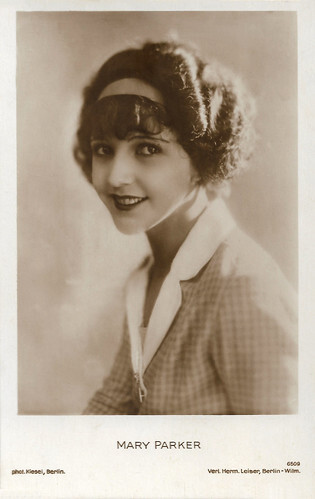
German postcard by Verlag Herm. Leiser, Berlin-Wilm., no. 6509. Phot: Kiesel, Berlin.
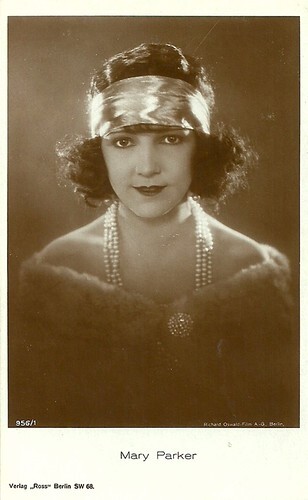
German postcard by Ross Verlag, Berlin, no. 956-1, 1925-1926. Photo: Richard Oswald-Film AG, Berlin.
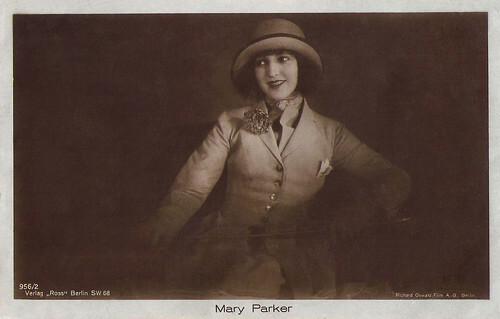
German postcard by Ross Verlag, Berlin, no. 956/2, 1925-1926. Photo: Richard Oswald-Film, Berlin.
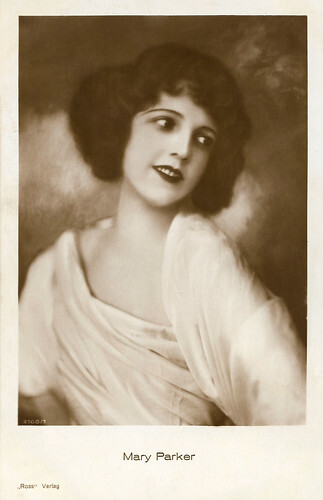
German postcard by Ross Verlag, Berlin, no. 3108/1, 1928-1929.
Sex education film about venereal disease
Mary Parker was born Magdalena Prohaska in Breslau (today Wroclaw), Poland, in 1902.
She debuted in German cinema in Die schönste Frau der Welt/The most beautiful woman in the world (Richard Eichberg, 1924) starring Lee Parry . Quickly several other films followed, such as the comedy Lumpen und Seide/Rags and silk (Richard Oswald, 1924), in which the rich Irene (Mary Parker) tries to refresh her marriage with Erik ( Johannes Riemann ) by taking a girl from the slums, Hilda, ( Mary Kid ) into their home. Hilda has a fiancee, Max, who is a shameless profiteer (Reinhold Schünzel).
Other memorable titles are Die Schmetterlingsschlacht/The Butterfly Battle (Franz Eckstein, 1924) starring Asta Nielsen , the Swiss production Das Paradies Europas. Bild vom Schweizer Volk und seinen Bergen/The Paradise of Europe. Image of the Swiss people and their mountains (Walther Zürn, 1924-1925), and Zaungäste des Lebens/Onlookers of life (Nikolai Malikoff, 1925) with Angelo Ferrari .
In Halbseide/Half silk (Richard Oswald, 1925), Parker had the female lead opposite Bernd Aldor as her husband. She also had a major part in the comedy Vorderhaus und Hinterhaus/Front house and back house (Richard Oswald, Carl Wilhelm, 1925) about a widower (Max Adalbert) who sublets a part of his house to the girl of his dreams (Parker) and her family.
For director Richard Oswald, Mary Parker also appeared in the sex education film Dürfen wir schweigen/Should We Be Silent? (Richard Oswald, 1926) about a painter ( Conrad Veidt ) who refuses to be treated for his venereal disease.
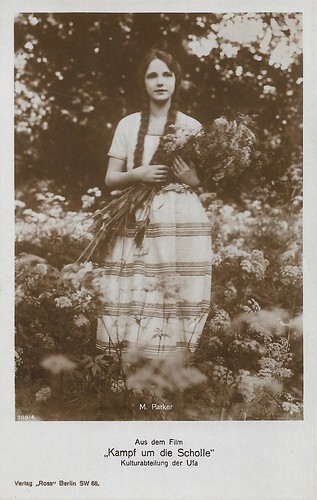
German postcard by Ross Verlag, no. 989/4, 1925-1926. Photo: Kulturabteilung der UFA. Mary Parker as Luise, daughter of the estate manager Karl Marten in Kampf um die Scholle/Struggle for the Soil (Erich Waschneck, 1925).
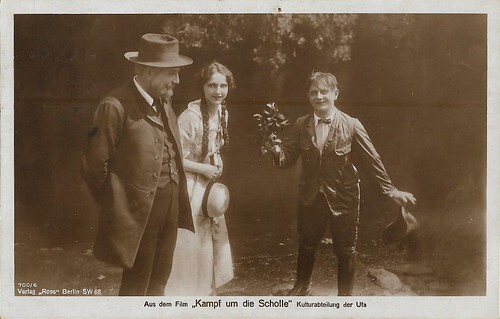
German postcard by Ross Verlag, no. 700/6. Photo: Ufa. Publicity still for Kampf um die Scholle/Struggle for the Soil (Erich Waschneck, 1925) with Otto Kronburger as Karl Merten, Mary Parker as his daughter Luise, and Hans Hermann (Schaufuss) as Gutseleve Fritz Quirlitz.
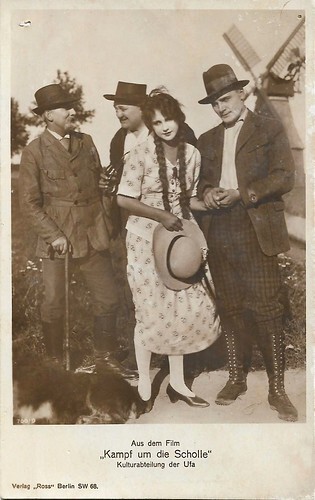
German postcard by Ross Verlag, no. 700/9. Photo: Ufa. Publicity still for Kampf um die Scholle/Struggle for the Soil (Erich Waschneck, 1925) with Oscar Marion as Franz, the younger brother of estate owner Axel, who has an affair with Luise (Mary Parker), daughter of the estate manager Karl Marten (left; Otto Kronburger). The man behind Parker is Wilhelm Diegelmann, who plays Uncle Uhl.
Just a few performances in German sound films
In the following years, Mary Parker also played in films like Ich hab mein Herz in Heidelberg verloren/I lost my heart in Heidelberg (Arthur Bergen, 1926), Das süsse Mädel/Das süße Mädel (Manfred Noa, 1926), the Danish film Dydsdragonen/The Dragon of Virtue (Valdemar Andersen, 1927), and Todessturz im Zirkus Cesarelli/Fatal fall in the Cesarelli Circus (Karoly Lajthay, 1927).
In 1928 Parker had the female leads in two films: Heut' war ich bei der Frieda/Today I was with Frieda (Siegfried Philippi, 1928), which title refers to the hit song of 1927, and the romantic comedy Wer das Scheiden hat erfunden/Who invented divorce (Wolfgang Neff, 1928) in which Parker played the Russian aristocrat Ljuba Pawlowa.
She had a supporting role in Saxophon-Susi/Suzy Saxophone (Karl Lamac, 1928) starring Anny Ondra . In 1929 Parker had the lead in the military comedy Fräulein Fähnrich/Miss Midshipman (Fred Sauer, 1929), playing opposite Willi Forst and Fritz Schulz . Her last silent role was in Ja, ja, die Frauen sind meine schwache Seite/Yes, yes, women are my weak side (Edmund Heuberger, 1929).
The year after she played in her first sound film, the Truus van Aalten comedy Susanne macht Ordnung/Susie Seeks Her Dad (Eugen Thiele, 1930). All in all Mary Parker did some 17 silent films, of which several together with Hans Albers (Halbseide, Vorderhaus und Hinterhaus, Wer das Scheiden hat erfunden, Saxophon-Susi, Heut' war ich bei der Frieda, and Ja, ja, die Frauen sind meine schwache Seite) and Mary Kid (Lumpen und Seide, Halbseide, Vorderhaus und Hinterhaus, Dydsdragonen).
Parker had just a few performances in German sound films. After Susanne macht Ordnung/Susie Seeks Her Dad (1930), she had a smaller part in Die unheimliche Geschichte/Ghastly Tales (1932) by her regular director Richard Oswald and a real bit part in the Anny Ondra vehicle Die Unwiderstehliche/The Irresistible Man (Geza von Bolvary, 1937) before she quitted altogether. It is not known when and where Mary Parker died.
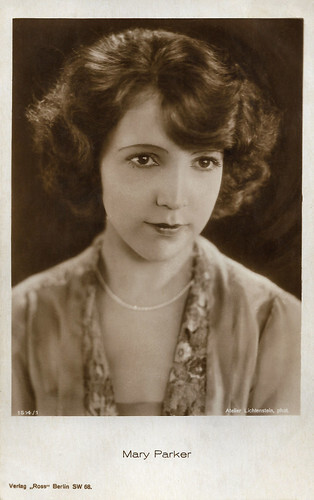
German postcard by Ross Verlag, Berlin, no. 1514/1, 1927-1928. Photo: Atelier Lichtenstein.
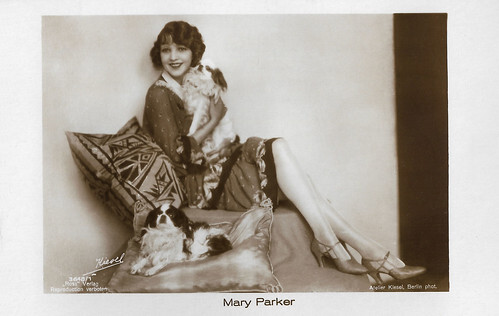
German postcard by Ross Verlag, Berlin, no. 3648/1, 1928-1929. Photo: Atelier Kiesel, Berlin.
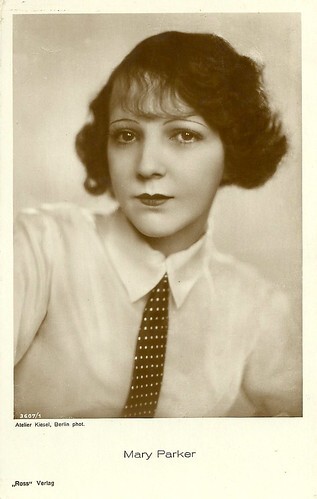
German postcard by Ross Verlag, Berlin, no. 3607/1, 1928-1929. Photo: Atelier Kiesel, Berlin.
Sources: Filmportal.de, Cyranos and .

German postcard by Verlag Herm. Leiser, Berlin-Wilm., no. 6509. Phot: Kiesel, Berlin.

German postcard by Ross Verlag, Berlin, no. 956-1, 1925-1926. Photo: Richard Oswald-Film AG, Berlin.

German postcard by Ross Verlag, Berlin, no. 956/2, 1925-1926. Photo: Richard Oswald-Film, Berlin.

German postcard by Ross Verlag, Berlin, no. 3108/1, 1928-1929.
Sex education film about venereal disease
Mary Parker was born Magdalena Prohaska in Breslau (today Wroclaw), Poland, in 1902.
She debuted in German cinema in Die schönste Frau der Welt/The most beautiful woman in the world (Richard Eichberg, 1924) starring Lee Parry . Quickly several other films followed, such as the comedy Lumpen und Seide/Rags and silk (Richard Oswald, 1924), in which the rich Irene (Mary Parker) tries to refresh her marriage with Erik ( Johannes Riemann ) by taking a girl from the slums, Hilda, ( Mary Kid ) into their home. Hilda has a fiancee, Max, who is a shameless profiteer (Reinhold Schünzel).
Other memorable titles are Die Schmetterlingsschlacht/The Butterfly Battle (Franz Eckstein, 1924) starring Asta Nielsen , the Swiss production Das Paradies Europas. Bild vom Schweizer Volk und seinen Bergen/The Paradise of Europe. Image of the Swiss people and their mountains (Walther Zürn, 1924-1925), and Zaungäste des Lebens/Onlookers of life (Nikolai Malikoff, 1925) with Angelo Ferrari .
In Halbseide/Half silk (Richard Oswald, 1925), Parker had the female lead opposite Bernd Aldor as her husband. She also had a major part in the comedy Vorderhaus und Hinterhaus/Front house and back house (Richard Oswald, Carl Wilhelm, 1925) about a widower (Max Adalbert) who sublets a part of his house to the girl of his dreams (Parker) and her family.
For director Richard Oswald, Mary Parker also appeared in the sex education film Dürfen wir schweigen/Should We Be Silent? (Richard Oswald, 1926) about a painter ( Conrad Veidt ) who refuses to be treated for his venereal disease.

German postcard by Ross Verlag, no. 989/4, 1925-1926. Photo: Kulturabteilung der UFA. Mary Parker as Luise, daughter of the estate manager Karl Marten in Kampf um die Scholle/Struggle for the Soil (Erich Waschneck, 1925).

German postcard by Ross Verlag, no. 700/6. Photo: Ufa. Publicity still for Kampf um die Scholle/Struggle for the Soil (Erich Waschneck, 1925) with Otto Kronburger as Karl Merten, Mary Parker as his daughter Luise, and Hans Hermann (Schaufuss) as Gutseleve Fritz Quirlitz.

German postcard by Ross Verlag, no. 700/9. Photo: Ufa. Publicity still for Kampf um die Scholle/Struggle for the Soil (Erich Waschneck, 1925) with Oscar Marion as Franz, the younger brother of estate owner Axel, who has an affair with Luise (Mary Parker), daughter of the estate manager Karl Marten (left; Otto Kronburger). The man behind Parker is Wilhelm Diegelmann, who plays Uncle Uhl.
Just a few performances in German sound films
In the following years, Mary Parker also played in films like Ich hab mein Herz in Heidelberg verloren/I lost my heart in Heidelberg (Arthur Bergen, 1926), Das süsse Mädel/Das süße Mädel (Manfred Noa, 1926), the Danish film Dydsdragonen/The Dragon of Virtue (Valdemar Andersen, 1927), and Todessturz im Zirkus Cesarelli/Fatal fall in the Cesarelli Circus (Karoly Lajthay, 1927).
In 1928 Parker had the female leads in two films: Heut' war ich bei der Frieda/Today I was with Frieda (Siegfried Philippi, 1928), which title refers to the hit song of 1927, and the romantic comedy Wer das Scheiden hat erfunden/Who invented divorce (Wolfgang Neff, 1928) in which Parker played the Russian aristocrat Ljuba Pawlowa.
She had a supporting role in Saxophon-Susi/Suzy Saxophone (Karl Lamac, 1928) starring Anny Ondra . In 1929 Parker had the lead in the military comedy Fräulein Fähnrich/Miss Midshipman (Fred Sauer, 1929), playing opposite Willi Forst and Fritz Schulz . Her last silent role was in Ja, ja, die Frauen sind meine schwache Seite/Yes, yes, women are my weak side (Edmund Heuberger, 1929).
The year after she played in her first sound film, the Truus van Aalten comedy Susanne macht Ordnung/Susie Seeks Her Dad (Eugen Thiele, 1930). All in all Mary Parker did some 17 silent films, of which several together with Hans Albers (Halbseide, Vorderhaus und Hinterhaus, Wer das Scheiden hat erfunden, Saxophon-Susi, Heut' war ich bei der Frieda, and Ja, ja, die Frauen sind meine schwache Seite) and Mary Kid (Lumpen und Seide, Halbseide, Vorderhaus und Hinterhaus, Dydsdragonen).
Parker had just a few performances in German sound films. After Susanne macht Ordnung/Susie Seeks Her Dad (1930), she had a smaller part in Die unheimliche Geschichte/Ghastly Tales (1932) by her regular director Richard Oswald and a real bit part in the Anny Ondra vehicle Die Unwiderstehliche/The Irresistible Man (Geza von Bolvary, 1937) before she quitted altogether. It is not known when and where Mary Parker died.

German postcard by Ross Verlag, Berlin, no. 1514/1, 1927-1928. Photo: Atelier Lichtenstein.

German postcard by Ross Verlag, Berlin, no. 3648/1, 1928-1929. Photo: Atelier Kiesel, Berlin.

German postcard by Ross Verlag, Berlin, no. 3607/1, 1928-1929. Photo: Atelier Kiesel, Berlin.
Sources: Filmportal.de, Cyranos and .
Published on April 08, 2023 22:00
April 7, 2023
Lew Ayres
American actor Lew Ayres (1908-1996) became famous for his leading role as Paul Bäumer in the classic film All Quiet on the Western Front (1930). This was followed by a distinguished film and television career spanning some 65 years. Ayres was nominated for an Academy Award for his performance in Johnny Belinda (1948).
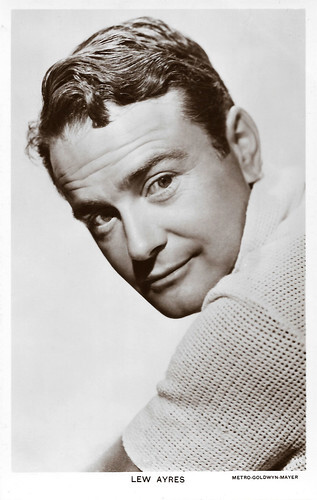
British postcard in the Picturegoer Series, London, no. 1339. Photo: Metro-Goldwyn-Mayer.
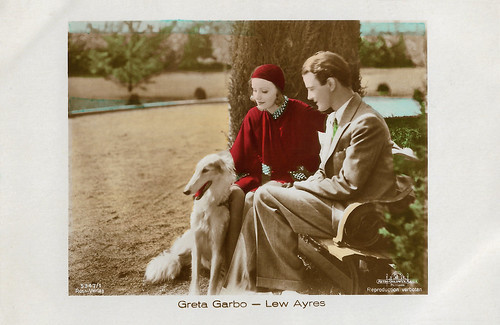
German postcard by Ross Verlag, no. 5347/1, 1930-1931. Photo: Metro-Goldwyn- Mayer. Greta Garbo and Lew Ayres in The Kiss (Jacques Feyder, 1929). Collection: Geoffrey Donaldson Institute.
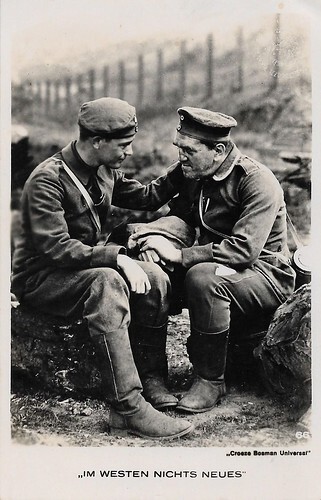
Dutch postcard by Croeze-Bosman-Universal, no. 66. Lew Ayres and Louis Wolheim in All Quiet on the Western Front (Lewis Milestone, 1930), based on the novel 'Im Westen nichts Neues by Erich Maria Remarque.
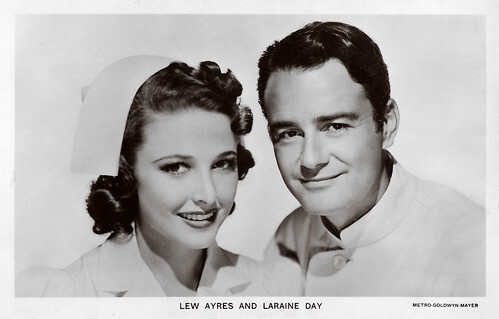
British postcard in the Picturegoer Series, London, no. P 301. Photo: Metro-Goldwyn-Mayer. Lew Ayres and Laraine Day in The Secret of Dr. Kildare (Harold S. Bucquet, 1939).
Failing to make the leap to top Hollywood stardom
Lewis 'Lew' Frederick Ayres III was born in 1908 in Minneapolis, Minnesota to Irma and Louis Ayres. His parents were musicians and they divorced when he was four years old. He was therefore brought up for several years by his grandmother Anna, a piano teacher. As a child, he wanted to be a doctor, but his grandmother discovered his musical talent. He played the banjo and saxophone as well as the guitar.
In 1923 he moved with his mother, step-father William Gilmore and half-brother and half-sister to San Diego, where he also attended high school. He interrupted high school for a short time to work as a musician. Later, after graduating, he studied medicine at the University of Arizona in 1926. He played banjo and guitar in the university's jazz band along the way.
Lew dropped out of medical school and went on to play in jazz bands in Californian nightclubs. He recorded one of the earliest Vitaphone movie shorts called Carnival Night in Paris (?, 1927). In the Coconut Grove nightclub in Los Angeles, Ayres was discovered by Hollywood agent Ivan Kahn dancing with actress Lili Damita .
After two minor roles, he first generated attention with his third film, the silent drama The Kiss (Jacques Feyder, 1929). He played a naive youth who gives Greta Garbo's character a kiss, causing complications. His fourth film, the anti-war film All Quiet on the Western Front (Lewis Milestone, 1930) made him world famous. He played the leading role of the German soldier Paul Bäumer. The film adaptation of Erich Maria Remarque's novel 'Im Westen nichts Neues' won the Oscar for best film of the year.
In Germany, the film met with bitter protest from right-wing associations and National Socialists, mainly because of its pacifist stance in the German Reich. Joseph Goebbels called for a boycott of the film and other films by the makers. Ayres, however, received much praise from the US press for his performance. In the following years, however, the boyish-looking actor failed to make the leap to top Hollywood stardom.
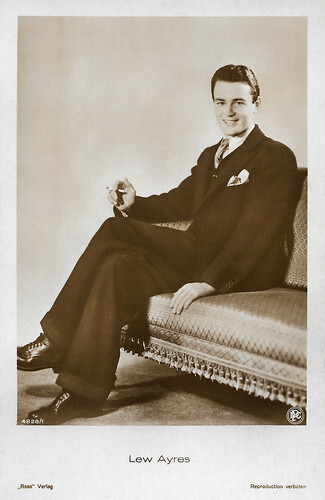
German postcard by Ross Verlag, no. 4828/1, 1929-1930. Photo: DPC.
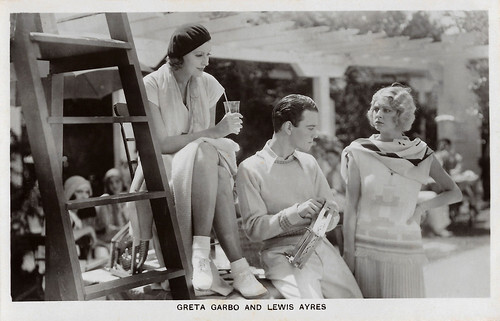
British postcard in the Picturegoer Series, London, no. 523. Greta Garbo and Lew Ayres in The Kiss (Jacques Feyder, 1929).
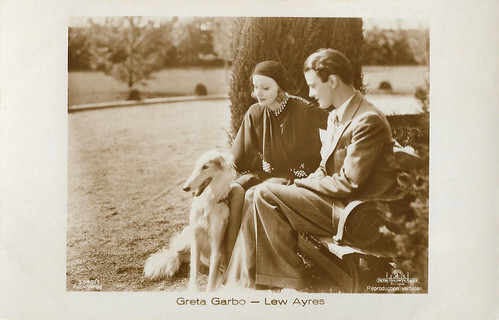
German postcard by Ross Verlag, no. 5347/1, 1930-1931. Photo: Metro Goldwyn Mayer. Greta Garbo and Lew Ayres in The Kiss (Jacques Feyder, 1929).
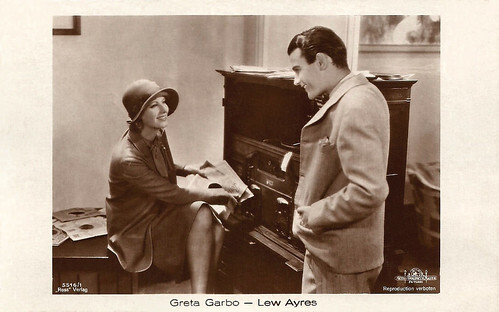
German postcard by Ross Verlag, no. 5516/1, 1930-1931. Photo: Metro Goldwyn Mayer. Greta Garbo and Lew Ayres in The Kiss (Jacques Feyder, 1929).
A good-natured, helpful and caring doctor
In the 1930s, Lew Ayres was confined to naive, somewhat spoiled young men from good homes in the vast majority of his roles. His more significant roles included an aspiring gangster in the crime film The Doorway to Hell (Archie Mayo, 1930) alongside James Cagney and a prizefighter in Iron Man (Tod Browning, 1931) who is abandoned by his lover, played by Jean Harlow .
In 1938 he again attracted attention when he played a tragicomic role in the screwball comedy Holiday (George Cukor, 1938). He played Katharine Hepburn's brother who suffers from his domineering father and drowns this in alcohol.
In the same year, Ayres got the role of Dr. Kildare in the B-movie Young Dr. Kildare (Harold S. Bucquet, 1938) at MGM. The film was such a success that Ayres portrayed the good-natured and helpful doctor in eight sequels until 1942. He also voiced Dr Kildare in a popular radio series in the 1940s.
During the Second World War, Ayres refused to go to war for the USA because he had become a pacifist, especially through his work on All Quiet on the Western Front. Public criticism arose of "the country's most famous conscientious objector" and MGM even released him from his contract because of it. His reputation was only restored when the public learned that he had worked as a medic for the US Army Medical Corps in New Guinea and the Philippines. Among other things, he was present at the evacuation in the Battle of Leyte.
After the war, Ayres resumed his film career, including a starring role alongside Olivia de Havilland in Robert Siodmak's thriller The Black Mirror (1946). In 1948, Ayres scored personal success alongside Jane Wyman in the drama Johnny Belinda (Jean Negulesco, 1948). The role of a sympathetic, caring doctor who looks after a deaf-mute woman earned him his only Oscar nomination in the Best Actor in a Leading Role category.
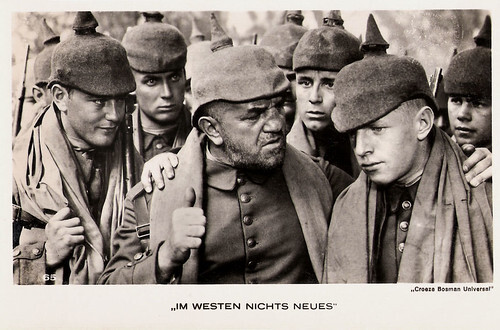
Dutch postcard by Croeze-Bosman-Universal, no. 65. Lew Ayres, Louis Wolheim and Owen Davis jr. in All Quiet on the Western Front (Lewis Milestone, 1930), based on the novel 'Im Westen nichts Neues by Erich Maria Remarque.
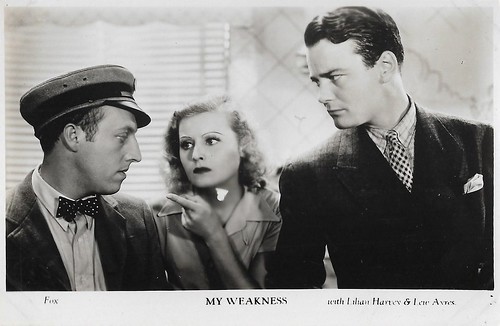
British postcard by Film Weekly. Photo: Fox. Lilian Harvey , Lew Ayres and Sid Silvers in My Weakness (David Butler, 1933).
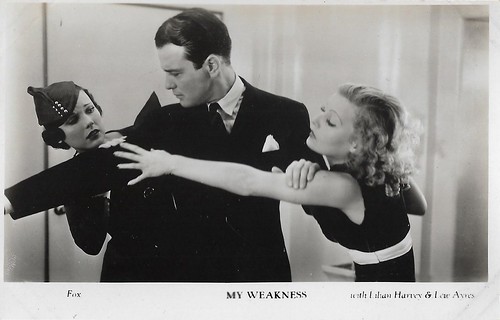
British postcard by Film Weekly. Photo: Fox. Lilian Harvey and Lew Ayres in the musical romance My Weakness (David Butler, 1933). The other woman could be Susan Fleming, Irene Bentley, or Irene Ware.
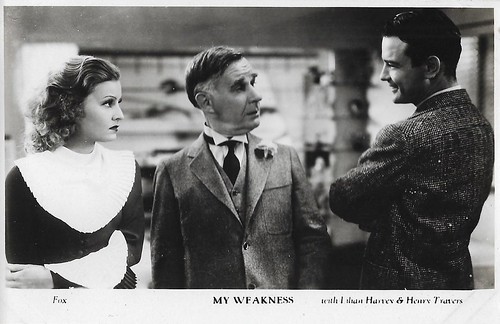
British postcard by Film Weekly. Photo: Fox. Lilian Harvey , Henry Travers and Lew Ayres in My Weakness (David Butler, 1933).
Buried next to Frank Zappa
In the 1950s, Lew Ayres took on mostly guest roles on television but offers for him dwindled overall. His career took off again in the 1970s and 1980s. He took supporting roles in films such as the Science-Fiction film Battle for the Planet of the Apes (J. Lee Thompson, 1973), the Horror film Damien – Omen II (Don Taylor, 1978) with William Holden , and the Italian remake Don Camillo (Terence Hill, 1983) with Terence Hill as small-town priest Don Camillo.
The now greying Ayres played mostly understanding and friendly authority figures such as presidents, doctors and professors. He also appeared on television in series such as Little House on the Prairie (1982), Fame (1984) and The A-Team (1986). In the Columbo episode Devilish Intelligence (1974), he played a scientist of integrity who is murdered when he tries to uncover a scandal.
For a guest role opposite David Carradine in an episode of the TV series Kung Fu, The Vanishing Image (Barry Crane, 1974), he was nominated for an Emmy. In 1994, Ayres retired from the screen for good after over 150 film and television appearances with his appearance in the television film Hart to Hart: Secrets of the Hart (Peter Roger Hunt, 1994) starring Robert Wagner and Stefanie Powers.
Ayres directed the historical war drama Hearts in Bondage (Lew Ayres, 1936), starring Mae Clarke and David Manners, for Republic. Hearts in Bondage is notable as a rare example of a Hollywood film to depict the naval battles of the American Civil War. It remained his only directorial effort on a feature film. He later made two more documentaries: Altars of the East (1955) and Altars of the World (1976), both of which were devoted to the theme of religion. Altars of the World, his 150-minute documentary on the different religions of the world, won critical acclaim and the 1977 Golden Globe in the Best Documentary category.
Lew Ayres was married three times: first to actress Lola Lane between 1931 and 1933 and to Ginger Rogers from 1934 to 1940. In the late 1940s, he began a relationship with actress Jane Wyman, who left her then-husband Ronald Reagan for him. Wyman and Ayres broke up again after only a short time. He had one son, Justin Ayres, by his last marriage to Diana Hall, which lasted from 1964 until his death. The actor was very interested in philosophy and religion, lectured on these subjects and wrote numerous essays. He received an honorary doctorate from Oakland University in 1979 for his philosophical activities. Lew Ayres passed away in Los Angeles in 1996, two days after his 88th birthday. He died in his sleep after being in a coma for several days. Lew Ayres was buried in Westwood Village Memorial Park Cemetery in Westwood next to Frank Zappa.
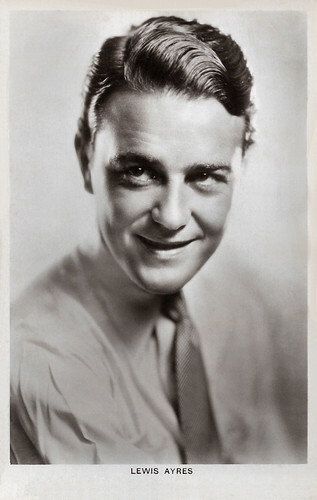
British postcard in the Picturegoer Series, London, no. 454.
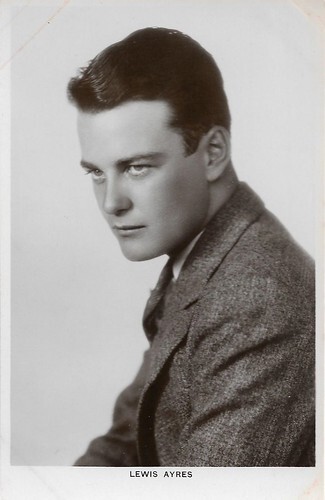
British postcard in the Picturegoer Series, London, no. 454a.
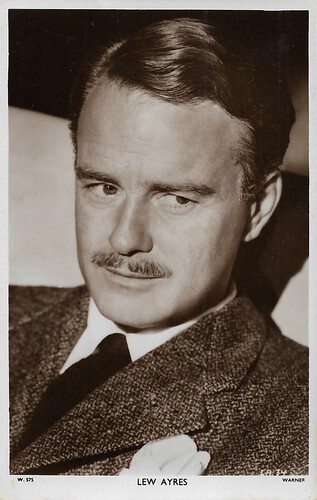
British postcard in the Picturegoer Series, no. W.575. Photo: Warner.
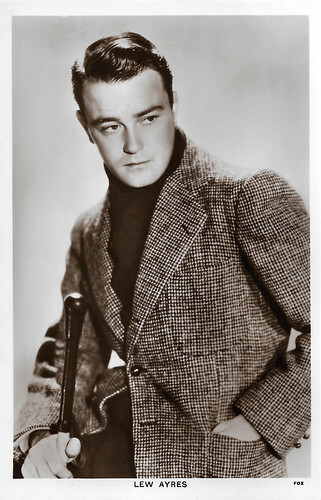
British postcard in the Picturegoer Series, London, no. 870. Photo: Fox.
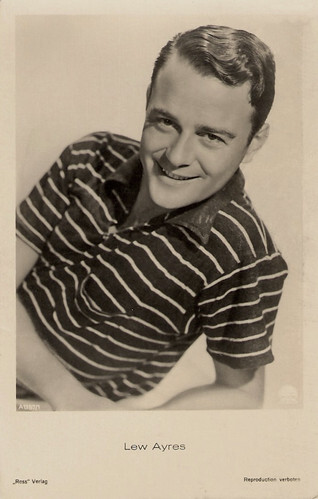
German postcard by Ross Verlag, no. A 1397/1, 1937-1938. Photo: Paramount.
Sources: (IMDb), Wikipedia (German and English), and .

British postcard in the Picturegoer Series, London, no. 1339. Photo: Metro-Goldwyn-Mayer.

German postcard by Ross Verlag, no. 5347/1, 1930-1931. Photo: Metro-Goldwyn- Mayer. Greta Garbo and Lew Ayres in The Kiss (Jacques Feyder, 1929). Collection: Geoffrey Donaldson Institute.

Dutch postcard by Croeze-Bosman-Universal, no. 66. Lew Ayres and Louis Wolheim in All Quiet on the Western Front (Lewis Milestone, 1930), based on the novel 'Im Westen nichts Neues by Erich Maria Remarque.

British postcard in the Picturegoer Series, London, no. P 301. Photo: Metro-Goldwyn-Mayer. Lew Ayres and Laraine Day in The Secret of Dr. Kildare (Harold S. Bucquet, 1939).
Failing to make the leap to top Hollywood stardom
Lewis 'Lew' Frederick Ayres III was born in 1908 in Minneapolis, Minnesota to Irma and Louis Ayres. His parents were musicians and they divorced when he was four years old. He was therefore brought up for several years by his grandmother Anna, a piano teacher. As a child, he wanted to be a doctor, but his grandmother discovered his musical talent. He played the banjo and saxophone as well as the guitar.
In 1923 he moved with his mother, step-father William Gilmore and half-brother and half-sister to San Diego, where he also attended high school. He interrupted high school for a short time to work as a musician. Later, after graduating, he studied medicine at the University of Arizona in 1926. He played banjo and guitar in the university's jazz band along the way.
Lew dropped out of medical school and went on to play in jazz bands in Californian nightclubs. He recorded one of the earliest Vitaphone movie shorts called Carnival Night in Paris (?, 1927). In the Coconut Grove nightclub in Los Angeles, Ayres was discovered by Hollywood agent Ivan Kahn dancing with actress Lili Damita .
After two minor roles, he first generated attention with his third film, the silent drama The Kiss (Jacques Feyder, 1929). He played a naive youth who gives Greta Garbo's character a kiss, causing complications. His fourth film, the anti-war film All Quiet on the Western Front (Lewis Milestone, 1930) made him world famous. He played the leading role of the German soldier Paul Bäumer. The film adaptation of Erich Maria Remarque's novel 'Im Westen nichts Neues' won the Oscar for best film of the year.
In Germany, the film met with bitter protest from right-wing associations and National Socialists, mainly because of its pacifist stance in the German Reich. Joseph Goebbels called for a boycott of the film and other films by the makers. Ayres, however, received much praise from the US press for his performance. In the following years, however, the boyish-looking actor failed to make the leap to top Hollywood stardom.

German postcard by Ross Verlag, no. 4828/1, 1929-1930. Photo: DPC.

British postcard in the Picturegoer Series, London, no. 523. Greta Garbo and Lew Ayres in The Kiss (Jacques Feyder, 1929).

German postcard by Ross Verlag, no. 5347/1, 1930-1931. Photo: Metro Goldwyn Mayer. Greta Garbo and Lew Ayres in The Kiss (Jacques Feyder, 1929).

German postcard by Ross Verlag, no. 5516/1, 1930-1931. Photo: Metro Goldwyn Mayer. Greta Garbo and Lew Ayres in The Kiss (Jacques Feyder, 1929).
A good-natured, helpful and caring doctor
In the 1930s, Lew Ayres was confined to naive, somewhat spoiled young men from good homes in the vast majority of his roles. His more significant roles included an aspiring gangster in the crime film The Doorway to Hell (Archie Mayo, 1930) alongside James Cagney and a prizefighter in Iron Man (Tod Browning, 1931) who is abandoned by his lover, played by Jean Harlow .
In 1938 he again attracted attention when he played a tragicomic role in the screwball comedy Holiday (George Cukor, 1938). He played Katharine Hepburn's brother who suffers from his domineering father and drowns this in alcohol.
In the same year, Ayres got the role of Dr. Kildare in the B-movie Young Dr. Kildare (Harold S. Bucquet, 1938) at MGM. The film was such a success that Ayres portrayed the good-natured and helpful doctor in eight sequels until 1942. He also voiced Dr Kildare in a popular radio series in the 1940s.
During the Second World War, Ayres refused to go to war for the USA because he had become a pacifist, especially through his work on All Quiet on the Western Front. Public criticism arose of "the country's most famous conscientious objector" and MGM even released him from his contract because of it. His reputation was only restored when the public learned that he had worked as a medic for the US Army Medical Corps in New Guinea and the Philippines. Among other things, he was present at the evacuation in the Battle of Leyte.
After the war, Ayres resumed his film career, including a starring role alongside Olivia de Havilland in Robert Siodmak's thriller The Black Mirror (1946). In 1948, Ayres scored personal success alongside Jane Wyman in the drama Johnny Belinda (Jean Negulesco, 1948). The role of a sympathetic, caring doctor who looks after a deaf-mute woman earned him his only Oscar nomination in the Best Actor in a Leading Role category.

Dutch postcard by Croeze-Bosman-Universal, no. 65. Lew Ayres, Louis Wolheim and Owen Davis jr. in All Quiet on the Western Front (Lewis Milestone, 1930), based on the novel 'Im Westen nichts Neues by Erich Maria Remarque.

British postcard by Film Weekly. Photo: Fox. Lilian Harvey , Lew Ayres and Sid Silvers in My Weakness (David Butler, 1933).

British postcard by Film Weekly. Photo: Fox. Lilian Harvey and Lew Ayres in the musical romance My Weakness (David Butler, 1933). The other woman could be Susan Fleming, Irene Bentley, or Irene Ware.

British postcard by Film Weekly. Photo: Fox. Lilian Harvey , Henry Travers and Lew Ayres in My Weakness (David Butler, 1933).
Buried next to Frank Zappa
In the 1950s, Lew Ayres took on mostly guest roles on television but offers for him dwindled overall. His career took off again in the 1970s and 1980s. He took supporting roles in films such as the Science-Fiction film Battle for the Planet of the Apes (J. Lee Thompson, 1973), the Horror film Damien – Omen II (Don Taylor, 1978) with William Holden , and the Italian remake Don Camillo (Terence Hill, 1983) with Terence Hill as small-town priest Don Camillo.
The now greying Ayres played mostly understanding and friendly authority figures such as presidents, doctors and professors. He also appeared on television in series such as Little House on the Prairie (1982), Fame (1984) and The A-Team (1986). In the Columbo episode Devilish Intelligence (1974), he played a scientist of integrity who is murdered when he tries to uncover a scandal.
For a guest role opposite David Carradine in an episode of the TV series Kung Fu, The Vanishing Image (Barry Crane, 1974), he was nominated for an Emmy. In 1994, Ayres retired from the screen for good after over 150 film and television appearances with his appearance in the television film Hart to Hart: Secrets of the Hart (Peter Roger Hunt, 1994) starring Robert Wagner and Stefanie Powers.
Ayres directed the historical war drama Hearts in Bondage (Lew Ayres, 1936), starring Mae Clarke and David Manners, for Republic. Hearts in Bondage is notable as a rare example of a Hollywood film to depict the naval battles of the American Civil War. It remained his only directorial effort on a feature film. He later made two more documentaries: Altars of the East (1955) and Altars of the World (1976), both of which were devoted to the theme of religion. Altars of the World, his 150-minute documentary on the different religions of the world, won critical acclaim and the 1977 Golden Globe in the Best Documentary category.
Lew Ayres was married three times: first to actress Lola Lane between 1931 and 1933 and to Ginger Rogers from 1934 to 1940. In the late 1940s, he began a relationship with actress Jane Wyman, who left her then-husband Ronald Reagan for him. Wyman and Ayres broke up again after only a short time. He had one son, Justin Ayres, by his last marriage to Diana Hall, which lasted from 1964 until his death. The actor was very interested in philosophy and religion, lectured on these subjects and wrote numerous essays. He received an honorary doctorate from Oakland University in 1979 for his philosophical activities. Lew Ayres passed away in Los Angeles in 1996, two days after his 88th birthday. He died in his sleep after being in a coma for several days. Lew Ayres was buried in Westwood Village Memorial Park Cemetery in Westwood next to Frank Zappa.

British postcard in the Picturegoer Series, London, no. 454.

British postcard in the Picturegoer Series, London, no. 454a.

British postcard in the Picturegoer Series, no. W.575. Photo: Warner.

British postcard in the Picturegoer Series, London, no. 870. Photo: Fox.

German postcard by Ross Verlag, no. A 1397/1, 1937-1938. Photo: Paramount.
Sources: (IMDb), Wikipedia (German and English), and .
Published on April 07, 2023 22:00
April 6, 2023
Sabine Peters
Sabine Peters (1913-1982) was a fresh-faced German theatre and film actress. During the 1930s, she played supporting and occasional leading roles in several mainstream romances and comedies for the Ufa. For Carl Froelich, she played a young student in two films but she had her breakthrough as the selfish and jealous daughter of Lil Dagover in Das Mädchen Irene/The Girl Irene (1936).
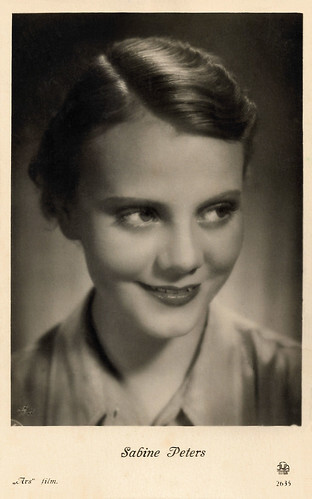
Latvian postcard by JDA, Riga, no. 2635. Photo: Ars Film.
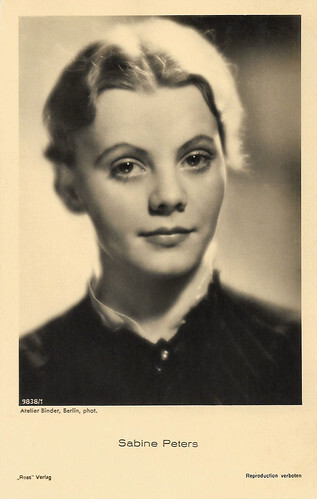
German postcard by Ross Verlag, no. 9838/1, 1935-1936. Photo: Atelier Binder, Berlin.
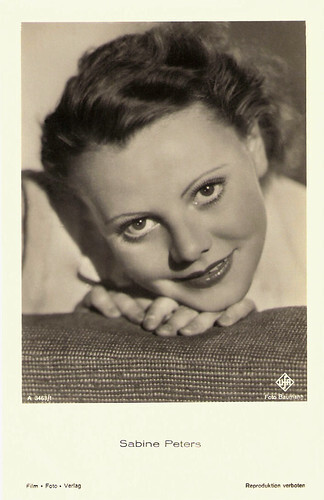
German postcard by Film-Foto-Verlag, no. A 3463/1, 1941-1944. Photo: Baumann / Ufa.
Eight school girls in a boat
Sabine Peters was born in 1913 in Berlin. The merchant's daughter studied acting with Ilka Grüning. After her studies, she was accepted directly into the ensemble of Agnes Straub at the Berliner Theater am Kurfürstendamm, where she played ingénue roles until 1938.
In that year she also made her film debut as one of the eight school girls in the musical drama Acht Mädels im Boot/Eight Girls in a Boat (Erich Waschneck, 1932) starring Karin Hardt and Theodor Loos .
In the following year, she already played at the side of important actors of that time as Heinrich George , Hertha Thiele and Albert Lieven in the drama Reifende Jugend/Ripening Youth (Carl Froelich, 1933).
She played one of three girls who start at an elite school in Lübeck. The film was inspired by the earlier German romantic drama and cult classic Madchen in Uniform/Girls in Uniform (Leontine Sagan, 1931) also with Thiele and with artistic direction from Carl Froelich, who also funded that film.
The actor and director Fritz Kampers then engaged Peters for the Bavarian comedy Konjunkturritter/Knights of the Economy (Fritz Kampers, 1934) with the famous German folk actor Weiß Ferdl.
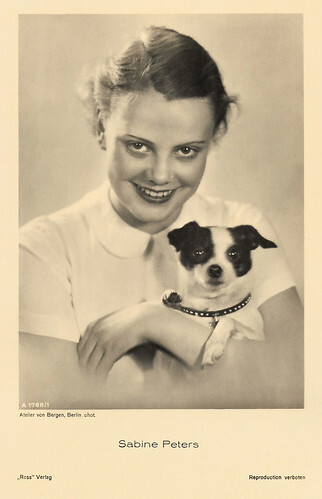
German postcard by Ross Verlag, no. A 1788/1, 1937-1938. Photo: Atelier von Bergen, Berlin.
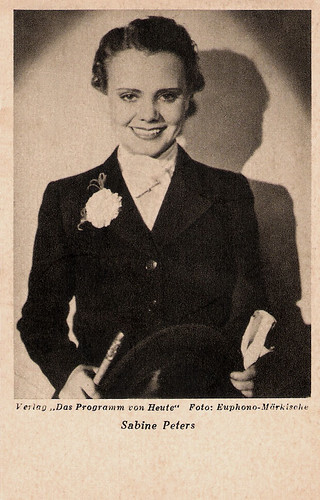
German postcard by Das Programm von Heute, Berlin. Photo: Euphono-Märkische. Sabine Peters in Unter Ausschluß der Öffentlichkeit/In the public eye (Paul Wegener, 1937).
A selfish and jealous young girl
Sabine Peters had her breakthrough with Geraldine Katt and Lil Dagover in the Ufa problem film Das Mädchen Irene/The Girl Irene (Reinhold Schünzel, 1936). She played Irene, a selfish and jealous young girl who tries to prevent the remarriage of her attractive mother by all means.
Familiar with classical roles on the stage, she appeared with Heinrich George , Ida Wüst and Rotraut Richter in Der Biberpelz/The Beaver Coat (Jürgen von Alten, 1937), the film adaptation of Gerhart Hauptmann's stage comedy 'Der Biberpelz'.
In 1938 followed the comedy Rätsel um Beate/Mystery around Beate (Johannes Meyer, 1938), again with Lil Dagover and also with Albrecht Schoenhals . She was again a student in the drama Die vier Gesellen/The Four Companions (Carl Froelich, 1938), starring Ingrid Bergman . The film was intended as a star vehicle to launch Bergman's career in Germany following her success in several Swedish films.
Sabine Peters married the opera singer Willi Domgraf-Fassbaender . From this marriage came their daughter Brigitte Fassbaender, born in 1939, who later became an important mezzo-soprano. After 1945 Sabine Peters performed mainly at the theatre. Her last role was a small part in the television film Die Weber/The Weavers (Fritz Umgelter, 1980, an adaptation of the stage play by Gerhart Hauptmann.
Sabine Peters passed away in 1982 in München (Munich), Germany.
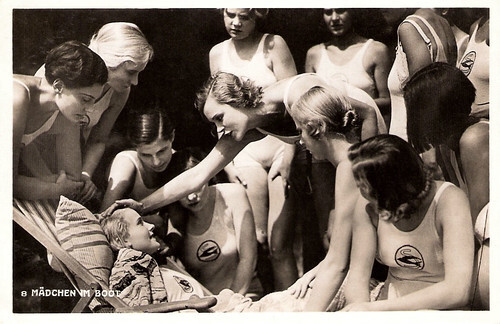
Dutch postcard by JosPe. Photo: still from Acht Mädels im Boot/Eight Girls in a Boat (Erich Waschneck, 1932).
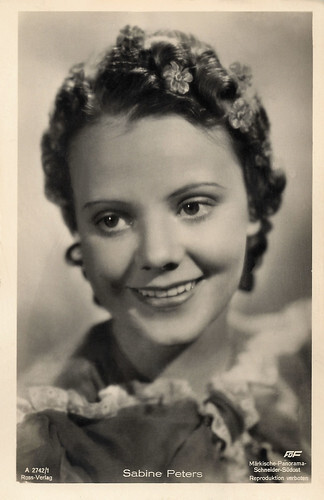
German postcard by Ross Verlag, no. A 2742/1, 1939-1940. Photo: FDF / Märkische-Panorama-Schneider-Südost.
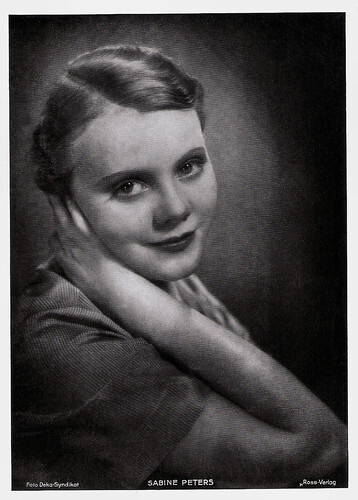
Big German card by Ross Verlag. Photo: Deka-Syndikat.
Sources: Wikipedia (German and English) and .

Latvian postcard by JDA, Riga, no. 2635. Photo: Ars Film.

German postcard by Ross Verlag, no. 9838/1, 1935-1936. Photo: Atelier Binder, Berlin.

German postcard by Film-Foto-Verlag, no. A 3463/1, 1941-1944. Photo: Baumann / Ufa.
Eight school girls in a boat
Sabine Peters was born in 1913 in Berlin. The merchant's daughter studied acting with Ilka Grüning. After her studies, she was accepted directly into the ensemble of Agnes Straub at the Berliner Theater am Kurfürstendamm, where she played ingénue roles until 1938.
In that year she also made her film debut as one of the eight school girls in the musical drama Acht Mädels im Boot/Eight Girls in a Boat (Erich Waschneck, 1932) starring Karin Hardt and Theodor Loos .
In the following year, she already played at the side of important actors of that time as Heinrich George , Hertha Thiele and Albert Lieven in the drama Reifende Jugend/Ripening Youth (Carl Froelich, 1933).
She played one of three girls who start at an elite school in Lübeck. The film was inspired by the earlier German romantic drama and cult classic Madchen in Uniform/Girls in Uniform (Leontine Sagan, 1931) also with Thiele and with artistic direction from Carl Froelich, who also funded that film.
The actor and director Fritz Kampers then engaged Peters for the Bavarian comedy Konjunkturritter/Knights of the Economy (Fritz Kampers, 1934) with the famous German folk actor Weiß Ferdl.

German postcard by Ross Verlag, no. A 1788/1, 1937-1938. Photo: Atelier von Bergen, Berlin.

German postcard by Das Programm von Heute, Berlin. Photo: Euphono-Märkische. Sabine Peters in Unter Ausschluß der Öffentlichkeit/In the public eye (Paul Wegener, 1937).
A selfish and jealous young girl
Sabine Peters had her breakthrough with Geraldine Katt and Lil Dagover in the Ufa problem film Das Mädchen Irene/The Girl Irene (Reinhold Schünzel, 1936). She played Irene, a selfish and jealous young girl who tries to prevent the remarriage of her attractive mother by all means.
Familiar with classical roles on the stage, she appeared with Heinrich George , Ida Wüst and Rotraut Richter in Der Biberpelz/The Beaver Coat (Jürgen von Alten, 1937), the film adaptation of Gerhart Hauptmann's stage comedy 'Der Biberpelz'.
In 1938 followed the comedy Rätsel um Beate/Mystery around Beate (Johannes Meyer, 1938), again with Lil Dagover and also with Albrecht Schoenhals . She was again a student in the drama Die vier Gesellen/The Four Companions (Carl Froelich, 1938), starring Ingrid Bergman . The film was intended as a star vehicle to launch Bergman's career in Germany following her success in several Swedish films.
Sabine Peters married the opera singer Willi Domgraf-Fassbaender . From this marriage came their daughter Brigitte Fassbaender, born in 1939, who later became an important mezzo-soprano. After 1945 Sabine Peters performed mainly at the theatre. Her last role was a small part in the television film Die Weber/The Weavers (Fritz Umgelter, 1980, an adaptation of the stage play by Gerhart Hauptmann.
Sabine Peters passed away in 1982 in München (Munich), Germany.

Dutch postcard by JosPe. Photo: still from Acht Mädels im Boot/Eight Girls in a Boat (Erich Waschneck, 1932).

German postcard by Ross Verlag, no. A 2742/1, 1939-1940. Photo: FDF / Märkische-Panorama-Schneider-Südost.

Big German card by Ross Verlag. Photo: Deka-Syndikat.
Sources: Wikipedia (German and English) and .
Published on April 06, 2023 22:00
Paul van Yperen's Blog
- Paul van Yperen's profile
- 13 followers
Paul van Yperen isn't a Goodreads Author
(yet),
but they
do have a blog,
so here are some recent posts imported from
their feed.



